Quick filters:
Nuremberg chronicle book Stock Photos and Images
 Germany: 'The Dance of Death'. The Nuremberg Chronicle, by Hartmann Schedel (1440-1514), 1493. The Nuremberg Chronicle is an illustrated world history. Its structure follows the story of human history as related in the Bible, including the histories of a number of important Western cities. Written in Latin by Hartmann Schedel, with a version in German translation by Georg Alt, it appeared in 1493. It is one of the best-documented early printed books. It is classified as an incunabulum, a book, pamphlet, or broadside that was printed (not handwritten) before the year 1501 in Europe. Stock Photohttps://www.alamy.com/image-license-details/?v=1https://www.alamy.com/germany-the-dance-of-death-the-nuremberg-chronicle-by-hartmann-schedel-1440-1514-1493-the-nuremberg-chronicle-is-an-illustrated-world-history-its-structure-follows-the-story-of-human-history-as-related-in-the-bible-including-the-histories-of-a-number-of-important-western-cities-written-in-latin-by-hartmann-schedel-with-a-version-in-german-translation-by-georg-alt-it-appeared-in-1493-it-is-one-of-the-best-documented-early-printed-books-it-is-classified-as-an-incunabulum-a-book-pamphlet-or-broadside-that-was-printed-not-handwritten-before-the-year-1501-in-europe-image344224274.html
Germany: 'The Dance of Death'. The Nuremberg Chronicle, by Hartmann Schedel (1440-1514), 1493. The Nuremberg Chronicle is an illustrated world history. Its structure follows the story of human history as related in the Bible, including the histories of a number of important Western cities. Written in Latin by Hartmann Schedel, with a version in German translation by Georg Alt, it appeared in 1493. It is one of the best-documented early printed books. It is classified as an incunabulum, a book, pamphlet, or broadside that was printed (not handwritten) before the year 1501 in Europe. Stock Photohttps://www.alamy.com/image-license-details/?v=1https://www.alamy.com/germany-the-dance-of-death-the-nuremberg-chronicle-by-hartmann-schedel-1440-1514-1493-the-nuremberg-chronicle-is-an-illustrated-world-history-its-structure-follows-the-story-of-human-history-as-related-in-the-bible-including-the-histories-of-a-number-of-important-western-cities-written-in-latin-by-hartmann-schedel-with-a-version-in-german-translation-by-georg-alt-it-appeared-in-1493-it-is-one-of-the-best-documented-early-printed-books-it-is-classified-as-an-incunabulum-a-book-pamphlet-or-broadside-that-was-printed-not-handwritten-before-the-year-1501-in-europe-image344224274.htmlRM2B00NG2–Germany: 'The Dance of Death'. The Nuremberg Chronicle, by Hartmann Schedel (1440-1514), 1493. The Nuremberg Chronicle is an illustrated world history. Its structure follows the story of human history as related in the Bible, including the histories of a number of important Western cities. Written in Latin by Hartmann Schedel, with a version in German translation by Georg Alt, it appeared in 1493. It is one of the best-documented early printed books. It is classified as an incunabulum, a book, pamphlet, or broadside that was printed (not handwritten) before the year 1501 in Europe.
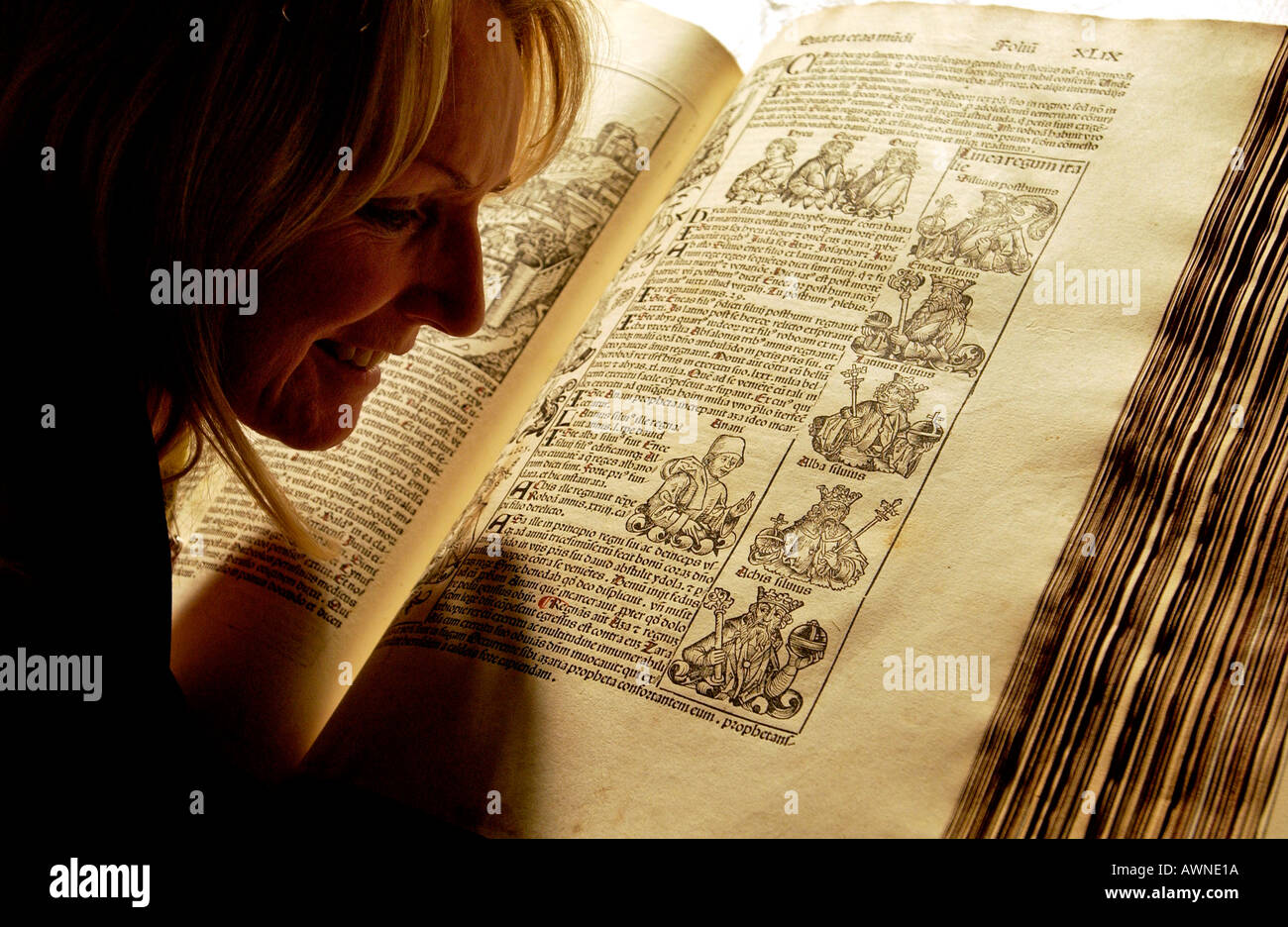 A woman librarian examines an ancient book The Nuremberg Chronicle from 1493 in Brighton Library's rare book section Stock Photohttps://www.alamy.com/image-license-details/?v=1https://www.alamy.com/a-woman-librarian-examines-an-ancient-book-the-nuremberg-chronicle-image3087897.html
A woman librarian examines an ancient book The Nuremberg Chronicle from 1493 in Brighton Library's rare book section Stock Photohttps://www.alamy.com/image-license-details/?v=1https://www.alamy.com/a-woman-librarian-examines-an-ancient-book-the-nuremberg-chronicle-image3087897.htmlRMAWNE1A–A woman librarian examines an ancient book The Nuremberg Chronicle from 1493 in Brighton Library's rare book section
 Nuremberg Chronicle. German version, December 23, 1493. Engraving depicting the city of Nuremberg. German Historical Museum. Stock Photohttps://www.alamy.com/image-license-details/?v=1https://www.alamy.com/stock-photo-nuremberg-chronicle-german-version-december-23-1493-engraving-depicting-50560075.html
Nuremberg Chronicle. German version, December 23, 1493. Engraving depicting the city of Nuremberg. German Historical Museum. Stock Photohttps://www.alamy.com/image-license-details/?v=1https://www.alamy.com/stock-photo-nuremberg-chronicle-german-version-december-23-1493-engraving-depicting-50560075.htmlRMCX75TY–Nuremberg Chronicle. German version, December 23, 1493. Engraving depicting the city of Nuremberg. German Historical Museum.
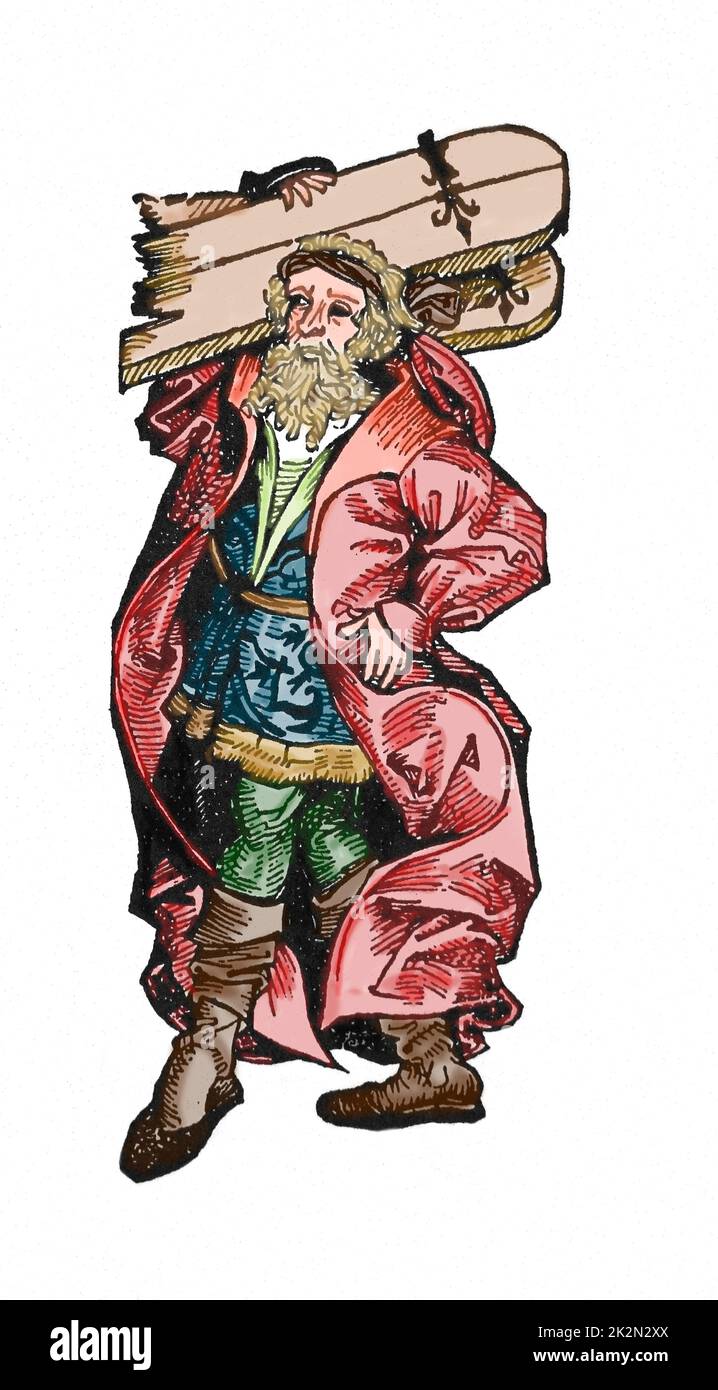 Samson. Last of the judges of the ancient Israelites mentioned in the Book of Judges. Engraving. The Nuremberg Chronicle. 15th century. Stock Photohttps://www.alamy.com/image-license-details/?v=1https://www.alamy.com/samson-last-of-the-judges-of-the-ancient-israelites-mentioned-in-the-book-of-judges-engraving-the-nuremberg-chronicle-15th-century-image483582930.html
Samson. Last of the judges of the ancient Israelites mentioned in the Book of Judges. Engraving. The Nuremberg Chronicle. 15th century. Stock Photohttps://www.alamy.com/image-license-details/?v=1https://www.alamy.com/samson-last-of-the-judges-of-the-ancient-israelites-mentioned-in-the-book-of-judges-engraving-the-nuremberg-chronicle-15th-century-image483582930.htmlRM2K2N2XX–Samson. Last of the judges of the ancient Israelites mentioned in the Book of Judges. Engraving. The Nuremberg Chronicle. 15th century.
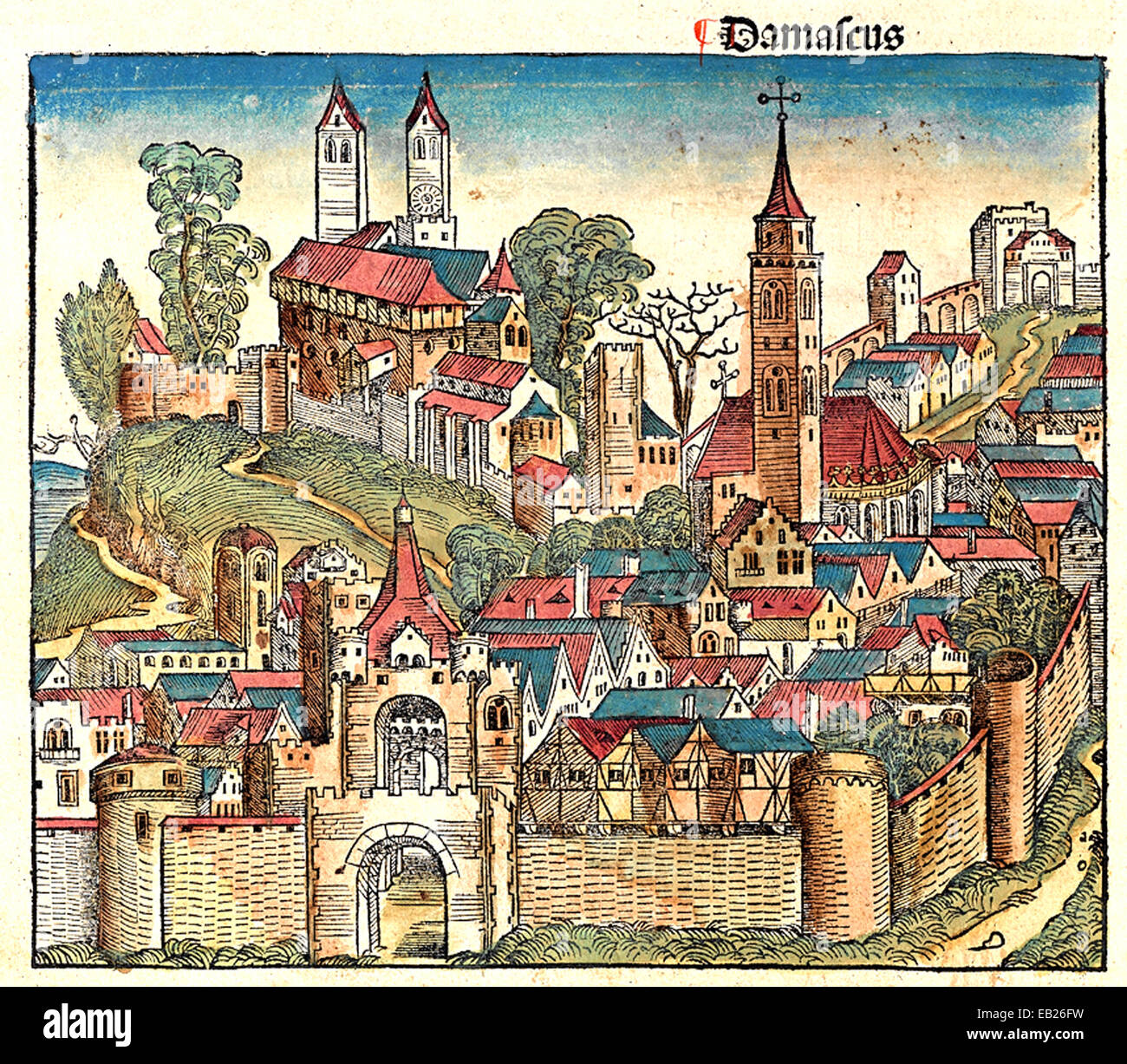 NUREMBERG CHRONICLE 1493 - Damascus as shown in the book Stock Photohttps://www.alamy.com/image-license-details/?v=1https://www.alamy.com/stock-photo-nuremberg-chronicle-1493-damascus-as-shown-in-the-book-75651741.html
NUREMBERG CHRONICLE 1493 - Damascus as shown in the book Stock Photohttps://www.alamy.com/image-license-details/?v=1https://www.alamy.com/stock-photo-nuremberg-chronicle-1493-damascus-as-shown-in-the-book-75651741.htmlRMEB26FW–NUREMBERG CHRONICLE 1493 - Damascus as shown in the book
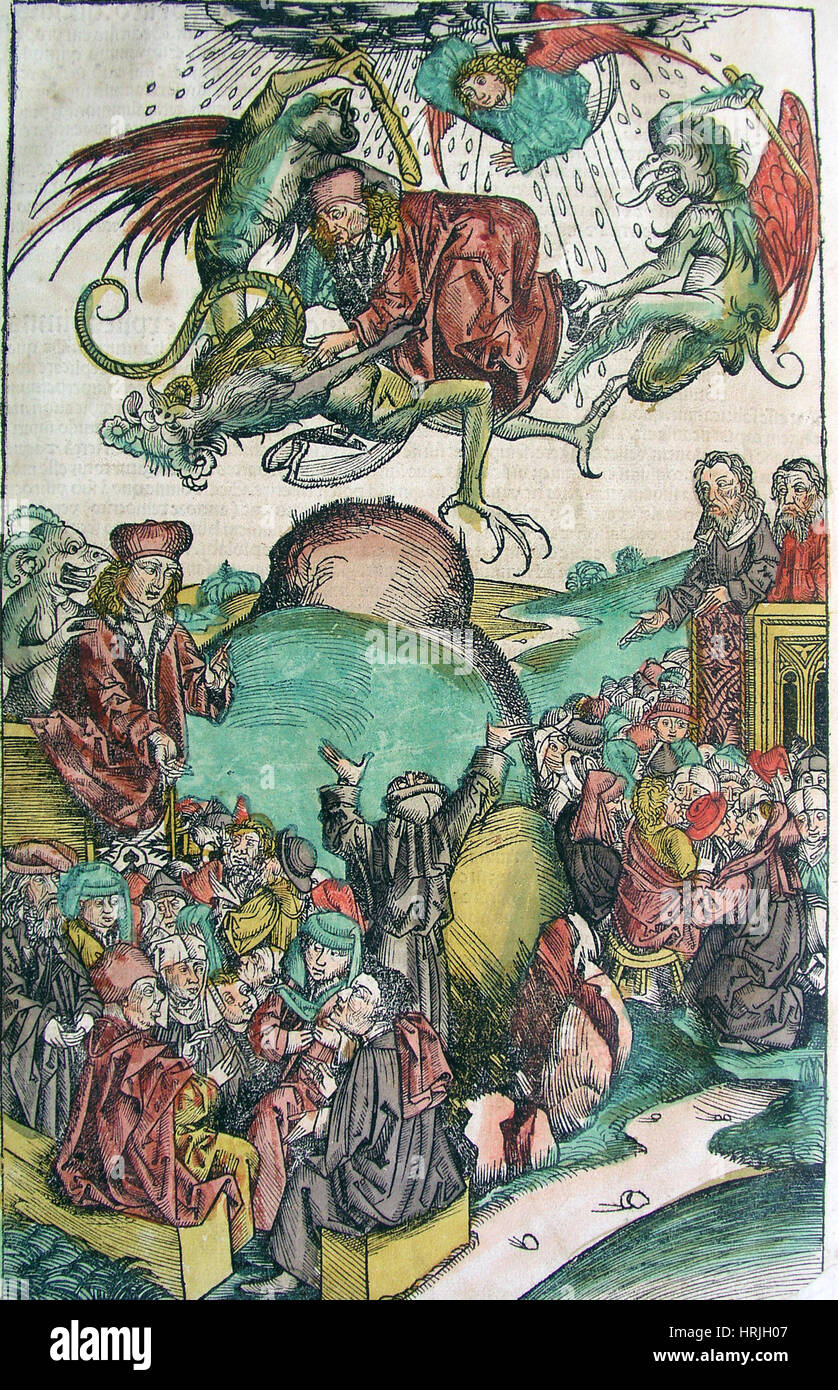 Apocalypse, Nuremberg Chronicle, 1493 Stock Photohttps://www.alamy.com/image-license-details/?v=1https://www.alamy.com/stock-photo-apocalypse-nuremberg-chronicle-1493-135018135.html
Apocalypse, Nuremberg Chronicle, 1493 Stock Photohttps://www.alamy.com/image-license-details/?v=1https://www.alamy.com/stock-photo-apocalypse-nuremberg-chronicle-1493-135018135.htmlRMHRJH07–Apocalypse, Nuremberg Chronicle, 1493
 Beautiful woodcut pages from the 1493 Nuremberg Chronicle, which is an enyclodpedia of world events, mythology and christian history. This extra-ordinary work was one of the earliest books ever printed and the first to successfully integrate text and images. These pages show latin text and an engraving representing Portugal Stock Photohttps://www.alamy.com/image-license-details/?v=1https://www.alamy.com/beautiful-woodcut-pages-from-the-1493-nuremberg-chronicle-which-is-an-enyclodpedia-of-world-events-mythology-and-christian-history-this-extra-ordinary-work-was-one-of-the-earliest-books-ever-printed-and-the-first-to-successfully-integrate-text-and-images-these-pages-show-latin-text-and-an-engraving-representing-portugal-image598932368.html
Beautiful woodcut pages from the 1493 Nuremberg Chronicle, which is an enyclodpedia of world events, mythology and christian history. This extra-ordinary work was one of the earliest books ever printed and the first to successfully integrate text and images. These pages show latin text and an engraving representing Portugal Stock Photohttps://www.alamy.com/image-license-details/?v=1https://www.alamy.com/beautiful-woodcut-pages-from-the-1493-nuremberg-chronicle-which-is-an-enyclodpedia-of-world-events-mythology-and-christian-history-this-extra-ordinary-work-was-one-of-the-earliest-books-ever-printed-and-the-first-to-successfully-integrate-text-and-images-these-pages-show-latin-text-and-an-engraving-representing-portugal-image598932368.htmlRM2WPBM9M–Beautiful woodcut pages from the 1493 Nuremberg Chronicle, which is an enyclodpedia of world events, mythology and christian history. This extra-ordinary work was one of the earliest books ever printed and the first to successfully integrate text and images. These pages show latin text and an engraving representing Portugal
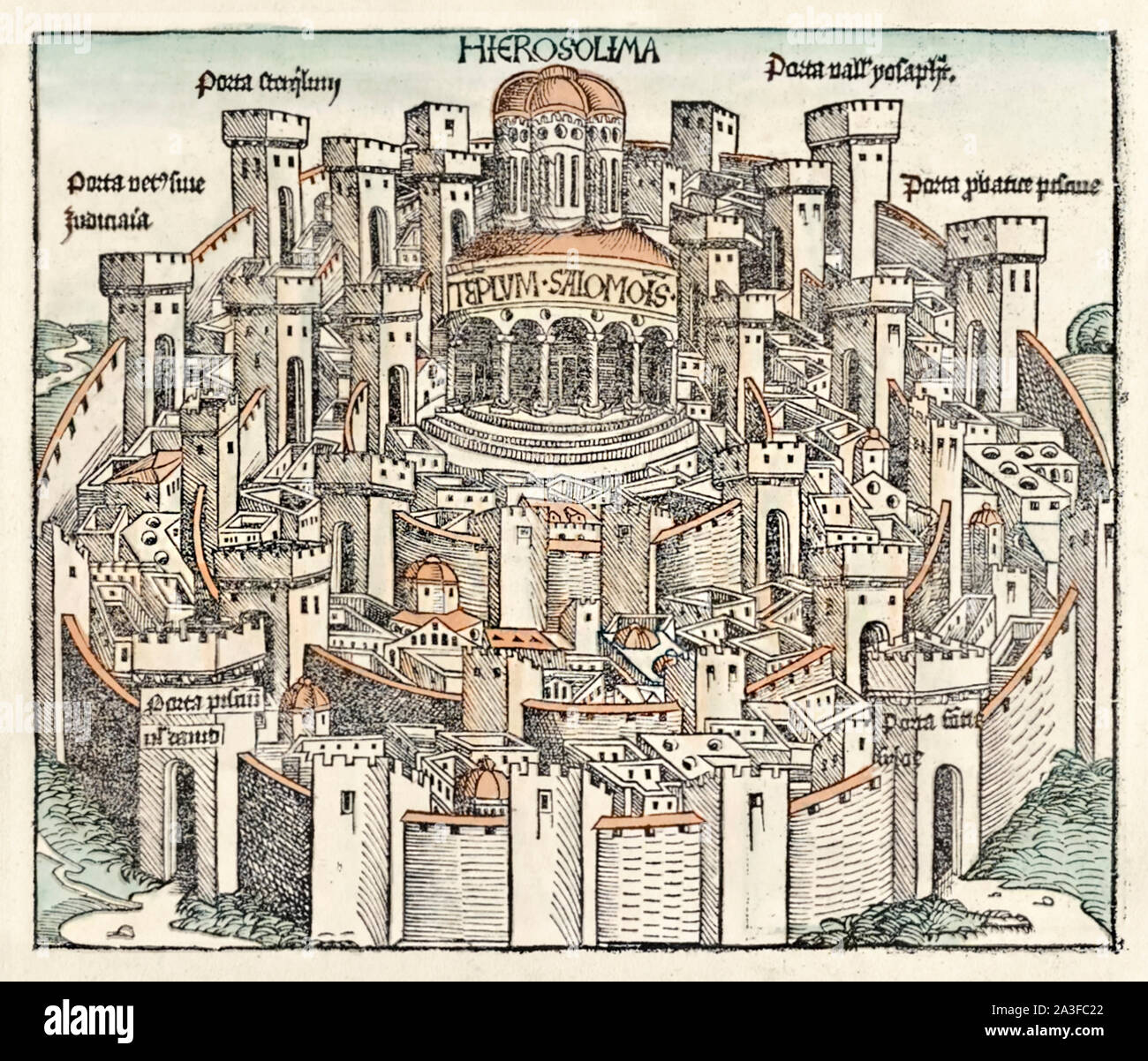 Jerusalem, woodcut by Michael Wolgemut (1434–1519) from 'Liber Chronicarum' (aka Nuremberg Chronicle) by Hartmann Schedel (1440-1514) showing the old walled city with the first Temple of Solomon before its destruction by the Babylonian invasion in 586 BCE. Photograph from 1493 first edition in Latin published in Nuremberg, Germany and hand coloured. Stock Photohttps://www.alamy.com/image-license-details/?v=1https://www.alamy.com/jerusalem-woodcut-by-michael-wolgemut-14341519-from-liber-chronicarum-aka-nuremberg-chronicle-by-hartmann-schedel-1440-1514-showing-the-old-walled-city-with-the-first-temple-of-solomon-before-its-destruction-by-the-babylonian-invasion-in-586-bce-photograph-from-1493-first-edition-in-latin-published-in-nuremberg-germany-and-hand-coloured-image329179706.html
Jerusalem, woodcut by Michael Wolgemut (1434–1519) from 'Liber Chronicarum' (aka Nuremberg Chronicle) by Hartmann Schedel (1440-1514) showing the old walled city with the first Temple of Solomon before its destruction by the Babylonian invasion in 586 BCE. Photograph from 1493 first edition in Latin published in Nuremberg, Germany and hand coloured. Stock Photohttps://www.alamy.com/image-license-details/?v=1https://www.alamy.com/jerusalem-woodcut-by-michael-wolgemut-14341519-from-liber-chronicarum-aka-nuremberg-chronicle-by-hartmann-schedel-1440-1514-showing-the-old-walled-city-with-the-first-temple-of-solomon-before-its-destruction-by-the-babylonian-invasion-in-586-bce-photograph-from-1493-first-edition-in-latin-published-in-nuremberg-germany-and-hand-coloured-image329179706.htmlRM2A3FC22–Jerusalem, woodcut by Michael Wolgemut (1434–1519) from 'Liber Chronicarum' (aka Nuremberg Chronicle) by Hartmann Schedel (1440-1514) showing the old walled city with the first Temple of Solomon before its destruction by the Babylonian invasion in 586 BCE. Photograph from 1493 first edition in Latin published in Nuremberg, Germany and hand coloured.
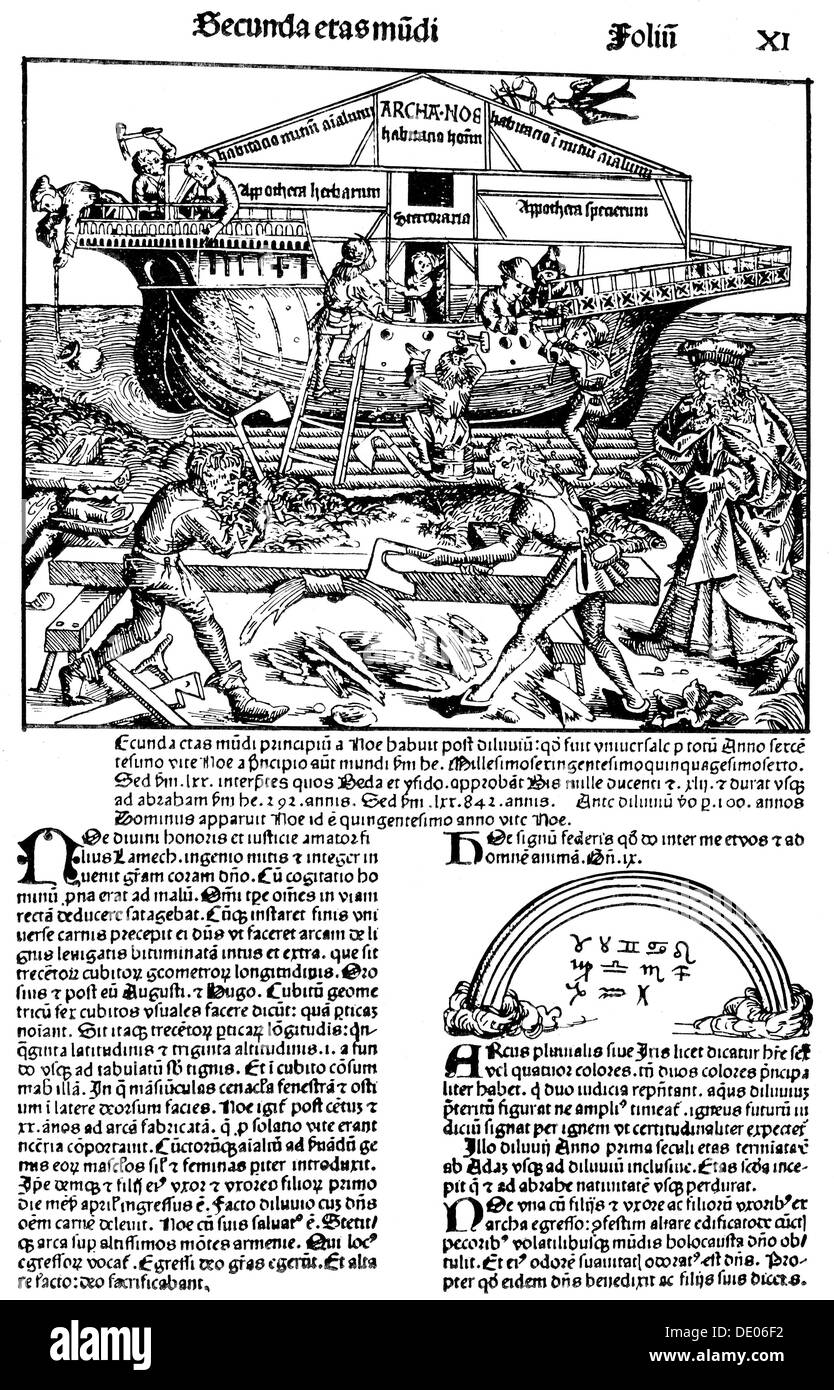 Page from the book The Nuremberg Chronicle, by Hartmann Schedel, 1493. Artist: Michael Wolgemut Stock Photohttps://www.alamy.com/image-license-details/?v=1https://www.alamy.com/page-from-the-book-the-nuremberg-chronicle-by-hartmann-schedel-1493-image60241414.html
Page from the book The Nuremberg Chronicle, by Hartmann Schedel, 1493. Artist: Michael Wolgemut Stock Photohttps://www.alamy.com/image-license-details/?v=1https://www.alamy.com/page-from-the-book-the-nuremberg-chronicle-by-hartmann-schedel-1493-image60241414.htmlRMDE06F2–Page from the book The Nuremberg Chronicle, by Hartmann Schedel, 1493. Artist: Michael Wolgemut
 Nuremberg Chronicle, Hartmann Schedel, German, 1440–1514, Michael Wolgemut, German, 1434–1519, Wilhelm Pleydenwurff, German, c.1458–1494, Anton Koberger, German, c.1445–1513, 1493, Book with woodcut illustrations, Made in Nuremberg, Bavaria, Germany, Europe, Nuremberg, Bavaria, Germany, Europe, Books & manuscripts, 20 x 14 x 6 in. (50.8 x 35.6 x 15.2 cm Stock Photohttps://www.alamy.com/image-license-details/?v=1https://www.alamy.com/nuremberg-chronicle-hartmann-schedel-german-14401514-michael-wolgemut-german-14341519-wilhelm-pleydenwurff-german-c14581494-anton-koberger-german-c14451513-1493-book-with-woodcut-illustrations-made-in-nuremberg-bavaria-germany-europe-nuremberg-bavaria-germany-europe-books-manuscripts-20-x-14-x-6-in-508-x-356-x-152-cm-image454294626.html
Nuremberg Chronicle, Hartmann Schedel, German, 1440–1514, Michael Wolgemut, German, 1434–1519, Wilhelm Pleydenwurff, German, c.1458–1494, Anton Koberger, German, c.1445–1513, 1493, Book with woodcut illustrations, Made in Nuremberg, Bavaria, Germany, Europe, Nuremberg, Bavaria, Germany, Europe, Books & manuscripts, 20 x 14 x 6 in. (50.8 x 35.6 x 15.2 cm Stock Photohttps://www.alamy.com/image-license-details/?v=1https://www.alamy.com/nuremberg-chronicle-hartmann-schedel-german-14401514-michael-wolgemut-german-14341519-wilhelm-pleydenwurff-german-c14581494-anton-koberger-german-c14451513-1493-book-with-woodcut-illustrations-made-in-nuremberg-bavaria-germany-europe-nuremberg-bavaria-germany-europe-books-manuscripts-20-x-14-x-6-in-508-x-356-x-152-cm-image454294626.htmlRM2HB2WC2–Nuremberg Chronicle, Hartmann Schedel, German, 1440–1514, Michael Wolgemut, German, 1434–1519, Wilhelm Pleydenwurff, German, c.1458–1494, Anton Koberger, German, c.1445–1513, 1493, Book with woodcut illustrations, Made in Nuremberg, Bavaria, Germany, Europe, Nuremberg, Bavaria, Germany, Europe, Books & manuscripts, 20 x 14 x 6 in. (50.8 x 35.6 x 15.2 cm
 Inspired by Nuremberg Chronicle, Hartmann Schedel, German, 1440–1514, Michael Wolgemut, German, 1434–1519, Wilhelm Pleydenwurff, German, c.1458–1494, Anton Koberger, German, c.1445–1513, 1493, Book with woodcut illustrations, Made in Nuremberg, Bavaria, Germany, Europe, Nuremberg, Bavaria, Germany, Reimagined by Artotop. Classic art reinvented with a modern twist. Design of warm cheerful glowing of brightness and light ray radiance. Photography inspired by surrealism and futurism, embracing dynamic energy of modern technology, movement, speed and revolutionize culture Stock Photohttps://www.alamy.com/image-license-details/?v=1https://www.alamy.com/inspired-by-nuremberg-chronicle-hartmann-schedel-german-14401514-michael-wolgemut-german-14341519-wilhelm-pleydenwurff-german-c14581494-anton-koberger-german-c14451513-1493-book-with-woodcut-illustrations-made-in-nuremberg-bavaria-germany-europe-nuremberg-bavaria-germany-reimagined-by-artotop-classic-art-reinvented-with-a-modern-twist-design-of-warm-cheerful-glowing-of-brightness-and-light-ray-radiance-photography-inspired-by-surrealism-and-futurism-embracing-dynamic-energy-of-modern-technology-movement-speed-and-revolutionize-culture-image459286919.html
Inspired by Nuremberg Chronicle, Hartmann Schedel, German, 1440–1514, Michael Wolgemut, German, 1434–1519, Wilhelm Pleydenwurff, German, c.1458–1494, Anton Koberger, German, c.1445–1513, 1493, Book with woodcut illustrations, Made in Nuremberg, Bavaria, Germany, Europe, Nuremberg, Bavaria, Germany, Reimagined by Artotop. Classic art reinvented with a modern twist. Design of warm cheerful glowing of brightness and light ray radiance. Photography inspired by surrealism and futurism, embracing dynamic energy of modern technology, movement, speed and revolutionize culture Stock Photohttps://www.alamy.com/image-license-details/?v=1https://www.alamy.com/inspired-by-nuremberg-chronicle-hartmann-schedel-german-14401514-michael-wolgemut-german-14341519-wilhelm-pleydenwurff-german-c14581494-anton-koberger-german-c14451513-1493-book-with-woodcut-illustrations-made-in-nuremberg-bavaria-germany-europe-nuremberg-bavaria-germany-reimagined-by-artotop-classic-art-reinvented-with-a-modern-twist-design-of-warm-cheerful-glowing-of-brightness-and-light-ray-radiance-photography-inspired-by-surrealism-and-futurism-embracing-dynamic-energy-of-modern-technology-movement-speed-and-revolutionize-culture-image459286919.htmlRF2HK6947–Inspired by Nuremberg Chronicle, Hartmann Schedel, German, 1440–1514, Michael Wolgemut, German, 1434–1519, Wilhelm Pleydenwurff, German, c.1458–1494, Anton Koberger, German, c.1445–1513, 1493, Book with woodcut illustrations, Made in Nuremberg, Bavaria, Germany, Europe, Nuremberg, Bavaria, Germany, Reimagined by Artotop. Classic art reinvented with a modern twist. Design of warm cheerful glowing of brightness and light ray radiance. Photography inspired by surrealism and futurism, embracing dynamic energy of modern technology, movement, speed and revolutionize culture
 The Nuremberg Chronicle, first Latin edition, 1493, Michael Wolgemut; Artist: Wilhelm Pleydenwurff; Author: Hartmann Schedel; Printer: Anton Koberger, German, 1434/37 - 1519, 17 5/8 x 12 3/8 x 3 1/4in. (44.8 x 31.4 x 8.3cm), Woodcuts and letterpress; bound volume, Germany, 15th century, At the end of the 15th century, the new industry of book printing reached its zenith in Nuremberg, Germany. This book, which was written by Dr. Hartmann Schedel, recounts the history of the world from Creation to the early 1490s with lessons in religion and geography Stock Photohttps://www.alamy.com/image-license-details/?v=1https://www.alamy.com/the-nuremberg-chronicle-first-latin-edition-1493-michael-wolgemut-artist-wilhelm-pleydenwurff-author-hartmann-schedel-printer-anton-koberger-german-143437-1519-17-58-x-12-38-x-3-14in-448-x-314-x-83cm-woodcuts-and-letterpress-bound-volume-germany-15th-century-at-the-end-of-the-15th-century-the-new-industry-of-book-printing-reached-its-zenith-in-nuremberg-germany-this-book-which-was-written-by-dr-hartmann-schedel-recounts-the-history-of-the-world-from-creation-to-the-early-1490s-with-lessons-in-religion-and-geography-image573503821.html
The Nuremberg Chronicle, first Latin edition, 1493, Michael Wolgemut; Artist: Wilhelm Pleydenwurff; Author: Hartmann Schedel; Printer: Anton Koberger, German, 1434/37 - 1519, 17 5/8 x 12 3/8 x 3 1/4in. (44.8 x 31.4 x 8.3cm), Woodcuts and letterpress; bound volume, Germany, 15th century, At the end of the 15th century, the new industry of book printing reached its zenith in Nuremberg, Germany. This book, which was written by Dr. Hartmann Schedel, recounts the history of the world from Creation to the early 1490s with lessons in religion and geography Stock Photohttps://www.alamy.com/image-license-details/?v=1https://www.alamy.com/the-nuremberg-chronicle-first-latin-edition-1493-michael-wolgemut-artist-wilhelm-pleydenwurff-author-hartmann-schedel-printer-anton-koberger-german-143437-1519-17-58-x-12-38-x-3-14in-448-x-314-x-83cm-woodcuts-and-letterpress-bound-volume-germany-15th-century-at-the-end-of-the-15th-century-the-new-industry-of-book-printing-reached-its-zenith-in-nuremberg-germany-this-book-which-was-written-by-dr-hartmann-schedel-recounts-the-history-of-the-world-from-creation-to-the-early-1490s-with-lessons-in-religion-and-geography-image573503821.htmlRM2T919Y9–The Nuremberg Chronicle, first Latin edition, 1493, Michael Wolgemut; Artist: Wilhelm Pleydenwurff; Author: Hartmann Schedel; Printer: Anton Koberger, German, 1434/37 - 1519, 17 5/8 x 12 3/8 x 3 1/4in. (44.8 x 31.4 x 8.3cm), Woodcuts and letterpress; bound volume, Germany, 15th century, At the end of the 15th century, the new industry of book printing reached its zenith in Nuremberg, Germany. This book, which was written by Dr. Hartmann Schedel, recounts the history of the world from Creation to the early 1490s with lessons in religion and geography
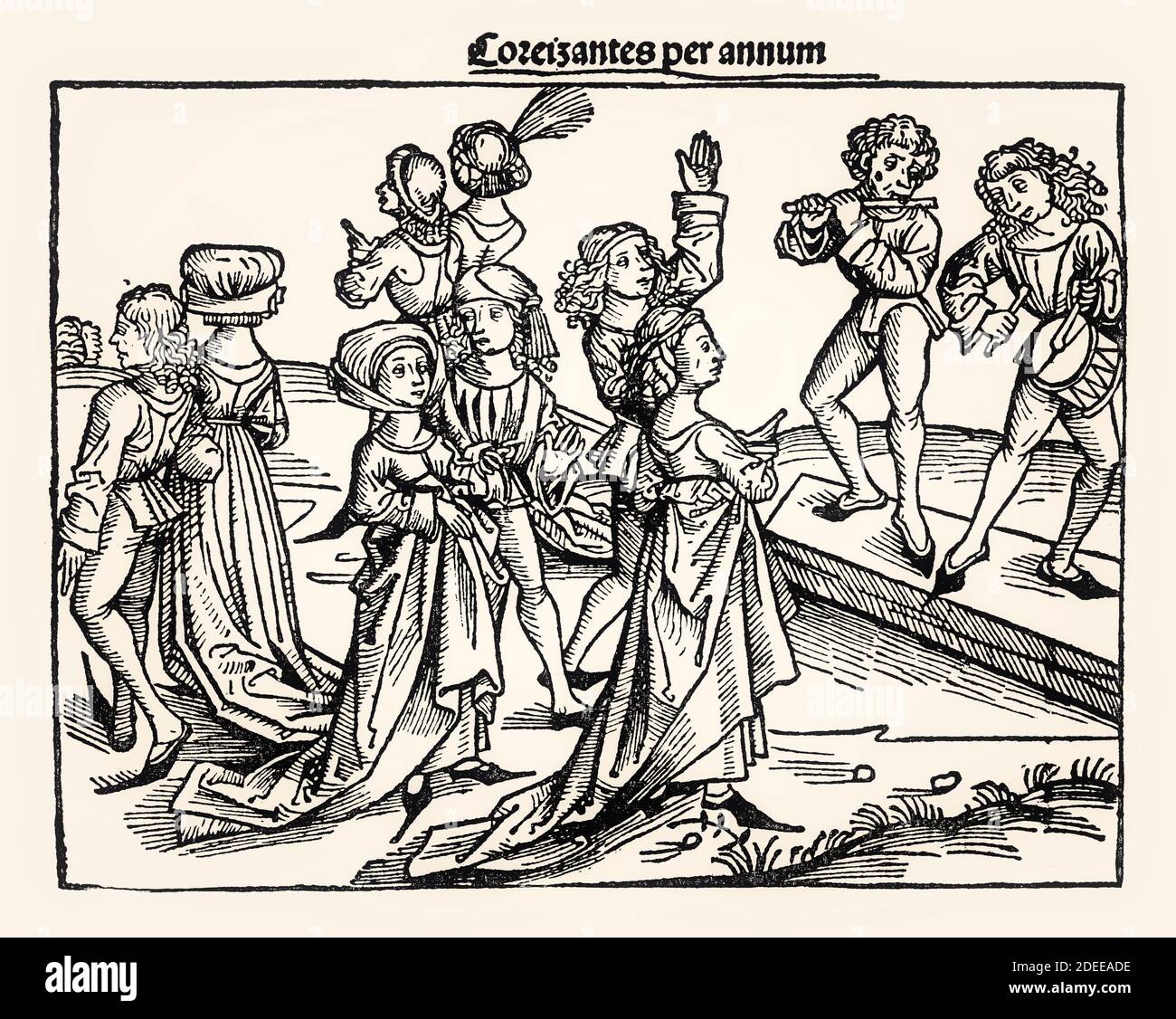 Nuremberg Chronicle, dancing couples, 1493, Anton Koberger, digitally restored Stock Photohttps://www.alamy.com/image-license-details/?v=1https://www.alamy.com/nuremberg-chronicle-dancing-couples-1493-anton-koberger-digitally-restored-image387548826.html
Nuremberg Chronicle, dancing couples, 1493, Anton Koberger, digitally restored Stock Photohttps://www.alamy.com/image-license-details/?v=1https://www.alamy.com/nuremberg-chronicle-dancing-couples-1493-anton-koberger-digitally-restored-image387548826.htmlRM2DEEADE–Nuremberg Chronicle, dancing couples, 1493, Anton Koberger, digitally restored
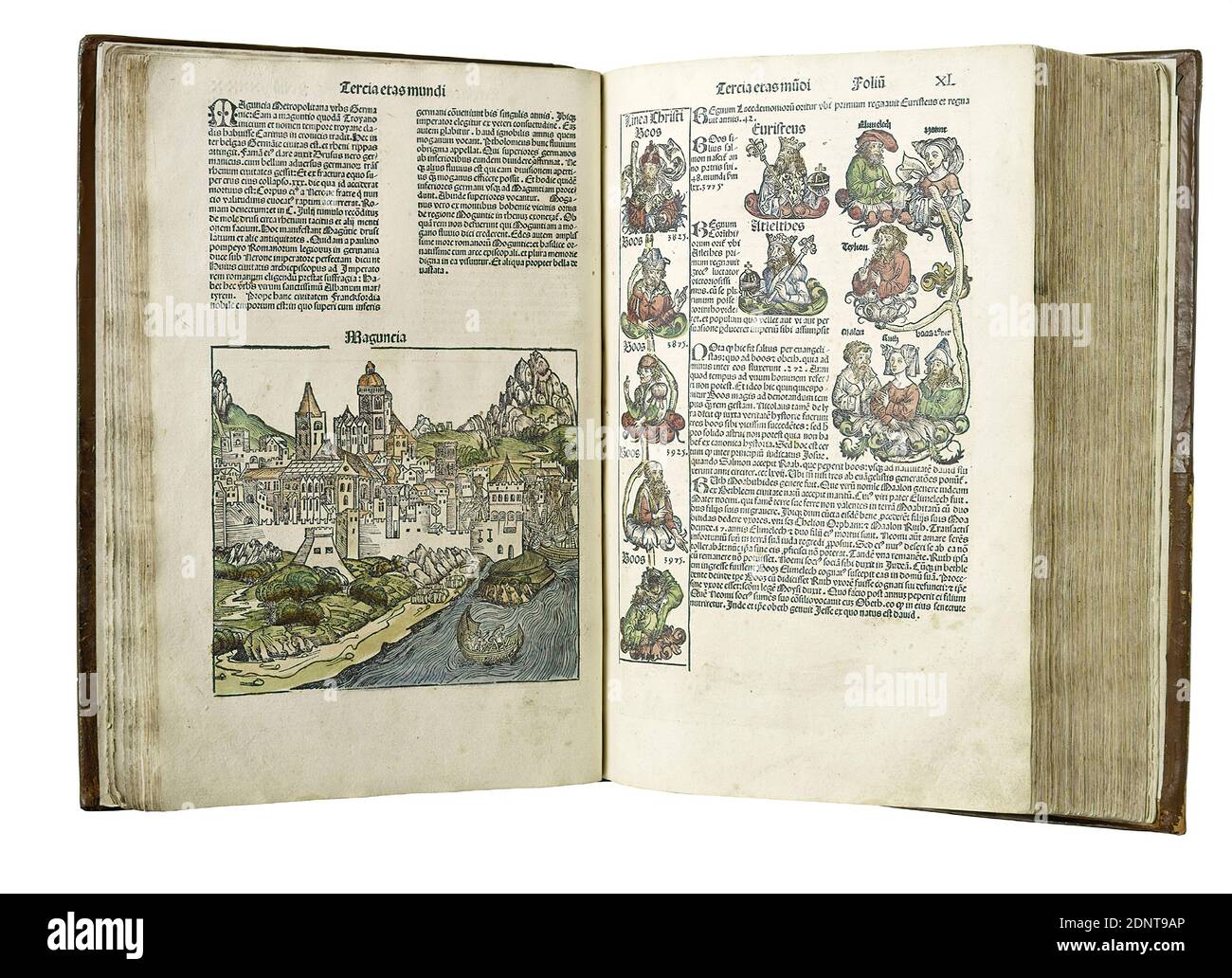 Anton Koberger, Wilhelm Pleydenwurff, Hartmann Schedel, Michael Wolgemut, Schedel's World Chronicle, paper, woodcut, Total: Height: 44,00 cm; Width: 32,00 cm; Depth: 8,50 cm, printed matter, town, city view (veduta), city maps, Renaissance, A highlight in book illustration on the threshold between the Middle Ages and modern times is the so-called Schedel's World Chronicle. The Nuremberg city physician and humanist Hartmann Schedel published a Latin and a German edition of his chronicle in 1493. Stock Photohttps://www.alamy.com/image-license-details/?v=1https://www.alamy.com/anton-koberger-wilhelm-pleydenwurff-hartmann-schedel-michael-wolgemut-schedels-world-chronicle-paper-woodcut-total-height-4400-cm-width-3200-cm-depth-850-cm-printed-matter-town-city-view-veduta-city-maps-renaissance-a-highlight-in-book-illustration-on-the-threshold-between-the-middle-ages-and-modern-times-is-the-so-called-schedels-world-chronicle-the-nuremberg-city-physician-and-humanist-hartmann-schedel-published-a-latin-and-a-german-edition-of-his-chronicle-in-1493-image392070078.html
Anton Koberger, Wilhelm Pleydenwurff, Hartmann Schedel, Michael Wolgemut, Schedel's World Chronicle, paper, woodcut, Total: Height: 44,00 cm; Width: 32,00 cm; Depth: 8,50 cm, printed matter, town, city view (veduta), city maps, Renaissance, A highlight in book illustration on the threshold between the Middle Ages and modern times is the so-called Schedel's World Chronicle. The Nuremberg city physician and humanist Hartmann Schedel published a Latin and a German edition of his chronicle in 1493. Stock Photohttps://www.alamy.com/image-license-details/?v=1https://www.alamy.com/anton-koberger-wilhelm-pleydenwurff-hartmann-schedel-michael-wolgemut-schedels-world-chronicle-paper-woodcut-total-height-4400-cm-width-3200-cm-depth-850-cm-printed-matter-town-city-view-veduta-city-maps-renaissance-a-highlight-in-book-illustration-on-the-threshold-between-the-middle-ages-and-modern-times-is-the-so-called-schedels-world-chronicle-the-nuremberg-city-physician-and-humanist-hartmann-schedel-published-a-latin-and-a-german-edition-of-his-chronicle-in-1493-image392070078.htmlRM2DNT9AP–Anton Koberger, Wilhelm Pleydenwurff, Hartmann Schedel, Michael Wolgemut, Schedel's World Chronicle, paper, woodcut, Total: Height: 44,00 cm; Width: 32,00 cm; Depth: 8,50 cm, printed matter, town, city view (veduta), city maps, Renaissance, A highlight in book illustration on the threshold between the Middle Ages and modern times is the so-called Schedel's World Chronicle. The Nuremberg city physician and humanist Hartmann Schedel published a Latin and a German edition of his chronicle in 1493.
 Venerable Bede (c.673-735) Anglo-Saxon theologian, scholar and historian; monk at Jarrow, Northumberland, holding open a book. Woodcut from Hartmann Schedel 'Liber chronicarum mundi' (Nuremberg Chronicle) Nuremberg, 1493 Stock Photohttps://www.alamy.com/image-license-details/?v=1https://www.alamy.com/stock-photo-venerable-bede-c673-735-anglo-saxon-theologian-scholar-and-historian-57303250.html
Venerable Bede (c.673-735) Anglo-Saxon theologian, scholar and historian; monk at Jarrow, Northumberland, holding open a book. Woodcut from Hartmann Schedel 'Liber chronicarum mundi' (Nuremberg Chronicle) Nuremberg, 1493 Stock Photohttps://www.alamy.com/image-license-details/?v=1https://www.alamy.com/stock-photo-venerable-bede-c673-735-anglo-saxon-theologian-scholar-and-historian-57303250.htmlRMD96ATJ–Venerable Bede (c.673-735) Anglo-Saxon theologian, scholar and historian; monk at Jarrow, Northumberland, holding open a book. Woodcut from Hartmann Schedel 'Liber chronicarum mundi' (Nuremberg Chronicle) Nuremberg, 1493
 Lot and his family fleeing Sodom - Illustration from The Nuremberg Chronicle, 1493. Illustrated by Wilhelm Pleydenwurff and Michael Wolgemut Stock Photohttps://www.alamy.com/image-license-details/?v=1https://www.alamy.com/lot-and-his-family-fleeing-sodom-illustration-from-the-nuremberg-chronicle-1493-illustrated-by-wilhelm-pleydenwurff-and-michael-wolgemut-image572588521.html
Lot and his family fleeing Sodom - Illustration from The Nuremberg Chronicle, 1493. Illustrated by Wilhelm Pleydenwurff and Michael Wolgemut Stock Photohttps://www.alamy.com/image-license-details/?v=1https://www.alamy.com/lot-and-his-family-fleeing-sodom-illustration-from-the-nuremberg-chronicle-1493-illustrated-by-wilhelm-pleydenwurff-and-michael-wolgemut-image572588521.htmlRF2T7FJE1–Lot and his family fleeing Sodom - Illustration from The Nuremberg Chronicle, 1493. Illustrated by Wilhelm Pleydenwurff and Michael Wolgemut
 Page of the Book 'The Nuremberg Chronicle' (Schedel's Chronicle of the World) by Hartmann Schedel. Museum: Russian State Library, Moscow. Author: WOLGEMUT, MICHAEL. Stock Photohttps://www.alamy.com/image-license-details/?v=1https://www.alamy.com/page-of-the-book-the-nuremberg-chronicle-schedels-chronicle-of-the-world-by-hartmann-schedel-museum-russian-state-library-moscow-author-wolgemut-michael-image233470630.html
Page of the Book 'The Nuremberg Chronicle' (Schedel's Chronicle of the World) by Hartmann Schedel. Museum: Russian State Library, Moscow. Author: WOLGEMUT, MICHAEL. Stock Photohttps://www.alamy.com/image-license-details/?v=1https://www.alamy.com/page-of-the-book-the-nuremberg-chronicle-schedels-chronicle-of-the-world-by-hartmann-schedel-museum-russian-state-library-moscow-author-wolgemut-michael-image233470630.htmlRMRFRE4P–Page of the Book 'The Nuremberg Chronicle' (Schedel's Chronicle of the World) by Hartmann Schedel. Museum: Russian State Library, Moscow. Author: WOLGEMUT, MICHAEL.
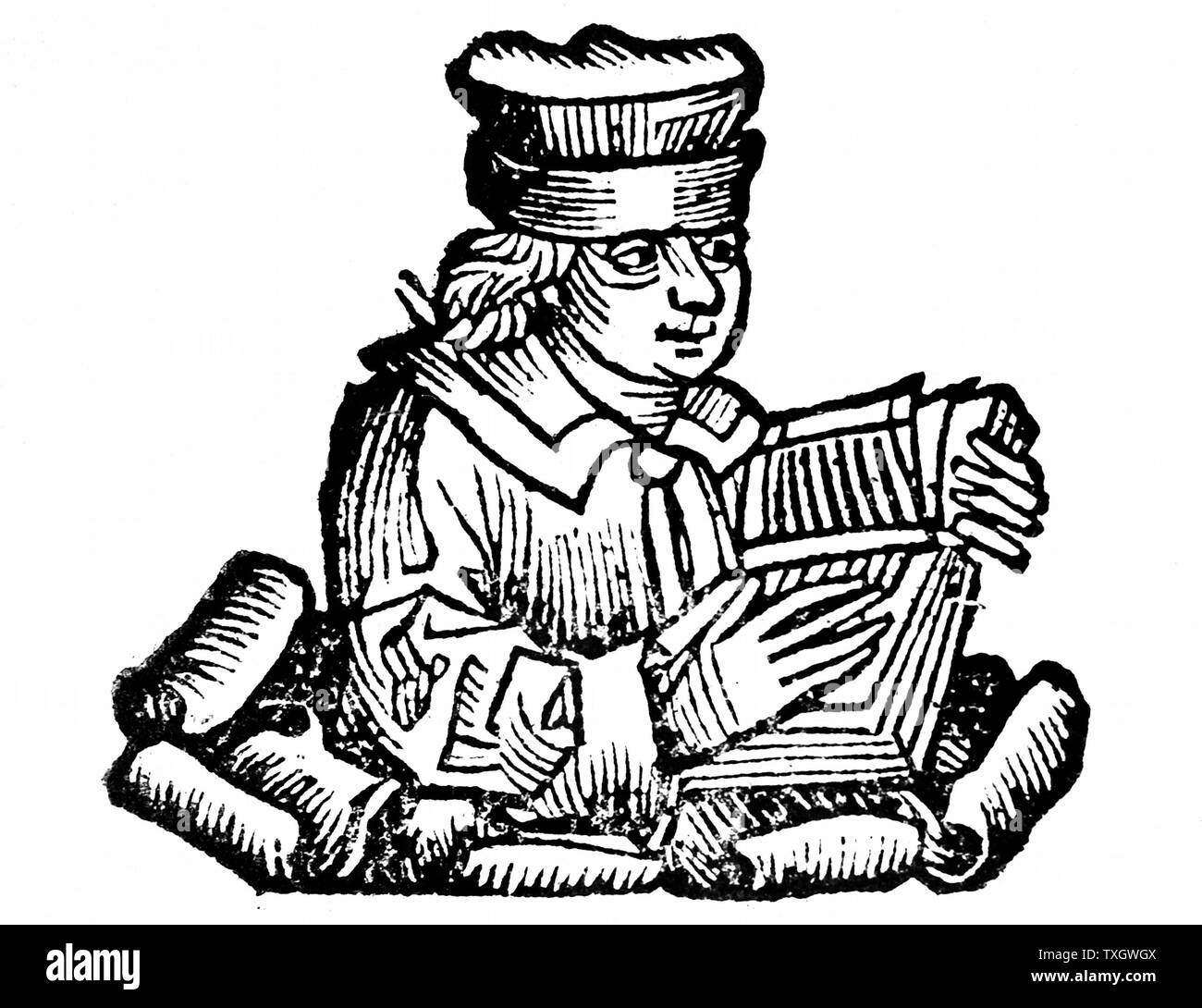 Aesop - probably legendary Greek fabulist, according to Herodotus, he lived 6th century BC. 1493 Woodcut from Hartmann Schedel 'Liber chronicarum mundi' (Nuremberg Chronicle) Nuremberg Stock Photohttps://www.alamy.com/image-license-details/?v=1https://www.alamy.com/aesop-probably-legendary-greek-fabulist-according-to-herodotus-he-lived-6th-century-bc-1493-woodcut-from-hartmann-schedel-liber-chronicarum-mundi-nuremberg-chronicle-nuremberg-image257297514.html
Aesop - probably legendary Greek fabulist, according to Herodotus, he lived 6th century BC. 1493 Woodcut from Hartmann Schedel 'Liber chronicarum mundi' (Nuremberg Chronicle) Nuremberg Stock Photohttps://www.alamy.com/image-license-details/?v=1https://www.alamy.com/aesop-probably-legendary-greek-fabulist-according-to-herodotus-he-lived-6th-century-bc-1493-woodcut-from-hartmann-schedel-liber-chronicarum-mundi-nuremberg-chronicle-nuremberg-image257297514.htmlRMTXGWGX–Aesop - probably legendary Greek fabulist, according to Herodotus, he lived 6th century BC. 1493 Woodcut from Hartmann Schedel 'Liber chronicarum mundi' (Nuremberg Chronicle) Nuremberg
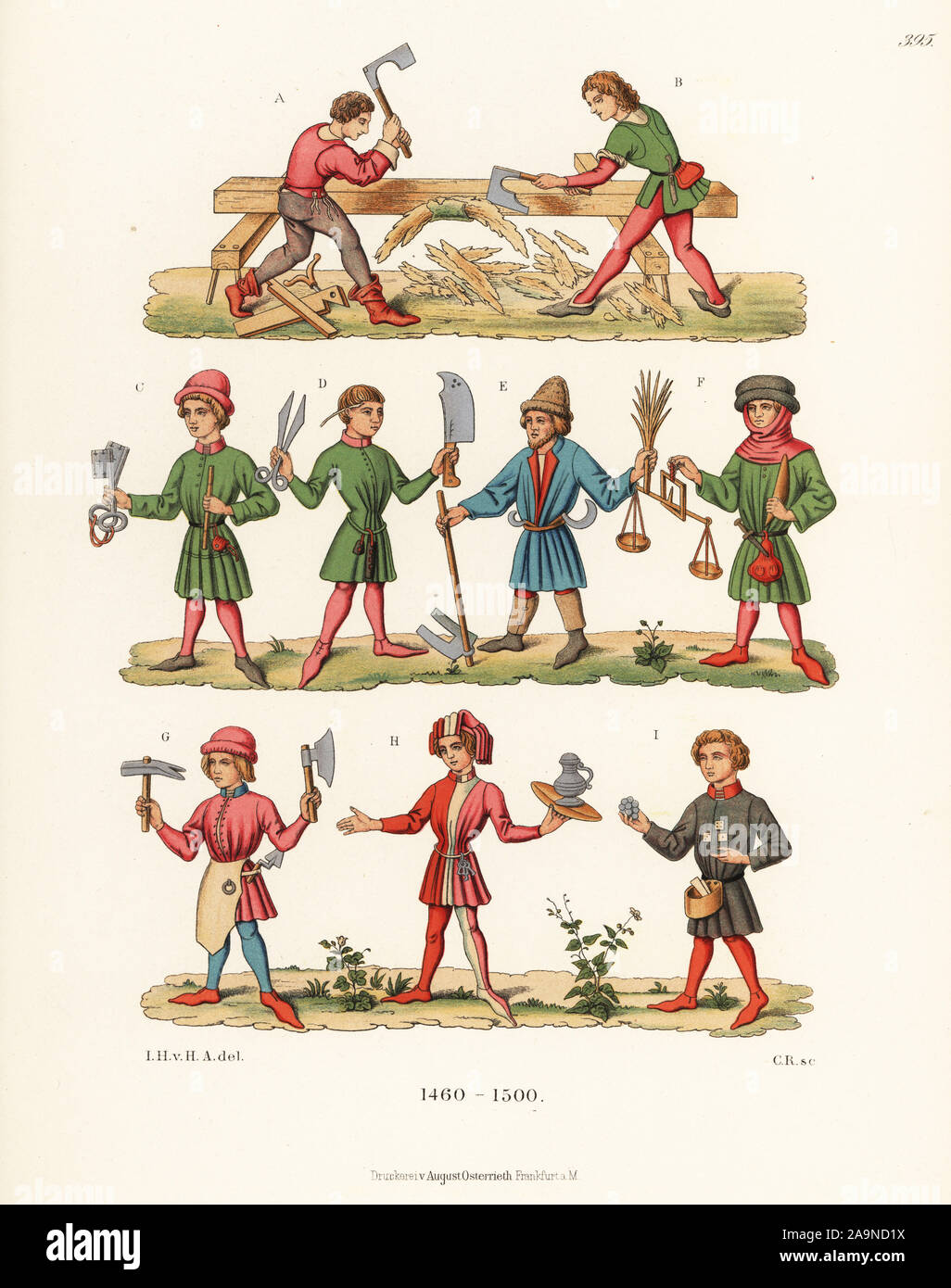 Costumes of German tradesmen, late 15th century. Carpenters with adze working on Noah’s Ark A and B from the Nuremberg Chronicle. Guard with keys C, leatherworker and shoemaker D, farmer with wheat E, merchant with scales F, carpenter with hammer G, innkeeper with tray H, and toymaker I from a chess book, Schachzabelbuch. Chromolithograph from Hefner-Alteneck's Costumes, Artworks and Appliances from the Middle Ages to the 17th Century, Frankfurt, 1889. Illustration by Dr. Jakob Heinrich von Hefner-Alteneck, lithographed by C. Regnier. Dr. Hefner-Alteneck (1811 - 1903) was a German museum curat Stock Photohttps://www.alamy.com/image-license-details/?v=1https://www.alamy.com/costumes-of-german-tradesmen-late-15th-century-carpenters-with-adze-working-on-noahs-ark-a-and-b-from-the-nuremberg-chronicle-guard-with-keys-c-leatherworker-and-shoemaker-d-farmer-with-wheat-e-merchant-with-scales-f-carpenter-with-hammer-g-innkeeper-with-tray-h-and-toymaker-i-from-a-chess-book-schachzabelbuch-chromolithograph-from-hefner-altenecks-costumes-artworks-and-appliances-from-the-middle-ages-to-the-17th-century-frankfurt-1889-illustration-by-dr-jakob-heinrich-von-hefner-alteneck-lithographed-by-c-regnier-dr-hefner-alteneck-1811-1903-was-a-german-museum-curat-image333000134.html
Costumes of German tradesmen, late 15th century. Carpenters with adze working on Noah’s Ark A and B from the Nuremberg Chronicle. Guard with keys C, leatherworker and shoemaker D, farmer with wheat E, merchant with scales F, carpenter with hammer G, innkeeper with tray H, and toymaker I from a chess book, Schachzabelbuch. Chromolithograph from Hefner-Alteneck's Costumes, Artworks and Appliances from the Middle Ages to the 17th Century, Frankfurt, 1889. Illustration by Dr. Jakob Heinrich von Hefner-Alteneck, lithographed by C. Regnier. Dr. Hefner-Alteneck (1811 - 1903) was a German museum curat Stock Photohttps://www.alamy.com/image-license-details/?v=1https://www.alamy.com/costumes-of-german-tradesmen-late-15th-century-carpenters-with-adze-working-on-noahs-ark-a-and-b-from-the-nuremberg-chronicle-guard-with-keys-c-leatherworker-and-shoemaker-d-farmer-with-wheat-e-merchant-with-scales-f-carpenter-with-hammer-g-innkeeper-with-tray-h-and-toymaker-i-from-a-chess-book-schachzabelbuch-chromolithograph-from-hefner-altenecks-costumes-artworks-and-appliances-from-the-middle-ages-to-the-17th-century-frankfurt-1889-illustration-by-dr-jakob-heinrich-von-hefner-alteneck-lithographed-by-c-regnier-dr-hefner-alteneck-1811-1903-was-a-german-museum-curat-image333000134.htmlRM2A9ND1X–Costumes of German tradesmen, late 15th century. Carpenters with adze working on Noah’s Ark A and B from the Nuremberg Chronicle. Guard with keys C, leatherworker and shoemaker D, farmer with wheat E, merchant with scales F, carpenter with hammer G, innkeeper with tray H, and toymaker I from a chess book, Schachzabelbuch. Chromolithograph from Hefner-Alteneck's Costumes, Artworks and Appliances from the Middle Ages to the 17th Century, Frankfurt, 1889. Illustration by Dr. Jakob Heinrich von Hefner-Alteneck, lithographed by C. Regnier. Dr. Hefner-Alteneck (1811 - 1903) was a German museum curat
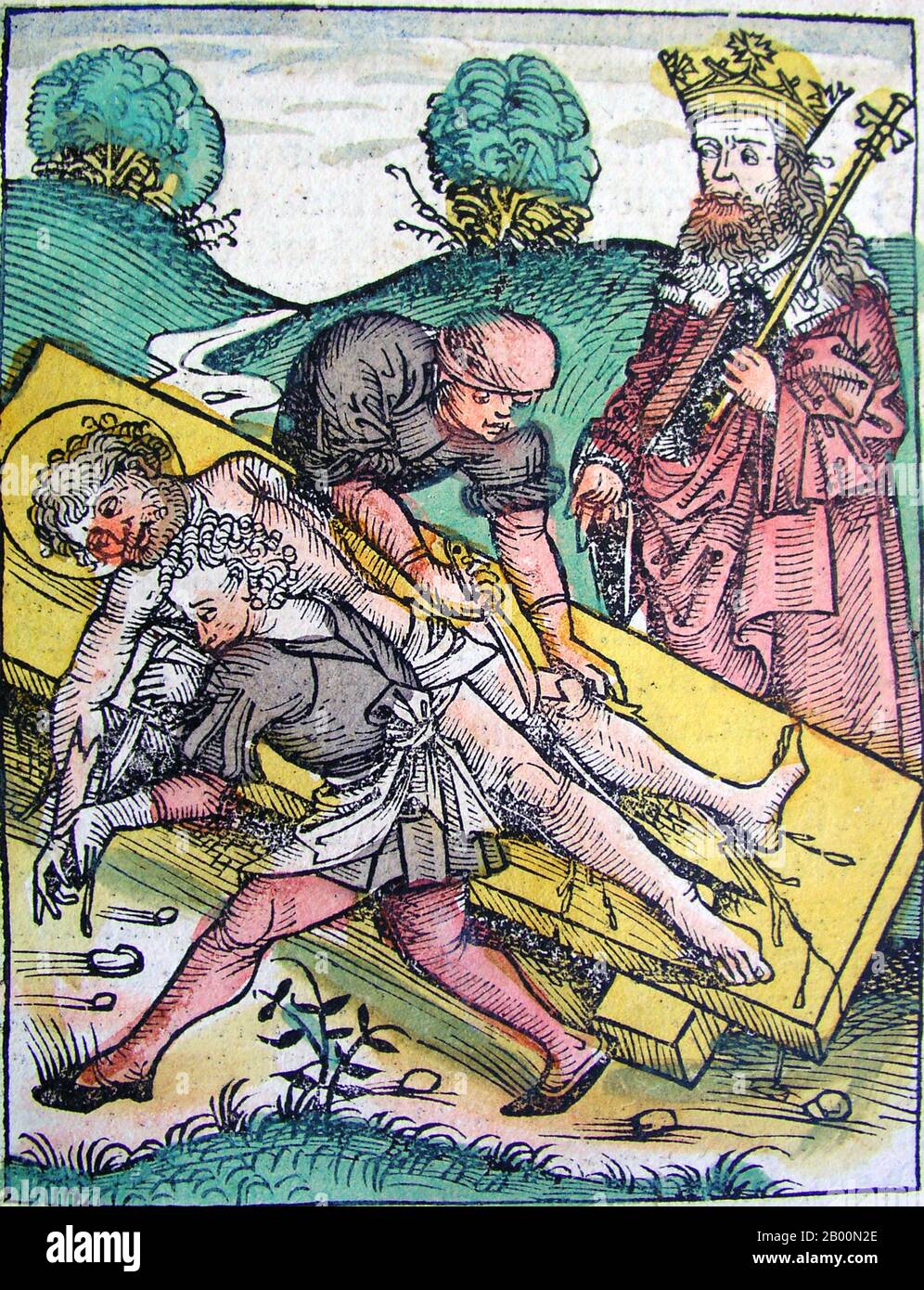 Germany: 'Martyrdom of the Apostle Bartholomew'. The Nuremberg Chronicle, by Hartmann Schedel (1440-1514), 1493. The Nuremberg Chronicle is an illustrated world history. Its structure follows the story of human history as related in the Bible. Written in Latin by Hartmann Schedel, with a version in German translation by Georg Alt, it appeared in 1493. It is one of the best-documented early printed books. It is classified as an incunabulum, a book, pamphlet, or broadside that was printed (not handwritten) before the year 1501 in Europe. Stock Photohttps://www.alamy.com/image-license-details/?v=1https://www.alamy.com/germany-martyrdom-of-the-apostle-bartholomew-the-nuremberg-chronicle-by-hartmann-schedel-1440-1514-1493-the-nuremberg-chronicle-is-an-illustrated-world-history-its-structure-follows-the-story-of-human-history-as-related-in-the-bible-written-in-latin-by-hartmann-schedel-with-a-version-in-german-translation-by-georg-alt-it-appeared-in-1493-it-is-one-of-the-best-documented-early-printed-books-it-is-classified-as-an-incunabulum-a-book-pamphlet-or-broadside-that-was-printed-not-handwritten-before-the-year-1501-in-europe-image344223894.html
Germany: 'Martyrdom of the Apostle Bartholomew'. The Nuremberg Chronicle, by Hartmann Schedel (1440-1514), 1493. The Nuremberg Chronicle is an illustrated world history. Its structure follows the story of human history as related in the Bible. Written in Latin by Hartmann Schedel, with a version in German translation by Georg Alt, it appeared in 1493. It is one of the best-documented early printed books. It is classified as an incunabulum, a book, pamphlet, or broadside that was printed (not handwritten) before the year 1501 in Europe. Stock Photohttps://www.alamy.com/image-license-details/?v=1https://www.alamy.com/germany-martyrdom-of-the-apostle-bartholomew-the-nuremberg-chronicle-by-hartmann-schedel-1440-1514-1493-the-nuremberg-chronicle-is-an-illustrated-world-history-its-structure-follows-the-story-of-human-history-as-related-in-the-bible-written-in-latin-by-hartmann-schedel-with-a-version-in-german-translation-by-georg-alt-it-appeared-in-1493-it-is-one-of-the-best-documented-early-printed-books-it-is-classified-as-an-incunabulum-a-book-pamphlet-or-broadside-that-was-printed-not-handwritten-before-the-year-1501-in-europe-image344223894.htmlRM2B00N2E–Germany: 'Martyrdom of the Apostle Bartholomew'. The Nuremberg Chronicle, by Hartmann Schedel (1440-1514), 1493. The Nuremberg Chronicle is an illustrated world history. Its structure follows the story of human history as related in the Bible. Written in Latin by Hartmann Schedel, with a version in German translation by Georg Alt, it appeared in 1493. It is one of the best-documented early printed books. It is classified as an incunabulum, a book, pamphlet, or broadside that was printed (not handwritten) before the year 1501 in Europe.
 Regensburg (Germany). Engraving. Liber Chronicarum by Hartmann Schedel, 1493. Later colouration. Stock Photohttps://www.alamy.com/image-license-details/?v=1https://www.alamy.com/regensburg-germany-engraving-liber-chronicarum-by-hartmann-schedel-1493-later-colouration-image337902940.html
Regensburg (Germany). Engraving. Liber Chronicarum by Hartmann Schedel, 1493. Later colouration. Stock Photohttps://www.alamy.com/image-license-details/?v=1https://www.alamy.com/regensburg-germany-engraving-liber-chronicarum-by-hartmann-schedel-1493-later-colouration-image337902940.htmlRM2AHMPJ4–Regensburg (Germany). Engraving. Liber Chronicarum by Hartmann Schedel, 1493. Later colouration.
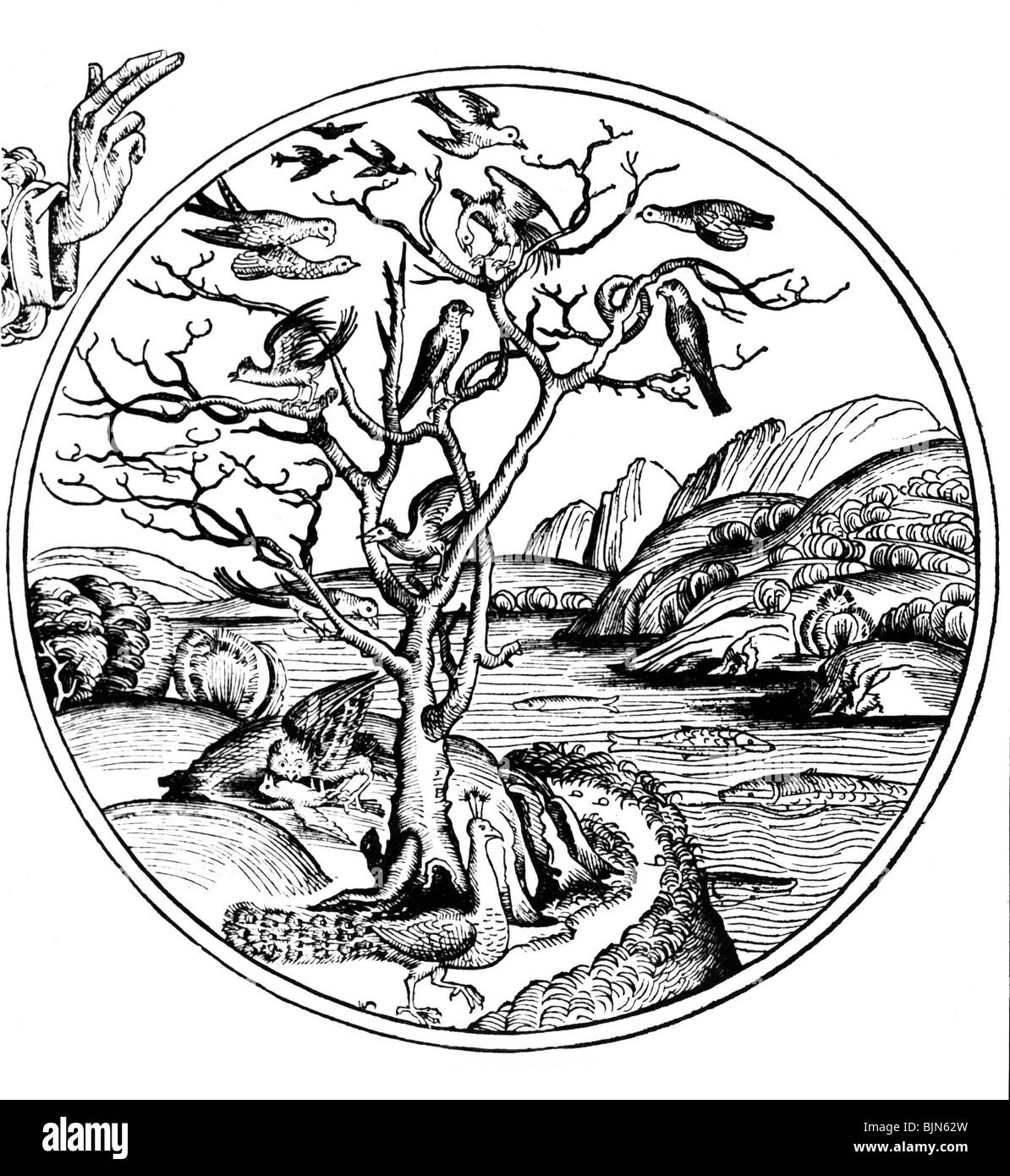 religion, Christianity, creation of the earth, 5th day, woodcut from the 'Nuremberg Chronicle' by Hartmann Schedel, Nuremberg 1493, illustrated by Wohlgemuth and Pleydenwurff, Artist's Copyright has not to be cleared Stock Photohttps://www.alamy.com/image-license-details/?v=1https://www.alamy.com/stock-photo-religion-christianity-creation-of-the-earth-5th-day-woodcut-from-the-28739953.html
religion, Christianity, creation of the earth, 5th day, woodcut from the 'Nuremberg Chronicle' by Hartmann Schedel, Nuremberg 1493, illustrated by Wohlgemuth and Pleydenwurff, Artist's Copyright has not to be cleared Stock Photohttps://www.alamy.com/image-license-details/?v=1https://www.alamy.com/stock-photo-religion-christianity-creation-of-the-earth-5th-day-woodcut-from-the-28739953.htmlRMBJN62W–religion, Christianity, creation of the earth, 5th day, woodcut from the 'Nuremberg Chronicle' by Hartmann Schedel, Nuremberg 1493, illustrated by Wohlgemuth and Pleydenwurff, Artist's Copyright has not to be cleared
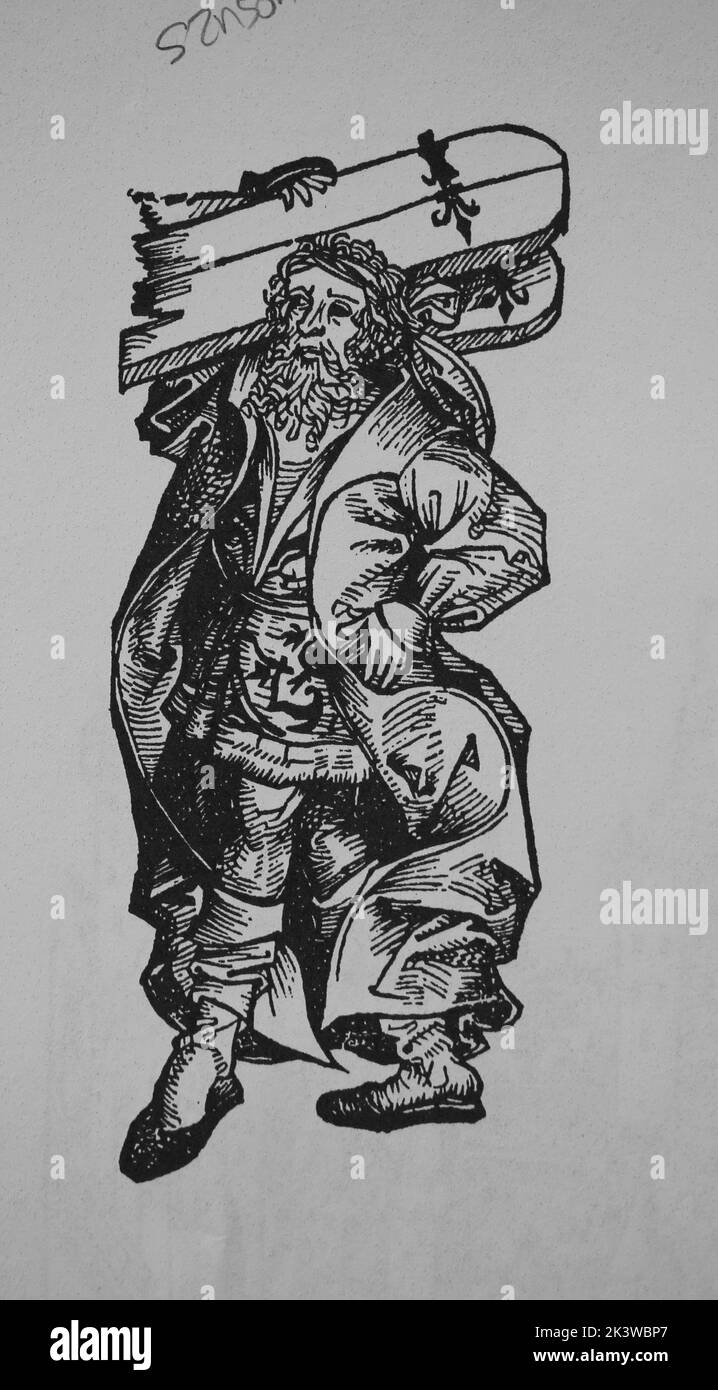 Samson. Last of the judges of the ancient Israelites mentioned in the Book of Judges. Engraving. The Nuremberg Chronicle. 15th century. Stock Photohttps://www.alamy.com/image-license-details/?v=1https://www.alamy.com/samson-last-of-the-judges-of-the-ancient-israelites-mentioned-in-the-book-of-judges-engraving-the-nuremberg-chronicle-15th-century-image484292319.html
Samson. Last of the judges of the ancient Israelites mentioned in the Book of Judges. Engraving. The Nuremberg Chronicle. 15th century. Stock Photohttps://www.alamy.com/image-license-details/?v=1https://www.alamy.com/samson-last-of-the-judges-of-the-ancient-israelites-mentioned-in-the-book-of-judges-engraving-the-nuremberg-chronicle-15th-century-image484292319.htmlRM2K3WBP7–Samson. Last of the judges of the ancient Israelites mentioned in the Book of Judges. Engraving. The Nuremberg Chronicle. 15th century.
 Saint Valentine (from the Nuremberg Chronicle), 1493. Artist: Anonymous Stock Photohttps://www.alamy.com/image-license-details/?v=1https://www.alamy.com/saint-valentine-from-the-nuremberg-chronicle-1493-artist-anonymous-image60389467.html
Saint Valentine (from the Nuremberg Chronicle), 1493. Artist: Anonymous Stock Photohttps://www.alamy.com/image-license-details/?v=1https://www.alamy.com/saint-valentine-from-the-nuremberg-chronicle-1493-artist-anonymous-image60389467.htmlRMDE6YAK–Saint Valentine (from the Nuremberg Chronicle), 1493. Artist: Anonymous
 Three Moons, Nuremberg Chronicle, 1493 Stock Photohttps://www.alamy.com/image-license-details/?v=1https://www.alamy.com/stock-photo-three-moons-nuremberg-chronicle-1493-135093766.html
Three Moons, Nuremberg Chronicle, 1493 Stock Photohttps://www.alamy.com/image-license-details/?v=1https://www.alamy.com/stock-photo-three-moons-nuremberg-chronicle-1493-135093766.htmlRMHRP1DA–Three Moons, Nuremberg Chronicle, 1493
 Beautiful woodcut pages from the 1493 Nuremberg Chronicle, which is an enyclodpedia of world events, mythology and christian history. This extra-ordinary work was one of the earliest books ever printed and the first to successfully integrate text and images. These pages show latin text and an engraving of the German region of Westphalia Stock Photohttps://www.alamy.com/image-license-details/?v=1https://www.alamy.com/beautiful-woodcut-pages-from-the-1493-nuremberg-chronicle-which-is-an-enyclodpedia-of-world-events-mythology-and-christian-history-this-extra-ordinary-work-was-one-of-the-earliest-books-ever-printed-and-the-first-to-successfully-integrate-text-and-images-these-pages-show-latin-text-and-an-engraving-of-the-german-region-of-westphalia-image598932455.html
Beautiful woodcut pages from the 1493 Nuremberg Chronicle, which is an enyclodpedia of world events, mythology and christian history. This extra-ordinary work was one of the earliest books ever printed and the first to successfully integrate text and images. These pages show latin text and an engraving of the German region of Westphalia Stock Photohttps://www.alamy.com/image-license-details/?v=1https://www.alamy.com/beautiful-woodcut-pages-from-the-1493-nuremberg-chronicle-which-is-an-enyclodpedia-of-world-events-mythology-and-christian-history-this-extra-ordinary-work-was-one-of-the-earliest-books-ever-printed-and-the-first-to-successfully-integrate-text-and-images-these-pages-show-latin-text-and-an-engraving-of-the-german-region-of-westphalia-image598932455.htmlRM2WPBMCR–Beautiful woodcut pages from the 1493 Nuremberg Chronicle, which is an enyclodpedia of world events, mythology and christian history. This extra-ordinary work was one of the earliest books ever printed and the first to successfully integrate text and images. These pages show latin text and an engraving of the German region of Westphalia
![HIEROSOLIMA [Jerusalem] and TEPLUM SALOMOIS [Temple of Solomon] woodcut print from a 1493 edition of the Nuremberg Chronicle by Hartmann Schedel (1440-1514). Stock Photo HIEROSOLIMA [Jerusalem] and TEPLUM SALOMOIS [Temple of Solomon] woodcut print from a 1493 edition of the Nuremberg Chronicle by Hartmann Schedel (1440-1514). Stock Photo](https://c8.alamy.com/comp/2A3FC4Y/hierosolima-jerusalem-and-teplum-salomois-temple-of-solomon-woodcut-print-from-a-1493-edition-of-the-nuremberg-chronicle-by-hartmann-schedel-1440-1514-2A3FC4Y.jpg) HIEROSOLIMA [Jerusalem] and TEPLUM SALOMOIS [Temple of Solomon] woodcut print from a 1493 edition of the Nuremberg Chronicle by Hartmann Schedel (1440-1514). Stock Photohttps://www.alamy.com/image-license-details/?v=1https://www.alamy.com/hierosolima-jerusalem-and-teplum-salomois-temple-of-solomon-woodcut-print-from-a-1493-edition-of-the-nuremberg-chronicle-by-hartmann-schedel-1440-1514-image329179787.html
HIEROSOLIMA [Jerusalem] and TEPLUM SALOMOIS [Temple of Solomon] woodcut print from a 1493 edition of the Nuremberg Chronicle by Hartmann Schedel (1440-1514). Stock Photohttps://www.alamy.com/image-license-details/?v=1https://www.alamy.com/hierosolima-jerusalem-and-teplum-salomois-temple-of-solomon-woodcut-print-from-a-1493-edition-of-the-nuremberg-chronicle-by-hartmann-schedel-1440-1514-image329179787.htmlRM2A3FC4Y–HIEROSOLIMA [Jerusalem] and TEPLUM SALOMOIS [Temple of Solomon] woodcut print from a 1493 edition of the Nuremberg Chronicle by Hartmann Schedel (1440-1514).
![. Publius Ovidius Naso and Plato in the Nuremberg Chronicle, also known as the Liber Chronicarum The Morse Library of the Benoit College has a very strict license for the use of images from the book [1]. Despite this, it could well be argued that images from this book is in the public domain since it was published before 1922. . Hartmann Schedel 488 Plato and Ovid (together) Stock Photo . Publius Ovidius Naso and Plato in the Nuremberg Chronicle, also known as the Liber Chronicarum The Morse Library of the Benoit College has a very strict license for the use of images from the book [1]. Despite this, it could well be argued that images from this book is in the public domain since it was published before 1922. . Hartmann Schedel 488 Plato and Ovid (together) Stock Photo](https://c8.alamy.com/comp/MW0GXF/publius-ovidius-naso-and-plato-in-the-nuremberg-chronicle-also-known-as-the-liber-chronicarum-the-morse-library-of-the-benoit-college-has-a-very-strict-license-for-the-use-of-images-from-the-book-1-despite-this-it-could-well-be-argued-that-images-from-this-book-is-in-the-public-domain-since-it-was-published-before-1922-hartmann-schedel-488-plato-and-ovid-together-MW0GXF.jpg) . Publius Ovidius Naso and Plato in the Nuremberg Chronicle, also known as the Liber Chronicarum The Morse Library of the Benoit College has a very strict license for the use of images from the book [1]. Despite this, it could well be argued that images from this book is in the public domain since it was published before 1922. . Hartmann Schedel 488 Plato and Ovid (together) Stock Photohttps://www.alamy.com/image-license-details/?v=1https://www.alamy.com/publius-ovidius-naso-and-plato-in-the-nuremberg-chronicle-also-known-as-the-liber-chronicarum-the-morse-library-of-the-benoit-college-has-a-very-strict-license-for-the-use-of-images-from-the-book-1-despite-this-it-could-well-be-argued-that-images-from-this-book-is-in-the-public-domain-since-it-was-published-before-1922-hartmann-schedel-488-plato-and-ovid-together-image187483367.html
. Publius Ovidius Naso and Plato in the Nuremberg Chronicle, also known as the Liber Chronicarum The Morse Library of the Benoit College has a very strict license for the use of images from the book [1]. Despite this, it could well be argued that images from this book is in the public domain since it was published before 1922. . Hartmann Schedel 488 Plato and Ovid (together) Stock Photohttps://www.alamy.com/image-license-details/?v=1https://www.alamy.com/publius-ovidius-naso-and-plato-in-the-nuremberg-chronicle-also-known-as-the-liber-chronicarum-the-morse-library-of-the-benoit-college-has-a-very-strict-license-for-the-use-of-images-from-the-book-1-despite-this-it-could-well-be-argued-that-images-from-this-book-is-in-the-public-domain-since-it-was-published-before-1922-hartmann-schedel-488-plato-and-ovid-together-image187483367.htmlRMMW0GXF–. Publius Ovidius Naso and Plato in the Nuremberg Chronicle, also known as the Liber Chronicarum The Morse Library of the Benoit College has a very strict license for the use of images from the book [1]. Despite this, it could well be argued that images from this book is in the public domain since it was published before 1922. . Hartmann Schedel 488 Plato and Ovid (together)
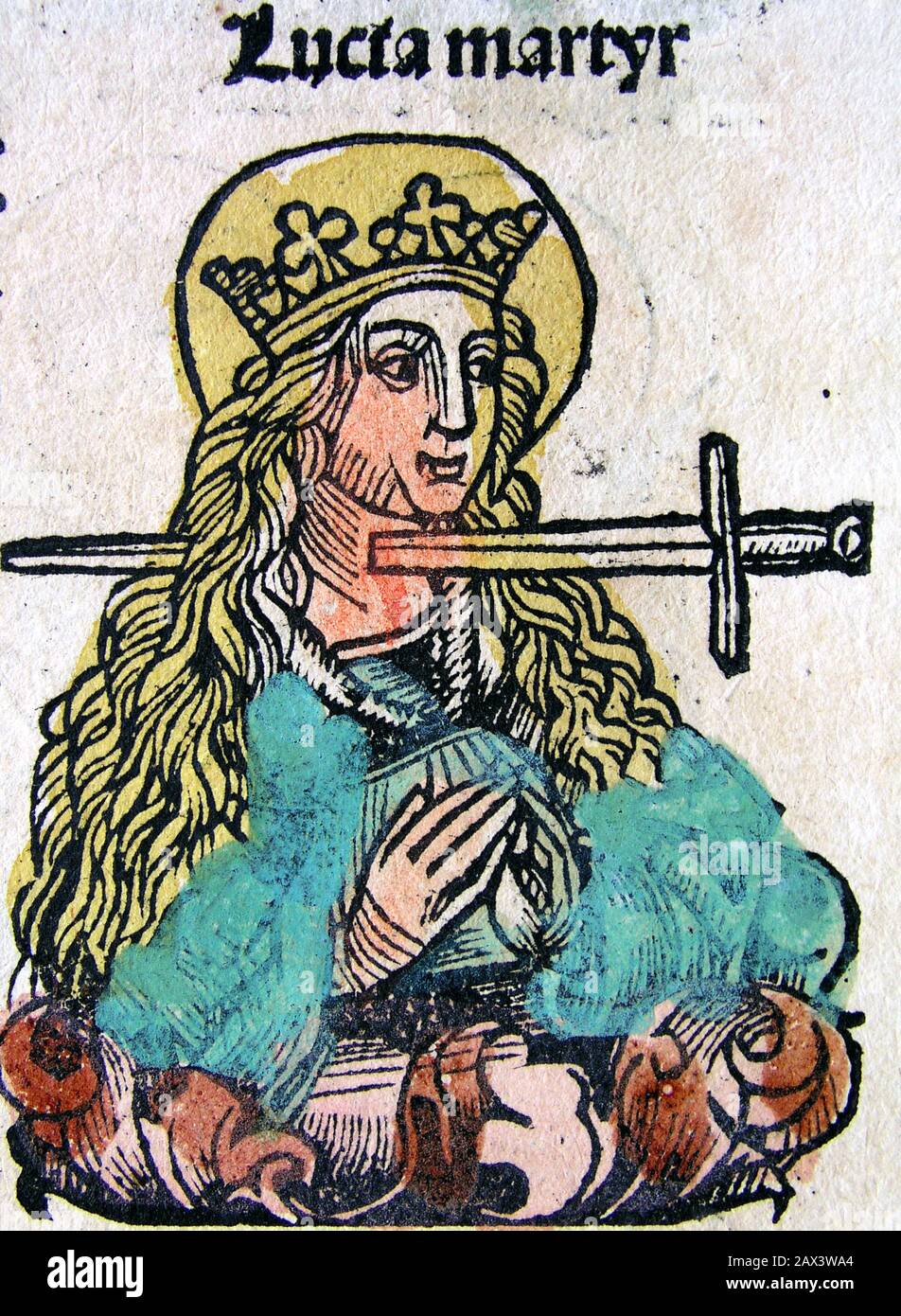 1493 , GERMANY : The ancient roman woman SAINT LUCY ( SANTA LUCIA Martire )( 283 – 304 A.C.) . Fantasy portrait illustration from the Cap. CXXV of book ' Nuremberg Chronicle ' , an illustrated world history that follows the story of human history related in the Bible; it includes the histories of a number of important Western cities. Written in Latin by Hartmann Schedel, with a version in German translation by Georg Alt, it appeared in 1493. It is one of the best-documented early printed books - an incunabulum (printed, not hand-written) - and one of the first to successfully integrate illus Stock Photohttps://www.alamy.com/image-license-details/?v=1https://www.alamy.com/1493-germany-the-ancient-roman-woman-saint-lucy-santa-lucia-martire-283-304-ac-fantasy-portrait-illustration-from-the-cap-cxxv-of-book-nuremberg-chronicle-an-illustrated-world-history-that-follows-the-story-of-human-history-related-in-the-bible-it-includes-the-histories-of-a-number-of-important-western-cities-written-in-latin-by-hartmann-schedel-with-a-version-in-german-translation-by-georg-alt-it-appeared-in-1493-it-is-one-of-the-best-documented-early-printed-books-an-incunabulum-printed-not-hand-written-and-one-of-the-first-to-successfully-integrate-illus-image343063788.html
1493 , GERMANY : The ancient roman woman SAINT LUCY ( SANTA LUCIA Martire )( 283 – 304 A.C.) . Fantasy portrait illustration from the Cap. CXXV of book ' Nuremberg Chronicle ' , an illustrated world history that follows the story of human history related in the Bible; it includes the histories of a number of important Western cities. Written in Latin by Hartmann Schedel, with a version in German translation by Georg Alt, it appeared in 1493. It is one of the best-documented early printed books - an incunabulum (printed, not hand-written) - and one of the first to successfully integrate illus Stock Photohttps://www.alamy.com/image-license-details/?v=1https://www.alamy.com/1493-germany-the-ancient-roman-woman-saint-lucy-santa-lucia-martire-283-304-ac-fantasy-portrait-illustration-from-the-cap-cxxv-of-book-nuremberg-chronicle-an-illustrated-world-history-that-follows-the-story-of-human-history-related-in-the-bible-it-includes-the-histories-of-a-number-of-important-western-cities-written-in-latin-by-hartmann-schedel-with-a-version-in-german-translation-by-georg-alt-it-appeared-in-1493-it-is-one-of-the-best-documented-early-printed-books-an-incunabulum-printed-not-hand-written-and-one-of-the-first-to-successfully-integrate-illus-image343063788.htmlRF2AX3WA4–1493 , GERMANY : The ancient roman woman SAINT LUCY ( SANTA LUCIA Martire )( 283 – 304 A.C.) . Fantasy portrait illustration from the Cap. CXXV of book ' Nuremberg Chronicle ' , an illustrated world history that follows the story of human history related in the Bible; it includes the histories of a number of important Western cities. Written in Latin by Hartmann Schedel, with a version in German translation by Georg Alt, it appeared in 1493. It is one of the best-documented early printed books - an incunabulum (printed, not hand-written) - and one of the first to successfully integrate illus
 Art inspired by Nuremberg Chronicle, Hartmann Schedel, German, 1440-1514, Michael Wolgemut, German, 1434-1519, Wilhelm Pleydenwurff, German, c.1458-1494, Anton Koberger, German, c.1445-1513, 1493, Book with woodcut illustrations, Made in Nuremberg, Bavaria, Germany, Europe, Nuremberg, Classic works modernized by Artotop with a splash of modernity. Shapes, color and value, eye-catching visual impact on art. Emotions through freedom of artworks in a contemporary way. A timeless message pursuing a wildly creative new direction. Artists turning to the digital medium and creating the Artotop NFT Stock Photohttps://www.alamy.com/image-license-details/?v=1https://www.alamy.com/art-inspired-by-nuremberg-chronicle-hartmann-schedel-german-1440-1514-michael-wolgemut-german-1434-1519-wilhelm-pleydenwurff-german-c1458-1494-anton-koberger-german-c1445-1513-1493-book-with-woodcut-illustrations-made-in-nuremberg-bavaria-germany-europe-nuremberg-classic-works-modernized-by-artotop-with-a-splash-of-modernity-shapes-color-and-value-eye-catching-visual-impact-on-art-emotions-through-freedom-of-artworks-in-a-contemporary-way-a-timeless-message-pursuing-a-wildly-creative-new-direction-artists-turning-to-the-digital-medium-and-creating-the-artotop-nft-image459600119.html
Art inspired by Nuremberg Chronicle, Hartmann Schedel, German, 1440-1514, Michael Wolgemut, German, 1434-1519, Wilhelm Pleydenwurff, German, c.1458-1494, Anton Koberger, German, c.1445-1513, 1493, Book with woodcut illustrations, Made in Nuremberg, Bavaria, Germany, Europe, Nuremberg, Classic works modernized by Artotop with a splash of modernity. Shapes, color and value, eye-catching visual impact on art. Emotions through freedom of artworks in a contemporary way. A timeless message pursuing a wildly creative new direction. Artists turning to the digital medium and creating the Artotop NFT Stock Photohttps://www.alamy.com/image-license-details/?v=1https://www.alamy.com/art-inspired-by-nuremberg-chronicle-hartmann-schedel-german-1440-1514-michael-wolgemut-german-1434-1519-wilhelm-pleydenwurff-german-c1458-1494-anton-koberger-german-c1445-1513-1493-book-with-woodcut-illustrations-made-in-nuremberg-bavaria-germany-europe-nuremberg-classic-works-modernized-by-artotop-with-a-splash-of-modernity-shapes-color-and-value-eye-catching-visual-impact-on-art-emotions-through-freedom-of-artworks-in-a-contemporary-way-a-timeless-message-pursuing-a-wildly-creative-new-direction-artists-turning-to-the-digital-medium-and-creating-the-artotop-nft-image459600119.htmlRF2HKMGHY–Art inspired by Nuremberg Chronicle, Hartmann Schedel, German, 1440-1514, Michael Wolgemut, German, 1434-1519, Wilhelm Pleydenwurff, German, c.1458-1494, Anton Koberger, German, c.1445-1513, 1493, Book with woodcut illustrations, Made in Nuremberg, Bavaria, Germany, Europe, Nuremberg, Classic works modernized by Artotop with a splash of modernity. Shapes, color and value, eye-catching visual impact on art. Emotions through freedom of artworks in a contemporary way. A timeless message pursuing a wildly creative new direction. Artists turning to the digital medium and creating the Artotop NFT
 Woodcut of Nuremberg from the Nuremberg Chronicle 1493 - illustrated encyclopedia consisting of world historical accounts, as well as accounts told through biblical paraphrase Stock Photohttps://www.alamy.com/image-license-details/?v=1https://www.alamy.com/woodcut-of-nuremberg-from-the-nuremberg-chronicle-1493-illustrated-encyclopedia-consisting-of-world-historical-accounts-as-well-as-accounts-told-through-biblical-paraphrase-image601521974.html
Woodcut of Nuremberg from the Nuremberg Chronicle 1493 - illustrated encyclopedia consisting of world historical accounts, as well as accounts told through biblical paraphrase Stock Photohttps://www.alamy.com/image-license-details/?v=1https://www.alamy.com/woodcut-of-nuremberg-from-the-nuremberg-chronicle-1493-illustrated-encyclopedia-consisting-of-world-historical-accounts-as-well-as-accounts-told-through-biblical-paraphrase-image601521974.htmlRF2WXHKBJ–Woodcut of Nuremberg from the Nuremberg Chronicle 1493 - illustrated encyclopedia consisting of world historical accounts, as well as accounts told through biblical paraphrase
 schonebrunnen Nuremberg Alemania y praga Prague Belle fontaine German Germany Bavaria monument frauenkirche market square horse Stock Photohttps://www.alamy.com/image-license-details/?v=1https://www.alamy.com/stock-photo-schonebrunnen-nuremberg-alemania-y-praga-prague-belle-fontaine-german-10537926.html
schonebrunnen Nuremberg Alemania y praga Prague Belle fontaine German Germany Bavaria monument frauenkirche market square horse Stock Photohttps://www.alamy.com/image-license-details/?v=1https://www.alamy.com/stock-photo-schonebrunnen-nuremberg-alemania-y-praga-prague-belle-fontaine-german-10537926.htmlRMA2JNFK–schonebrunnen Nuremberg Alemania y praga Prague Belle fontaine German Germany Bavaria monument frauenkirche market square horse
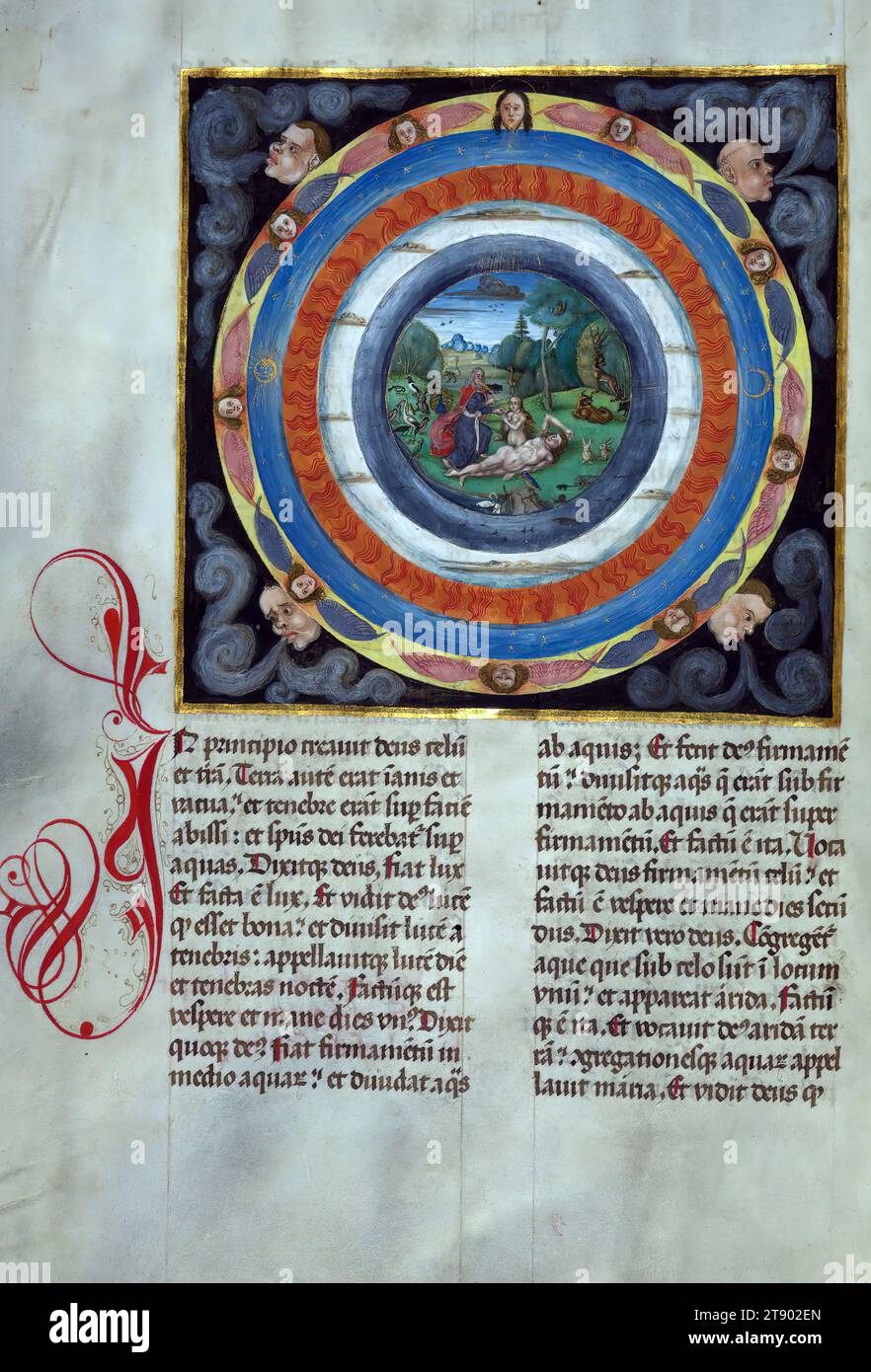 Illuminated Manuscript, Bible (part), Creation of the world, and Eve, This large-scale manuscript contains the first eight Old Testament books, Genesis through Ruth. The date of completion is given, February 2, 1507. The illumination of the Creation within a cosmographic scheme is based in part on the woodcut illustrations of Creation in the 1483 Koberger Bible, and the 1493 Nuremberg Chronicle by the same printer. Large historiated initials mark the beginning of each book Stock Photohttps://www.alamy.com/image-license-details/?v=1https://www.alamy.com/illuminated-manuscript-bible-part-creation-of-the-world-and-eve-this-large-scale-manuscript-contains-the-first-eight-old-testament-books-genesis-through-ruth-the-date-of-completion-is-given-february-2-1507-the-illumination-of-the-creation-within-a-cosmographic-scheme-is-based-in-part-on-the-woodcut-illustrations-of-creation-in-the-1483-koberger-bible-and-the-1493-nuremberg-chronicle-by-the-same-printer-large-historiated-initials-mark-the-beginning-of-each-book-image573476029.html
Illuminated Manuscript, Bible (part), Creation of the world, and Eve, This large-scale manuscript contains the first eight Old Testament books, Genesis through Ruth. The date of completion is given, February 2, 1507. The illumination of the Creation within a cosmographic scheme is based in part on the woodcut illustrations of Creation in the 1483 Koberger Bible, and the 1493 Nuremberg Chronicle by the same printer. Large historiated initials mark the beginning of each book Stock Photohttps://www.alamy.com/image-license-details/?v=1https://www.alamy.com/illuminated-manuscript-bible-part-creation-of-the-world-and-eve-this-large-scale-manuscript-contains-the-first-eight-old-testament-books-genesis-through-ruth-the-date-of-completion-is-given-february-2-1507-the-illumination-of-the-creation-within-a-cosmographic-scheme-is-based-in-part-on-the-woodcut-illustrations-of-creation-in-the-1483-koberger-bible-and-the-1493-nuremberg-chronicle-by-the-same-printer-large-historiated-initials-mark-the-beginning-of-each-book-image573476029.htmlRM2T902EN–Illuminated Manuscript, Bible (part), Creation of the world, and Eve, This large-scale manuscript contains the first eight Old Testament books, Genesis through Ruth. The date of completion is given, February 2, 1507. The illumination of the Creation within a cosmographic scheme is based in part on the woodcut illustrations of Creation in the 1483 Koberger Bible, and the 1493 Nuremberg Chronicle by the same printer. Large historiated initials mark the beginning of each book
 Albertus Magnus (c1200-1280) Italian Dominican friar called 'Doctor Universalis'. Bishop of Ratisbon, 1260, holding open book. Melded theology and Aristotelianism. Woodcut from Hartmann Schedel 'Liber chronicarum mundi' (Nuremberg Chronicle) 1493 Stock Photohttps://www.alamy.com/image-license-details/?v=1https://www.alamy.com/stock-photo-albertus-magnus-c1200-1280-italian-dominican-friar-called-doctor-universalis-57300726.html
Albertus Magnus (c1200-1280) Italian Dominican friar called 'Doctor Universalis'. Bishop of Ratisbon, 1260, holding open book. Melded theology and Aristotelianism. Woodcut from Hartmann Schedel 'Liber chronicarum mundi' (Nuremberg Chronicle) 1493 Stock Photohttps://www.alamy.com/image-license-details/?v=1https://www.alamy.com/stock-photo-albertus-magnus-c1200-1280-italian-dominican-friar-called-doctor-universalis-57300726.htmlRMD967JE–Albertus Magnus (c1200-1280) Italian Dominican friar called 'Doctor Universalis'. Bishop of Ratisbon, 1260, holding open book. Melded theology and Aristotelianism. Woodcut from Hartmann Schedel 'Liber chronicarum mundi' (Nuremberg Chronicle) 1493
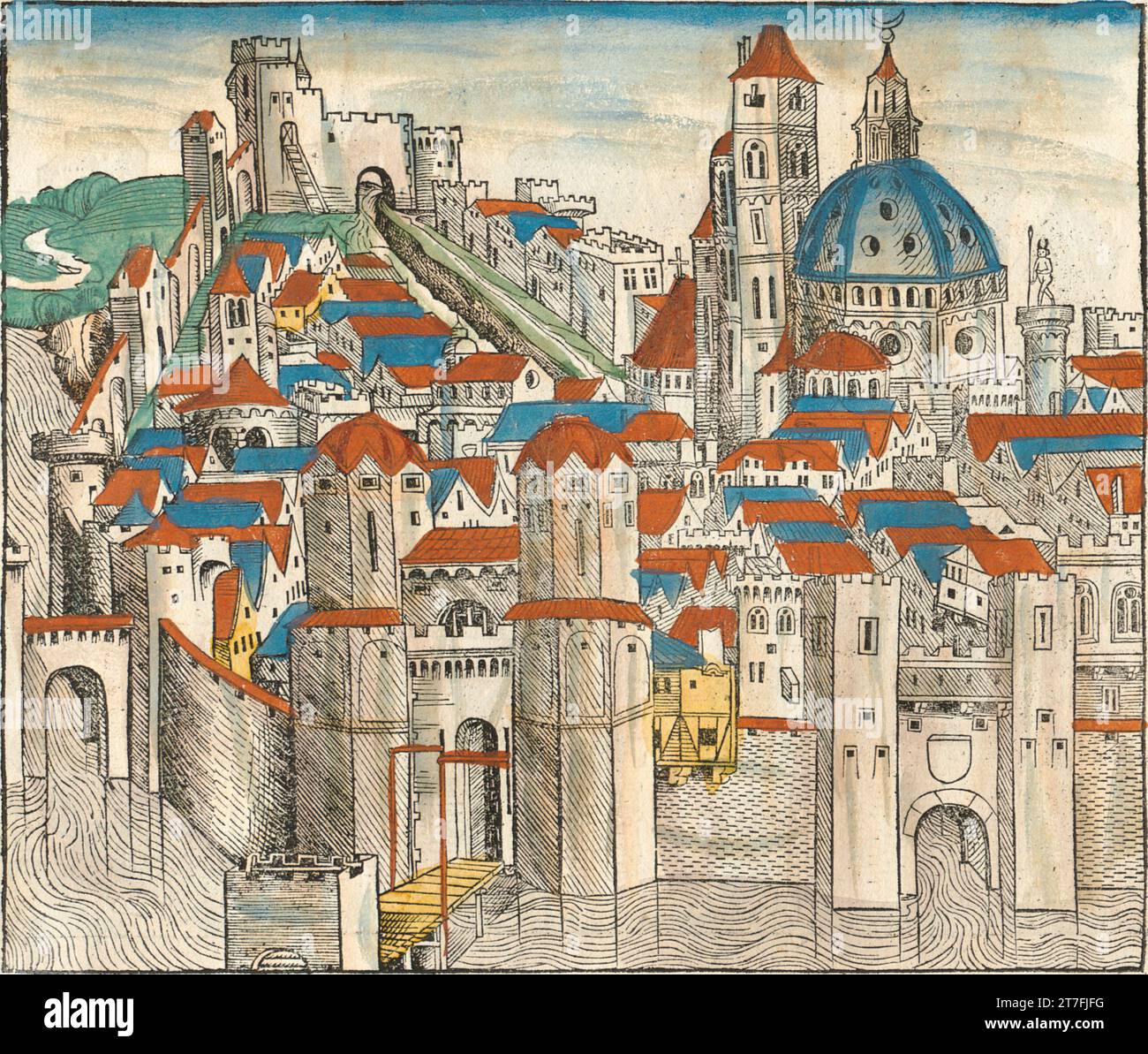 Depiction of Nicaea, Byzantine Empire - Illustration from The Nuremberg Chronicle, 1493. Illustrated by Wilhelm Pleydenwurff and Michael Wolgemut Stock Photohttps://www.alamy.com/image-license-details/?v=1https://www.alamy.com/depiction-of-nicaea-byzantine-empire-illustration-from-the-nuremberg-chronicle-1493-illustrated-by-wilhelm-pleydenwurff-and-michael-wolgemut-image572588564.html
Depiction of Nicaea, Byzantine Empire - Illustration from The Nuremberg Chronicle, 1493. Illustrated by Wilhelm Pleydenwurff and Michael Wolgemut Stock Photohttps://www.alamy.com/image-license-details/?v=1https://www.alamy.com/depiction-of-nicaea-byzantine-empire-illustration-from-the-nuremberg-chronicle-1493-illustrated-by-wilhelm-pleydenwurff-and-michael-wolgemut-image572588564.htmlRF2T7FJFG–Depiction of Nicaea, Byzantine Empire - Illustration from The Nuremberg Chronicle, 1493. Illustrated by Wilhelm Pleydenwurff and Michael Wolgemut
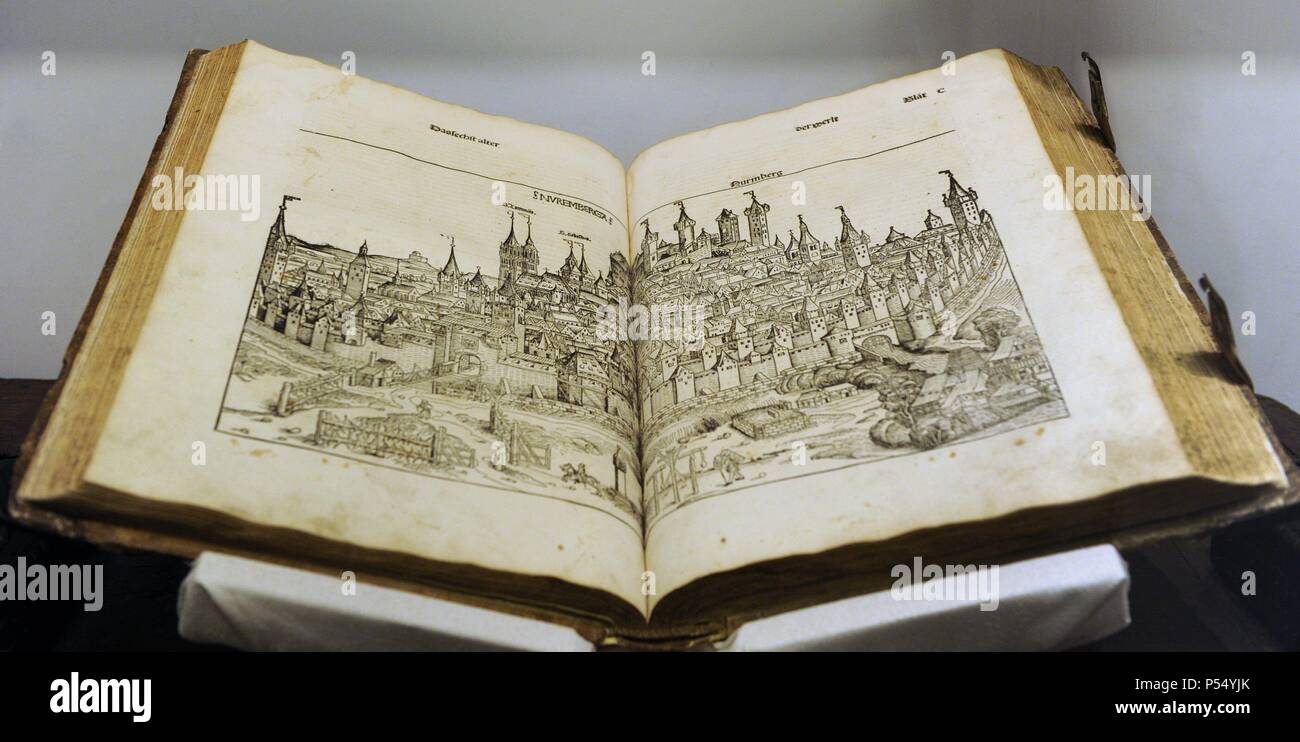 Nuremberg Chronicle. German version, December 23, 1493. Compiled by Hartmann Schedel and engraving by Michael Wolgemuth and Wilhelm Pleydenwurff. Engraving depicting the city of Nuremberg. German Historical Museum. Berlin. Germany. Stock Photohttps://www.alamy.com/image-license-details/?v=1https://www.alamy.com/nuremberg-chronicle-german-version-december-23-1493-compiled-by-hartmann-schedel-and-engraving-by-michael-wolgemuth-and-wilhelm-pleydenwurff-engraving-depicting-the-city-of-nuremberg-german-historical-museum-berlin-germany-image209707195.html
Nuremberg Chronicle. German version, December 23, 1493. Compiled by Hartmann Schedel and engraving by Michael Wolgemuth and Wilhelm Pleydenwurff. Engraving depicting the city of Nuremberg. German Historical Museum. Berlin. Germany. Stock Photohttps://www.alamy.com/image-license-details/?v=1https://www.alamy.com/nuremberg-chronicle-german-version-december-23-1493-compiled-by-hartmann-schedel-and-engraving-by-michael-wolgemuth-and-wilhelm-pleydenwurff-engraving-depicting-the-city-of-nuremberg-german-historical-museum-berlin-germany-image209707195.htmlRMP54YJK–Nuremberg Chronicle. German version, December 23, 1493. Compiled by Hartmann Schedel and engraving by Michael Wolgemuth and Wilhelm Pleydenwurff. Engraving depicting the city of Nuremberg. German Historical Museum. Berlin. Germany.
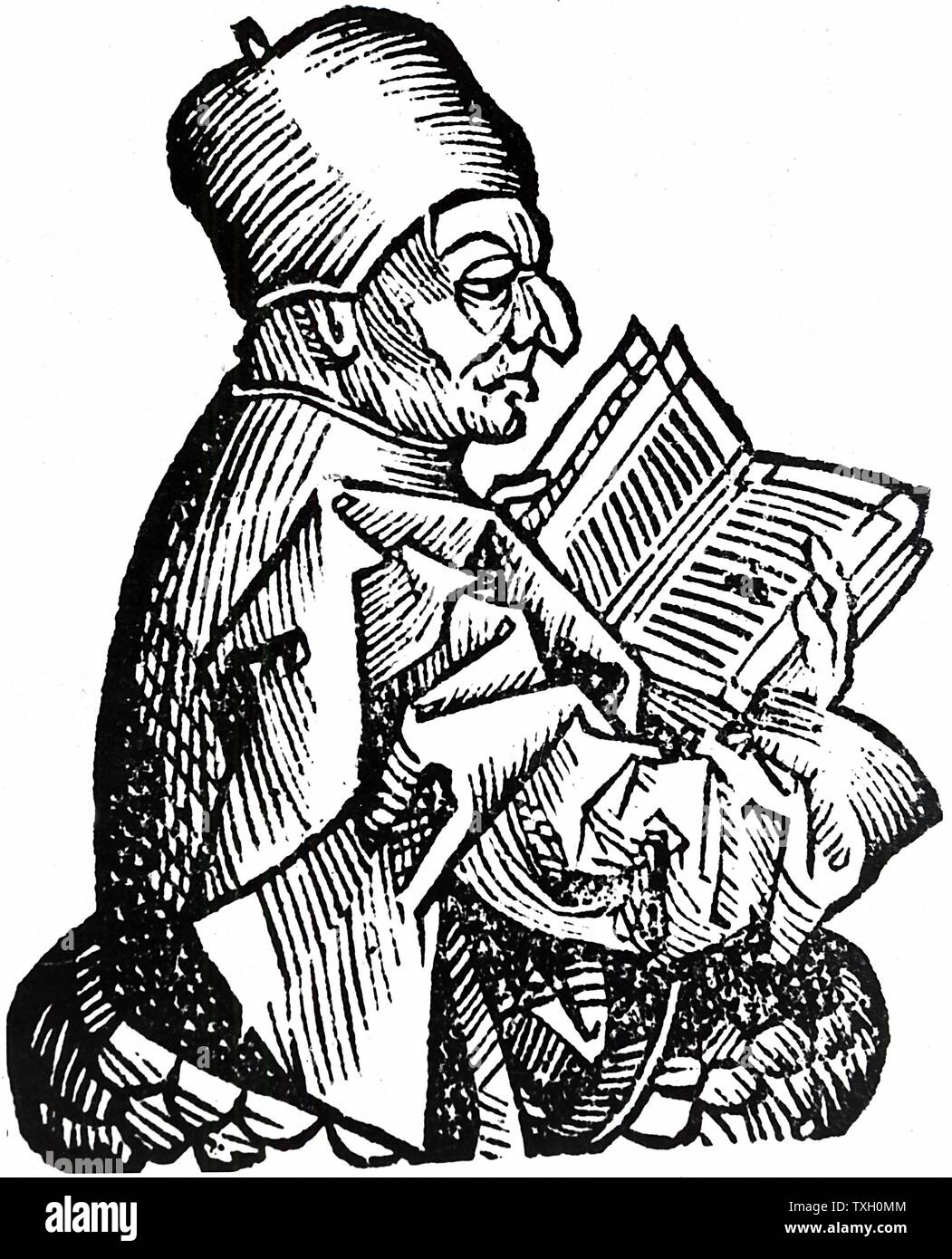 Venerable Bede (c.673-735) Anglo-Saxon theologian, scholar and historian; monk at Jarrow, Northumberland, holding open a book. Woodcut from Hartmann Schedel 'Liber chronicarum mundi' (Nuremberg Chronicle) Nuremberg, 1493 Stock Photohttps://www.alamy.com/image-license-details/?v=1https://www.alamy.com/venerable-bede-c673-735-anglo-saxon-theologian-scholar-and-historian-monk-at-jarrow-northumberland-holding-open-a-book-woodcut-from-hartmann-schedel-liber-chronicarum-mundi-nuremberg-chronicle-nuremberg-1493-image257299972.html
Venerable Bede (c.673-735) Anglo-Saxon theologian, scholar and historian; monk at Jarrow, Northumberland, holding open a book. Woodcut from Hartmann Schedel 'Liber chronicarum mundi' (Nuremberg Chronicle) Nuremberg, 1493 Stock Photohttps://www.alamy.com/image-license-details/?v=1https://www.alamy.com/venerable-bede-c673-735-anglo-saxon-theologian-scholar-and-historian-monk-at-jarrow-northumberland-holding-open-a-book-woodcut-from-hartmann-schedel-liber-chronicarum-mundi-nuremberg-chronicle-nuremberg-1493-image257299972.htmlRMTXH0MM–Venerable Bede (c.673-735) Anglo-Saxon theologian, scholar and historian; monk at Jarrow, Northumberland, holding open a book. Woodcut from Hartmann Schedel 'Liber chronicarum mundi' (Nuremberg Chronicle) Nuremberg, 1493
 Juvenal Nuremberg Chronicle Stock Photohttps://www.alamy.com/image-license-details/?v=1https://www.alamy.com/stock-photo-juvenal-nuremberg-chronicle-142966109.html
Juvenal Nuremberg Chronicle Stock Photohttps://www.alamy.com/image-license-details/?v=1https://www.alamy.com/stock-photo-juvenal-nuremberg-chronicle-142966109.htmlRMJ8GJMD–Juvenal Nuremberg Chronicle
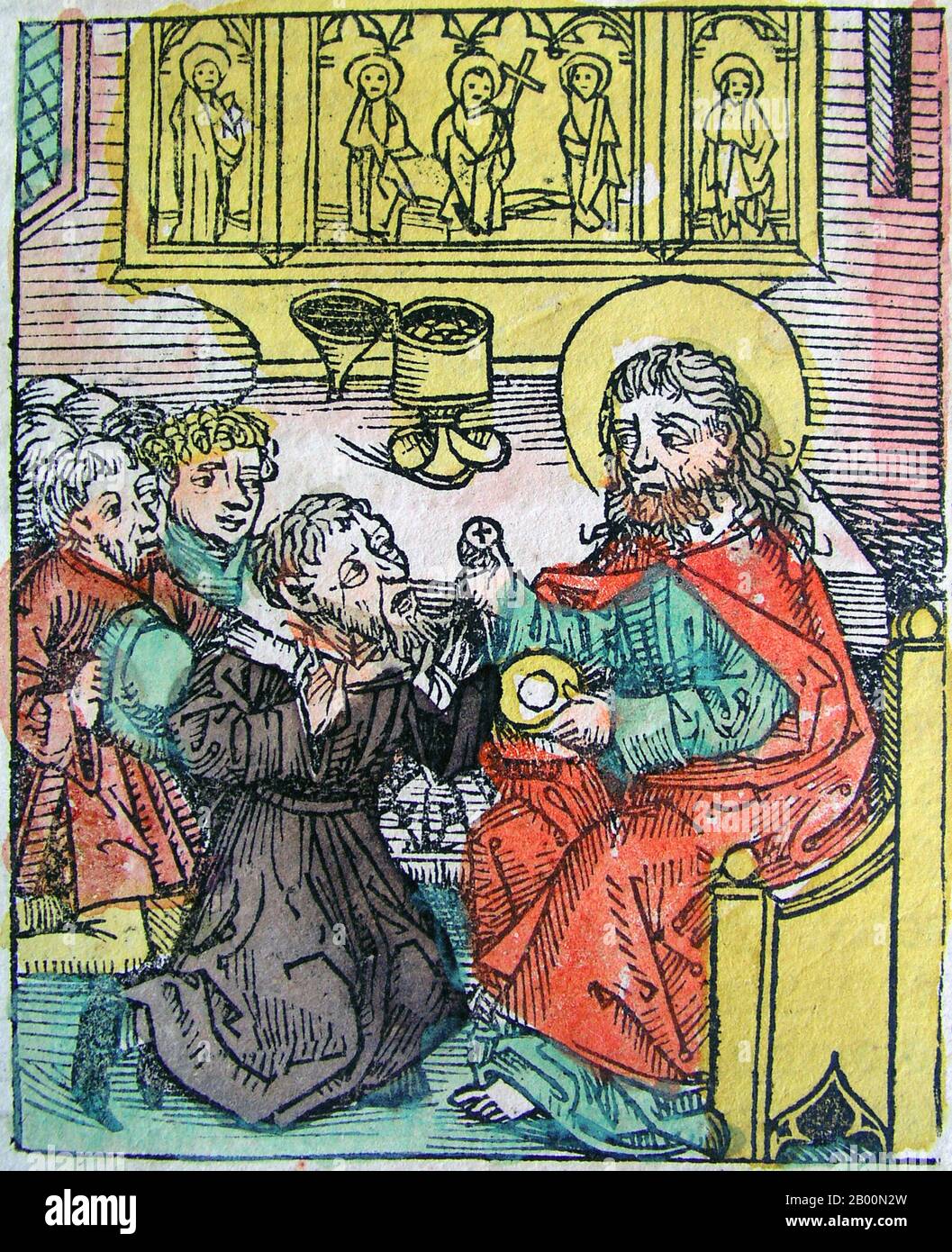 Germany: 'Antipope Burdinus (under Pope Calixtus II)'. The Nuremberg Chronicle, by Hartmann Schedel (1440-1514), 1493. The Nuremberg Chronicle is an illustrated world history. Its structure follows the story of human history as related in the Bible. Written in Latin by Hartmann Schedel, with a version in German translation by Georg Alt, it appeared in 1493. It is one of the best-documented early printed books. It is classified as an incunabulum, a book, pamphlet, or broadside that was printed (not handwritten) before the year 1501 in Europe. Stock Photohttps://www.alamy.com/image-license-details/?v=1https://www.alamy.com/germany-antipope-burdinus-under-pope-calixtus-ii-the-nuremberg-chronicle-by-hartmann-schedel-1440-1514-1493-the-nuremberg-chronicle-is-an-illustrated-world-history-its-structure-follows-the-story-of-human-history-as-related-in-the-bible-written-in-latin-by-hartmann-schedel-with-a-version-in-german-translation-by-georg-alt-it-appeared-in-1493-it-is-one-of-the-best-documented-early-printed-books-it-is-classified-as-an-incunabulum-a-book-pamphlet-or-broadside-that-was-printed-not-handwritten-before-the-year-1501-in-europe-image344223905.html
Germany: 'Antipope Burdinus (under Pope Calixtus II)'. The Nuremberg Chronicle, by Hartmann Schedel (1440-1514), 1493. The Nuremberg Chronicle is an illustrated world history. Its structure follows the story of human history as related in the Bible. Written in Latin by Hartmann Schedel, with a version in German translation by Georg Alt, it appeared in 1493. It is one of the best-documented early printed books. It is classified as an incunabulum, a book, pamphlet, or broadside that was printed (not handwritten) before the year 1501 in Europe. Stock Photohttps://www.alamy.com/image-license-details/?v=1https://www.alamy.com/germany-antipope-burdinus-under-pope-calixtus-ii-the-nuremberg-chronicle-by-hartmann-schedel-1440-1514-1493-the-nuremberg-chronicle-is-an-illustrated-world-history-its-structure-follows-the-story-of-human-history-as-related-in-the-bible-written-in-latin-by-hartmann-schedel-with-a-version-in-german-translation-by-georg-alt-it-appeared-in-1493-it-is-one-of-the-best-documented-early-printed-books-it-is-classified-as-an-incunabulum-a-book-pamphlet-or-broadside-that-was-printed-not-handwritten-before-the-year-1501-in-europe-image344223905.htmlRM2B00N2W–Germany: 'Antipope Burdinus (under Pope Calixtus II)'. The Nuremberg Chronicle, by Hartmann Schedel (1440-1514), 1493. The Nuremberg Chronicle is an illustrated world history. Its structure follows the story of human history as related in the Bible. Written in Latin by Hartmann Schedel, with a version in German translation by Georg Alt, it appeared in 1493. It is one of the best-documented early printed books. It is classified as an incunabulum, a book, pamphlet, or broadside that was printed (not handwritten) before the year 1501 in Europe.
 Speusippus Nuremberg Chronicle Stock Photohttps://www.alamy.com/image-license-details/?v=1https://www.alamy.com/stock-photo-speusippus-nuremberg-chronicle-140490097.html
Speusippus Nuremberg Chronicle Stock Photohttps://www.alamy.com/image-license-details/?v=1https://www.alamy.com/stock-photo-speusippus-nuremberg-chronicle-140490097.htmlRMJ4FTFD–Speusippus Nuremberg Chronicle
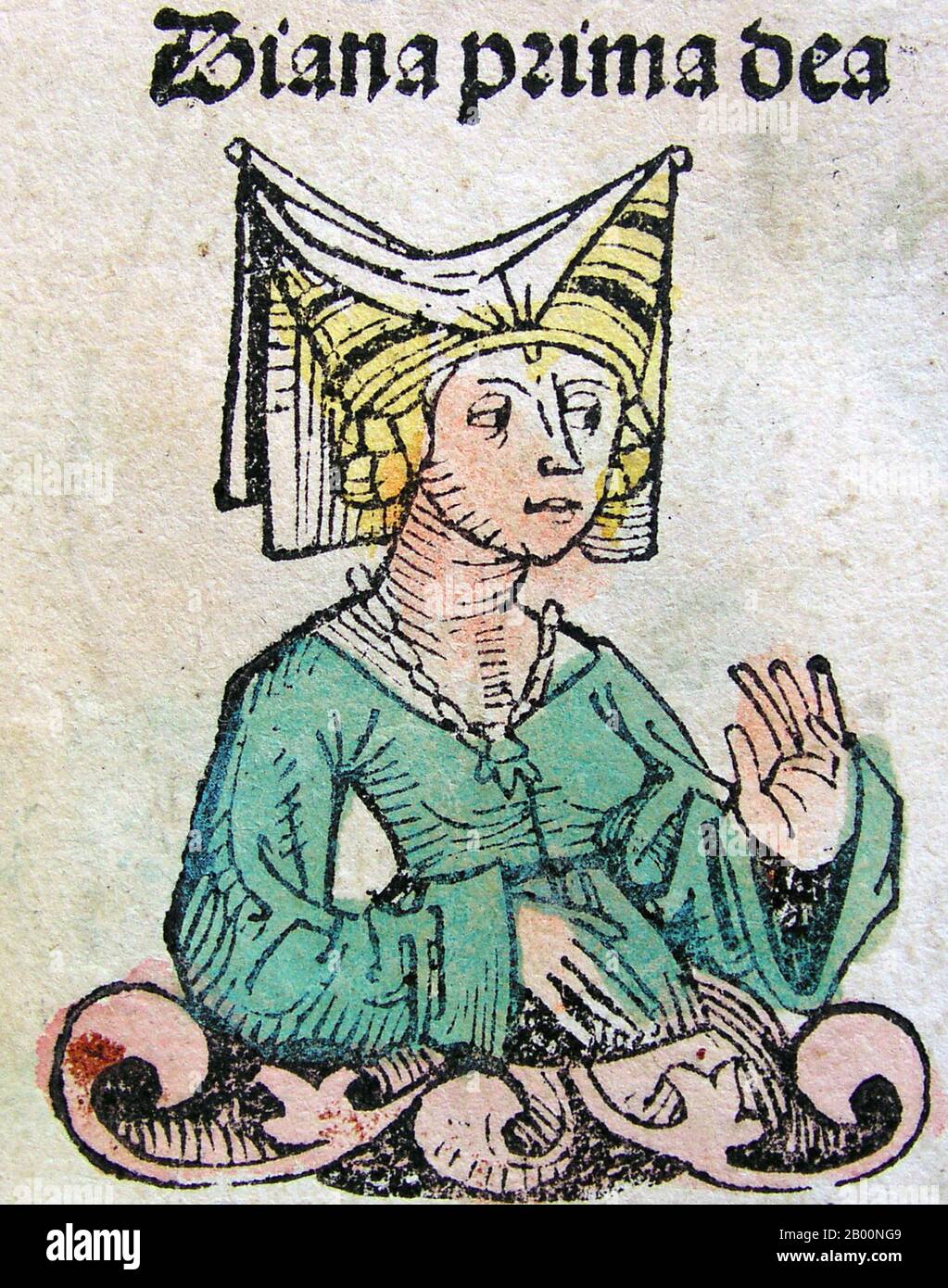 Germany: 'Diana'. The Nuremberg Chronicle, by Hartmann Schedel (1440-1514), 1493. The Nuremberg Chronicle is an illustrated world history. Its structure follows the story of human history as related in the Bible, including the histories of a number of important Western cities. Written in Latin by Hartmann Schedel, with a version in German translation by Georg Alt, it appeared in 1493. It is one of the best-documented early printed books. It is classified as an incunabulum, a book, pamphlet, or broadside that was printed (not handwritten) before the year 1501 in Europe. Stock Photohttps://www.alamy.com/image-license-details/?v=1https://www.alamy.com/germany-diana-the-nuremberg-chronicle-by-hartmann-schedel-1440-1514-1493-the-nuremberg-chronicle-is-an-illustrated-world-history-its-structure-follows-the-story-of-human-history-as-related-in-the-bible-including-the-histories-of-a-number-of-important-western-cities-written-in-latin-by-hartmann-schedel-with-a-version-in-german-translation-by-georg-alt-it-appeared-in-1493-it-is-one-of-the-best-documented-early-printed-books-it-is-classified-as-an-incunabulum-a-book-pamphlet-or-broadside-that-was-printed-not-handwritten-before-the-year-1501-in-europe-image344224281.html
Germany: 'Diana'. The Nuremberg Chronicle, by Hartmann Schedel (1440-1514), 1493. The Nuremberg Chronicle is an illustrated world history. Its structure follows the story of human history as related in the Bible, including the histories of a number of important Western cities. Written in Latin by Hartmann Schedel, with a version in German translation by Georg Alt, it appeared in 1493. It is one of the best-documented early printed books. It is classified as an incunabulum, a book, pamphlet, or broadside that was printed (not handwritten) before the year 1501 in Europe. Stock Photohttps://www.alamy.com/image-license-details/?v=1https://www.alamy.com/germany-diana-the-nuremberg-chronicle-by-hartmann-schedel-1440-1514-1493-the-nuremberg-chronicle-is-an-illustrated-world-history-its-structure-follows-the-story-of-human-history-as-related-in-the-bible-including-the-histories-of-a-number-of-important-western-cities-written-in-latin-by-hartmann-schedel-with-a-version-in-german-translation-by-georg-alt-it-appeared-in-1493-it-is-one-of-the-best-documented-early-printed-books-it-is-classified-as-an-incunabulum-a-book-pamphlet-or-broadside-that-was-printed-not-handwritten-before-the-year-1501-in-europe-image344224281.htmlRM2B00NG9–Germany: 'Diana'. The Nuremberg Chronicle, by Hartmann Schedel (1440-1514), 1493. The Nuremberg Chronicle is an illustrated world history. Its structure follows the story of human history as related in the Bible, including the histories of a number of important Western cities. Written in Latin by Hartmann Schedel, with a version in German translation by Georg Alt, it appeared in 1493. It is one of the best-documented early printed books. It is classified as an incunabulum, a book, pamphlet, or broadside that was printed (not handwritten) before the year 1501 in Europe.
 Budapest. Nuremberg Chronicle, 1494. Stock Photohttps://www.alamy.com/image-license-details/?v=1https://www.alamy.com/budapest-nuremberg-chronicle-1494-image483584018.html
Budapest. Nuremberg Chronicle, 1494. Stock Photohttps://www.alamy.com/image-license-details/?v=1https://www.alamy.com/budapest-nuremberg-chronicle-1494-image483584018.htmlRM2K2N49P–Budapest. Nuremberg Chronicle, 1494.
 Johannes XI, + December 935, Pope 931 - 935, half-length, woodcut by Michael Wolgemut or Wilhelm Pleydenwurff to the chronicle of Hartmann Schedel, Nuremberg, 1493, Artist's Copyright has not to be cleared Stock Photohttps://www.alamy.com/image-license-details/?v=1https://www.alamy.com/johannes-xi-december-935-pope-931-935-half-length-woodcut-by-michael-wolgemut-or-wilhelm-pleydenwurff-to-the-chronicle-of-hartmann-schedel-nuremberg-1493-artists-copyright-has-not-to-be-cleared-image239377334.html
Johannes XI, + December 935, Pope 931 - 935, half-length, woodcut by Michael Wolgemut or Wilhelm Pleydenwurff to the chronicle of Hartmann Schedel, Nuremberg, 1493, Artist's Copyright has not to be cleared Stock Photohttps://www.alamy.com/image-license-details/?v=1https://www.alamy.com/johannes-xi-december-935-pope-931-935-half-length-woodcut-by-michael-wolgemut-or-wilhelm-pleydenwurff-to-the-chronicle-of-hartmann-schedel-nuremberg-1493-artists-copyright-has-not-to-be-cleared-image239377334.htmlRMRWCG6E–Johannes XI, + December 935, Pope 931 - 935, half-length, woodcut by Michael Wolgemut or Wilhelm Pleydenwurff to the chronicle of Hartmann Schedel, Nuremberg, 1493, Artist's Copyright has not to be cleared
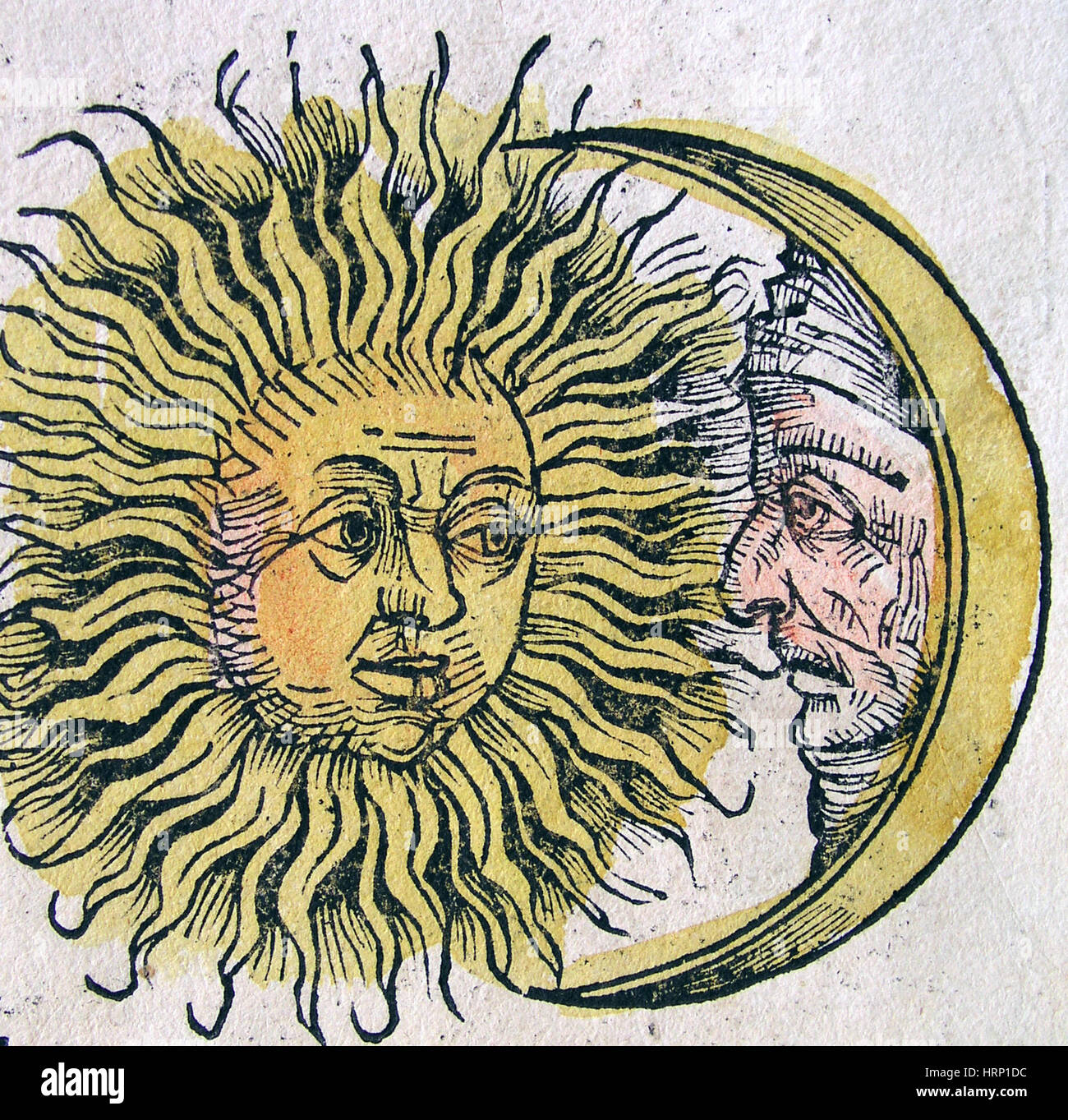 Sun and Moon, Nuremberg Chronicle, 1493 Stock Photohttps://www.alamy.com/image-license-details/?v=1https://www.alamy.com/stock-photo-sun-and-moon-nuremberg-chronicle-1493-135093768.html
Sun and Moon, Nuremberg Chronicle, 1493 Stock Photohttps://www.alamy.com/image-license-details/?v=1https://www.alamy.com/stock-photo-sun-and-moon-nuremberg-chronicle-1493-135093768.htmlRMHRP1DC–Sun and Moon, Nuremberg Chronicle, 1493
 Beautiful woodcut pages from the 1493 Nuremberg Chronicle, which is an enyclodpedia of world events, mythology and christian history. This extra-ordinary work was one of the earliest books ever printed and the first to successfully integrate text and images. These pages show latin text and an engraving of the town of Perugia in Italy Stock Photohttps://www.alamy.com/image-license-details/?v=1https://www.alamy.com/beautiful-woodcut-pages-from-the-1493-nuremberg-chronicle-which-is-an-enyclodpedia-of-world-events-mythology-and-christian-history-this-extra-ordinary-work-was-one-of-the-earliest-books-ever-printed-and-the-first-to-successfully-integrate-text-and-images-these-pages-show-latin-text-and-an-engraving-of-the-town-of-perugia-in-italy-image598932362.html
Beautiful woodcut pages from the 1493 Nuremberg Chronicle, which is an enyclodpedia of world events, mythology and christian history. This extra-ordinary work was one of the earliest books ever printed and the first to successfully integrate text and images. These pages show latin text and an engraving of the town of Perugia in Italy Stock Photohttps://www.alamy.com/image-license-details/?v=1https://www.alamy.com/beautiful-woodcut-pages-from-the-1493-nuremberg-chronicle-which-is-an-enyclodpedia-of-world-events-mythology-and-christian-history-this-extra-ordinary-work-was-one-of-the-earliest-books-ever-printed-and-the-first-to-successfully-integrate-text-and-images-these-pages-show-latin-text-and-an-engraving-of-the-town-of-perugia-in-italy-image598932362.htmlRM2WPBM9E–Beautiful woodcut pages from the 1493 Nuremberg Chronicle, which is an enyclodpedia of world events, mythology and christian history. This extra-ordinary work was one of the earliest books ever printed and the first to successfully integrate text and images. These pages show latin text and an engraving of the town of Perugia in Italy
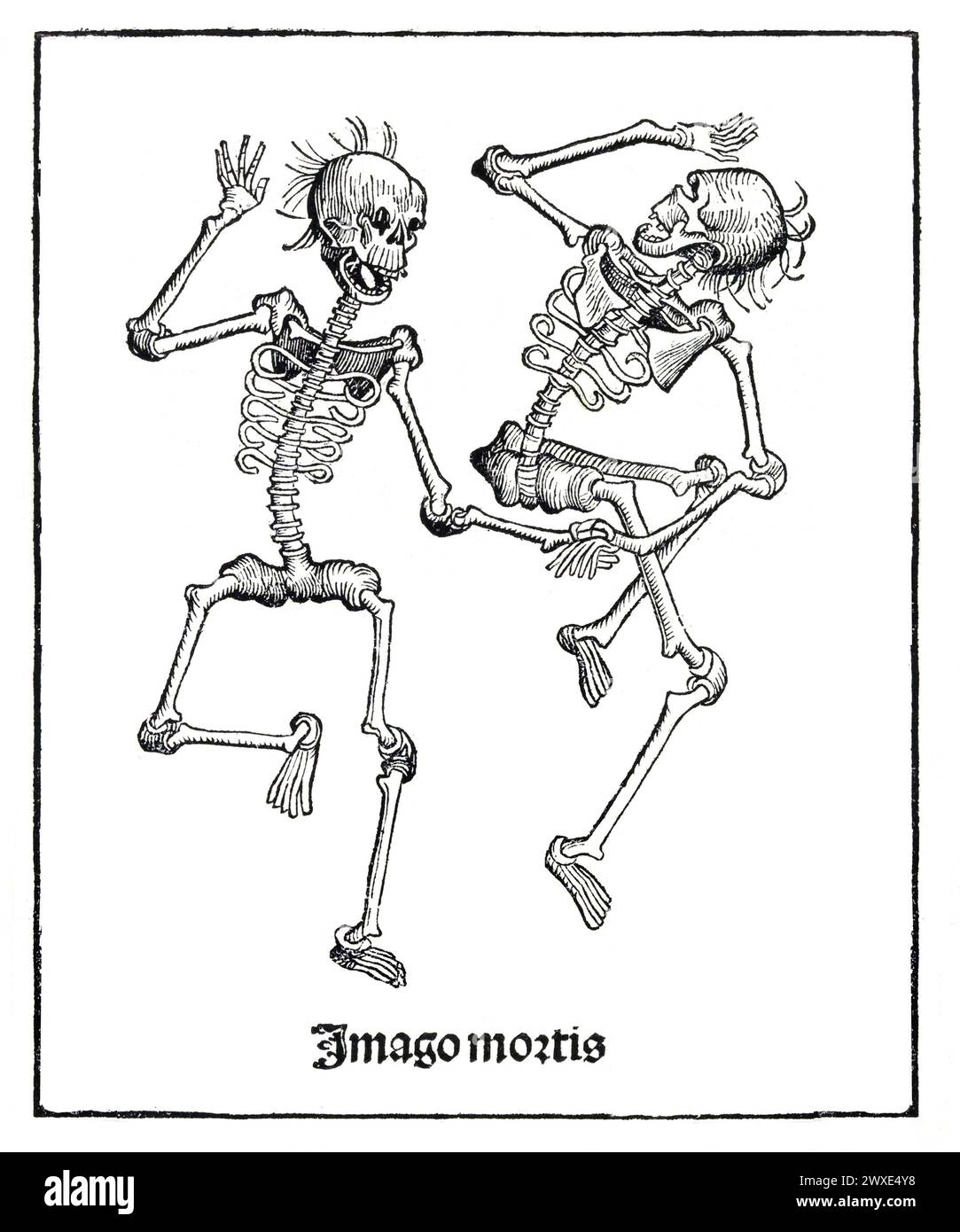 Unique modified version of an antique letterpress print of Dancing Skeletons. 'Imago mortis' The woodcut is used as a book illustration in Hartmann Schedel's Liber Chronicarum (or Nuremberg Chronicle), published in Latin and German in 1493. Print maker: workshop of Michel Wolgemut and Wilhelm Pleydenwurff, Nuremburg, Germany. Stock Photohttps://www.alamy.com/image-license-details/?v=1https://www.alamy.com/unique-modified-version-of-an-antique-letterpress-print-of-dancing-skeletons-imago-mortis-the-woodcut-is-used-as-a-book-illustration-in-hartmann-schedels-liber-chronicarum-or-nuremberg-chronicle-published-in-latin-and-german-in-1493-print-maker-workshop-of-michel-wolgemut-and-wilhelm-pleydenwurff-nuremburg-germany-image601444796.html
Unique modified version of an antique letterpress print of Dancing Skeletons. 'Imago mortis' The woodcut is used as a book illustration in Hartmann Schedel's Liber Chronicarum (or Nuremberg Chronicle), published in Latin and German in 1493. Print maker: workshop of Michel Wolgemut and Wilhelm Pleydenwurff, Nuremburg, Germany. Stock Photohttps://www.alamy.com/image-license-details/?v=1https://www.alamy.com/unique-modified-version-of-an-antique-letterpress-print-of-dancing-skeletons-imago-mortis-the-woodcut-is-used-as-a-book-illustration-in-hartmann-schedels-liber-chronicarum-or-nuremberg-chronicle-published-in-latin-and-german-in-1493-print-maker-workshop-of-michel-wolgemut-and-wilhelm-pleydenwurff-nuremburg-germany-image601444796.htmlRM2WXE4Y8–Unique modified version of an antique letterpress print of Dancing Skeletons. 'Imago mortis' The woodcut is used as a book illustration in Hartmann Schedel's Liber Chronicarum (or Nuremberg Chronicle), published in Latin and German in 1493. Print maker: workshop of Michel Wolgemut and Wilhelm Pleydenwurff, Nuremburg, Germany.
![. Publius Ovidius Naso and Plato in the Nuremberg Chronicle, also known as the Liber Chronicarum The Morse Library of the Benoit College has a very strict license for the use of images from the book [1]. Despite this, it could well be argued that images from this book is in the public domain since it was published before 1922. . Hartmann Schedel 489 Plato and Ovid (together) Stock Photo . Publius Ovidius Naso and Plato in the Nuremberg Chronicle, also known as the Liber Chronicarum The Morse Library of the Benoit College has a very strict license for the use of images from the book [1]. Despite this, it could well be argued that images from this book is in the public domain since it was published before 1922. . Hartmann Schedel 489 Plato and Ovid (together) Stock Photo](https://c8.alamy.com/comp/MWMC35/publius-ovidius-naso-and-plato-in-the-nuremberg-chronicle-also-known-as-the-liber-chronicarum-the-morse-library-of-the-benoit-college-has-a-very-strict-license-for-the-use-of-images-from-the-book-1-despite-this-it-could-well-be-argued-that-images-from-this-book-is-in-the-public-domain-since-it-was-published-before-1922-hartmann-schedel-489-plato-and-ovid-together-MWMC35.jpg) . Publius Ovidius Naso and Plato in the Nuremberg Chronicle, also known as the Liber Chronicarum The Morse Library of the Benoit College has a very strict license for the use of images from the book [1]. Despite this, it could well be argued that images from this book is in the public domain since it was published before 1922. . Hartmann Schedel 489 Plato and Ovid (together) Stock Photohttps://www.alamy.com/image-license-details/?v=1https://www.alamy.com/publius-ovidius-naso-and-plato-in-the-nuremberg-chronicle-also-known-as-the-liber-chronicarum-the-morse-library-of-the-benoit-college-has-a-very-strict-license-for-the-use-of-images-from-the-book-1-despite-this-it-could-well-be-argued-that-images-from-this-book-is-in-the-public-domain-since-it-was-published-before-1922-hartmann-schedel-489-plato-and-ovid-together-image187918617.html
. Publius Ovidius Naso and Plato in the Nuremberg Chronicle, also known as the Liber Chronicarum The Morse Library of the Benoit College has a very strict license for the use of images from the book [1]. Despite this, it could well be argued that images from this book is in the public domain since it was published before 1922. . Hartmann Schedel 489 Plato and Ovid (together) Stock Photohttps://www.alamy.com/image-license-details/?v=1https://www.alamy.com/publius-ovidius-naso-and-plato-in-the-nuremberg-chronicle-also-known-as-the-liber-chronicarum-the-morse-library-of-the-benoit-college-has-a-very-strict-license-for-the-use-of-images-from-the-book-1-despite-this-it-could-well-be-argued-that-images-from-this-book-is-in-the-public-domain-since-it-was-published-before-1922-hartmann-schedel-489-plato-and-ovid-together-image187918617.htmlRMMWMC35–. Publius Ovidius Naso and Plato in the Nuremberg Chronicle, also known as the Liber Chronicarum The Morse Library of the Benoit College has a very strict license for the use of images from the book [1]. Despite this, it could well be argued that images from this book is in the public domain since it was published before 1922. . Hartmann Schedel 489 Plato and Ovid (together)
 Gezicht op Jeruzalem Liber Chronicarum (serietitel) View of the city of Jerusalem. Left the temple of Solomon. The print is part of a album. Manufacturer : printmaker Michel Wolgemut (studio) printmaker: Wilhelm Pleydenwurff (workshop) Place manufacture: Nuremberg Date: 1493 Physical features: woodcut pasted on album leaf; verso with woodcut material: paper Technique: letterpress / woodcut / paste dimensions: print: H 142 mm × W 223 mmToelichtingDe woodcut is used frequently as a book illustration in the Liber Chronicarum (or Nuremberg Chronicle) by Hartmann Schedel, published in Latin and Ger Stock Photohttps://www.alamy.com/image-license-details/?v=1https://www.alamy.com/gezicht-op-jeruzalem-liber-chronicarum-serietitel-view-of-the-city-of-jerusalem-left-the-temple-of-solomon-the-print-is-part-of-a-album-manufacturer-printmaker-michel-wolgemut-studio-printmaker-wilhelm-pleydenwurff-workshop-place-manufacture-nuremberg-date-1493-physical-features-woodcut-pasted-on-album-leaf-verso-with-woodcut-material-paper-technique-letterpress-woodcut-paste-dimensions-print-h-142-mm-w-223-mmtoelichtingde-woodcut-is-used-frequently-as-a-book-illustration-in-the-liber-chronicarum-or-nuremberg-chronicle-by-hartmann-schedel-published-in-latin-and-ger-image348383839.html
Gezicht op Jeruzalem Liber Chronicarum (serietitel) View of the city of Jerusalem. Left the temple of Solomon. The print is part of a album. Manufacturer : printmaker Michel Wolgemut (studio) printmaker: Wilhelm Pleydenwurff (workshop) Place manufacture: Nuremberg Date: 1493 Physical features: woodcut pasted on album leaf; verso with woodcut material: paper Technique: letterpress / woodcut / paste dimensions: print: H 142 mm × W 223 mmToelichtingDe woodcut is used frequently as a book illustration in the Liber Chronicarum (or Nuremberg Chronicle) by Hartmann Schedel, published in Latin and Ger Stock Photohttps://www.alamy.com/image-license-details/?v=1https://www.alamy.com/gezicht-op-jeruzalem-liber-chronicarum-serietitel-view-of-the-city-of-jerusalem-left-the-temple-of-solomon-the-print-is-part-of-a-album-manufacturer-printmaker-michel-wolgemut-studio-printmaker-wilhelm-pleydenwurff-workshop-place-manufacture-nuremberg-date-1493-physical-features-woodcut-pasted-on-album-leaf-verso-with-woodcut-material-paper-technique-letterpress-woodcut-paste-dimensions-print-h-142-mm-w-223-mmtoelichtingde-woodcut-is-used-frequently-as-a-book-illustration-in-the-liber-chronicarum-or-nuremberg-chronicle-by-hartmann-schedel-published-in-latin-and-ger-image348383839.htmlRM2B6P73Y–Gezicht op Jeruzalem Liber Chronicarum (serietitel) View of the city of Jerusalem. Left the temple of Solomon. The print is part of a album. Manufacturer : printmaker Michel Wolgemut (studio) printmaker: Wilhelm Pleydenwurff (workshop) Place manufacture: Nuremberg Date: 1493 Physical features: woodcut pasted on album leaf; verso with woodcut material: paper Technique: letterpress / woodcut / paste dimensions: print: H 142 mm × W 223 mmToelichtingDe woodcut is used frequently as a book illustration in the Liber Chronicarum (or Nuremberg Chronicle) by Hartmann Schedel, published in Latin and Ger
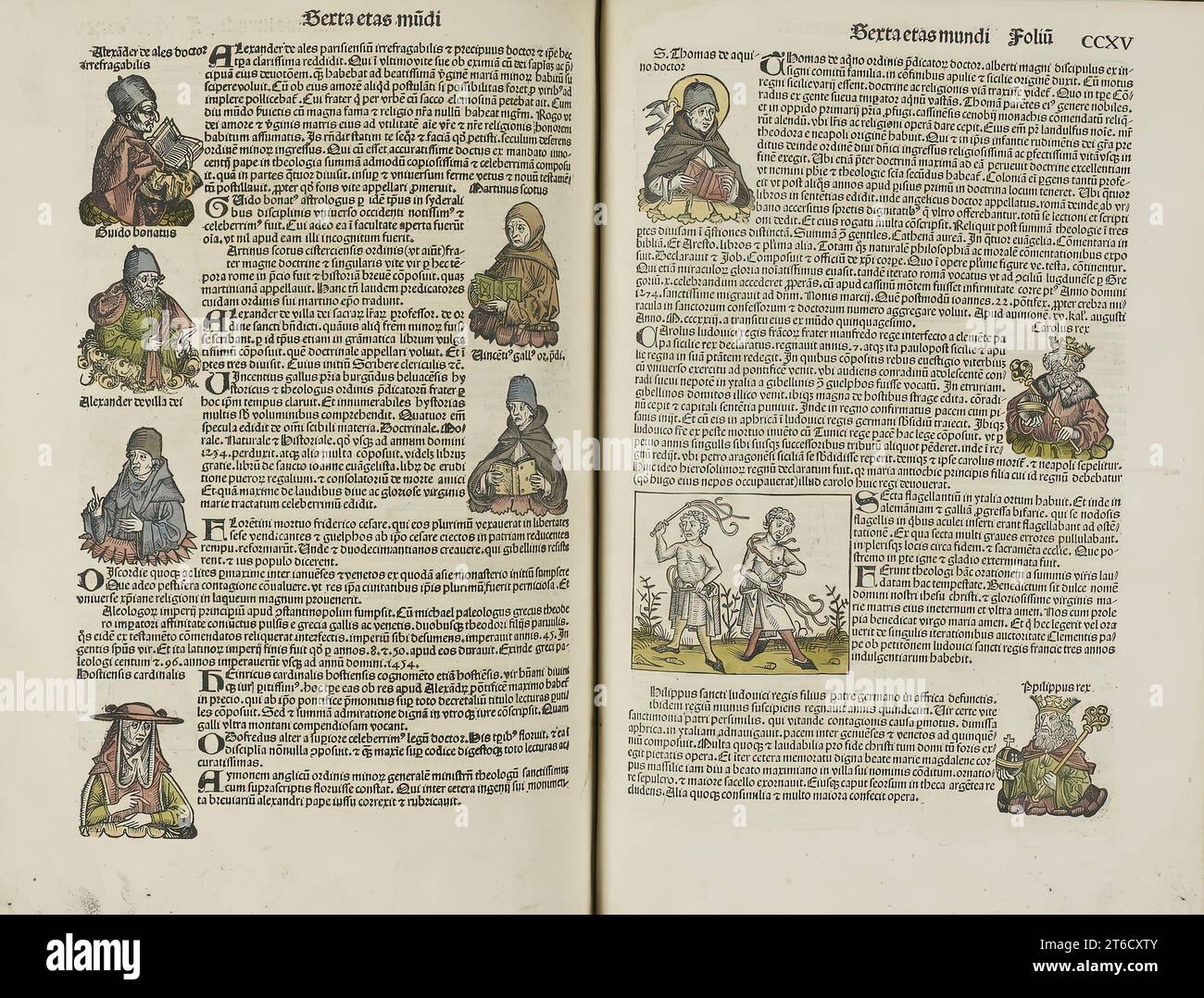 Two pages from the Liber chronicarum, 1493. The Liber chronicarum or Nuremberg Chronicle is a history of the world divided into seven ages within the framework of the biblical narrative beginning with the Creation and ending with the Last Judgment. The book project was commissioned by two Nuremberg merchants: Sebald Schreyer (1446-1503) and his son-in-law, Sebastian Kammermeister (1446-1520). The Latin text was composed by Hartmann Schedel (1440-1514), a medical doctor and humanist, and translated into German by George Alt (1450-1510), a scribe at the Nuremberg treasury. Stock Photohttps://www.alamy.com/image-license-details/?v=1https://www.alamy.com/two-pages-from-the-liber-chronicarum-1493-the-liber-chronicarum-or-nuremberg-chronicle-is-a-history-of-the-world-divided-into-seven-ages-within-the-framework-of-the-biblical-narrative-beginning-with-the-creation-and-ending-with-the-last-judgment-the-book-project-was-commissioned-by-two-nuremberg-merchants-sebald-schreyer-1446-1503-and-his-son-in-law-sebastian-kammermeister-1446-1520-the-latin-text-was-composed-by-hartmann-schedel-1440-1514-a-medical-doctor-and-humanist-and-translated-into-german-by-george-alt-1450-1510-a-scribe-at-the-nuremberg-treasury-image571914587.html
Two pages from the Liber chronicarum, 1493. The Liber chronicarum or Nuremberg Chronicle is a history of the world divided into seven ages within the framework of the biblical narrative beginning with the Creation and ending with the Last Judgment. The book project was commissioned by two Nuremberg merchants: Sebald Schreyer (1446-1503) and his son-in-law, Sebastian Kammermeister (1446-1520). The Latin text was composed by Hartmann Schedel (1440-1514), a medical doctor and humanist, and translated into German by George Alt (1450-1510), a scribe at the Nuremberg treasury. Stock Photohttps://www.alamy.com/image-license-details/?v=1https://www.alamy.com/two-pages-from-the-liber-chronicarum-1493-the-liber-chronicarum-or-nuremberg-chronicle-is-a-history-of-the-world-divided-into-seven-ages-within-the-framework-of-the-biblical-narrative-beginning-with-the-creation-and-ending-with-the-last-judgment-the-book-project-was-commissioned-by-two-nuremberg-merchants-sebald-schreyer-1446-1503-and-his-son-in-law-sebastian-kammermeister-1446-1520-the-latin-text-was-composed-by-hartmann-schedel-1440-1514-a-medical-doctor-and-humanist-and-translated-into-german-by-george-alt-1450-1510-a-scribe-at-the-nuremberg-treasury-image571914587.htmlRM2T6CXTY–Two pages from the Liber chronicarum, 1493. The Liber chronicarum or Nuremberg Chronicle is a history of the world divided into seven ages within the framework of the biblical narrative beginning with the Creation and ending with the Last Judgment. The book project was commissioned by two Nuremberg merchants: Sebald Schreyer (1446-1503) and his son-in-law, Sebastian Kammermeister (1446-1520). The Latin text was composed by Hartmann Schedel (1440-1514), a medical doctor and humanist, and translated into German by George Alt (1450-1510), a scribe at the Nuremberg treasury.
 Pictorial map of Jerusalem - Taken from a book - Blat LXIIII Destruccio Iherosolime Jerusalem zerstozung (Nuremberg Chronicle) 1493 - Author Schedel, Hartmann (1440-1514) Nuremberg. Stock Photohttps://www.alamy.com/image-license-details/?v=1https://www.alamy.com/pictorial-map-of-jerusalem-taken-from-a-book-blat-lxiiii-destruccio-iherosolime-jerusalem-zerstozung-nuremberg-chronicle-1493-author-schedel-hartmann-1440-1514-nuremberg-image625991844.html
Pictorial map of Jerusalem - Taken from a book - Blat LXIIII Destruccio Iherosolime Jerusalem zerstozung (Nuremberg Chronicle) 1493 - Author Schedel, Hartmann (1440-1514) Nuremberg. Stock Photohttps://www.alamy.com/image-license-details/?v=1https://www.alamy.com/pictorial-map-of-jerusalem-taken-from-a-book-blat-lxiiii-destruccio-iherosolime-jerusalem-zerstozung-nuremberg-chronicle-1493-author-schedel-hartmann-1440-1514-nuremberg-image625991844.htmlRM2YACAYG–Pictorial map of Jerusalem - Taken from a book - Blat LXIIII Destruccio Iherosolime Jerusalem zerstozung (Nuremberg Chronicle) 1493 - Author Schedel, Hartmann (1440-1514) Nuremberg.
 Page from the Nuremberg Chronicle of Schedel, Folio 227V, Michel Wolgemut (workshop of), 1493 print Page from the Nuremberg Chronicle of Hartmann Schedel with Francesco Petrarca and Ivo van Brittany (Ivo Hélory). paper letterpress printing the lawyer Ivo (Yves) of Brittany; possible attributes: book, dove, pen and ink, scroll Stock Photohttps://www.alamy.com/image-license-details/?v=1https://www.alamy.com/page-from-the-nuremberg-chronicle-of-schedel-folio-227v-michel-wolgemut-workshop-of-1493-print-page-from-the-nuremberg-chronicle-of-hartmann-schedel-with-francesco-petrarca-and-ivo-van-brittany-ivo-hlory-paper-letterpress-printing-the-lawyer-ivo-yves-of-brittany-possible-attributes-book-dove-pen-and-ink-scroll-image594279834.html
Page from the Nuremberg Chronicle of Schedel, Folio 227V, Michel Wolgemut (workshop of), 1493 print Page from the Nuremberg Chronicle of Hartmann Schedel with Francesco Petrarca and Ivo van Brittany (Ivo Hélory). paper letterpress printing the lawyer Ivo (Yves) of Brittany; possible attributes: book, dove, pen and ink, scroll Stock Photohttps://www.alamy.com/image-license-details/?v=1https://www.alamy.com/page-from-the-nuremberg-chronicle-of-schedel-folio-227v-michel-wolgemut-workshop-of-1493-print-page-from-the-nuremberg-chronicle-of-hartmann-schedel-with-francesco-petrarca-and-ivo-van-brittany-ivo-hlory-paper-letterpress-printing-the-lawyer-ivo-yves-of-brittany-possible-attributes-book-dove-pen-and-ink-scroll-image594279834.htmlRM2WERNYP–Page from the Nuremberg Chronicle of Schedel, Folio 227V, Michel Wolgemut (workshop of), 1493 print Page from the Nuremberg Chronicle of Hartmann Schedel with Francesco Petrarca and Ivo van Brittany (Ivo Hélory). paper letterpress printing the lawyer Ivo (Yves) of Brittany; possible attributes: book, dove, pen and ink, scroll
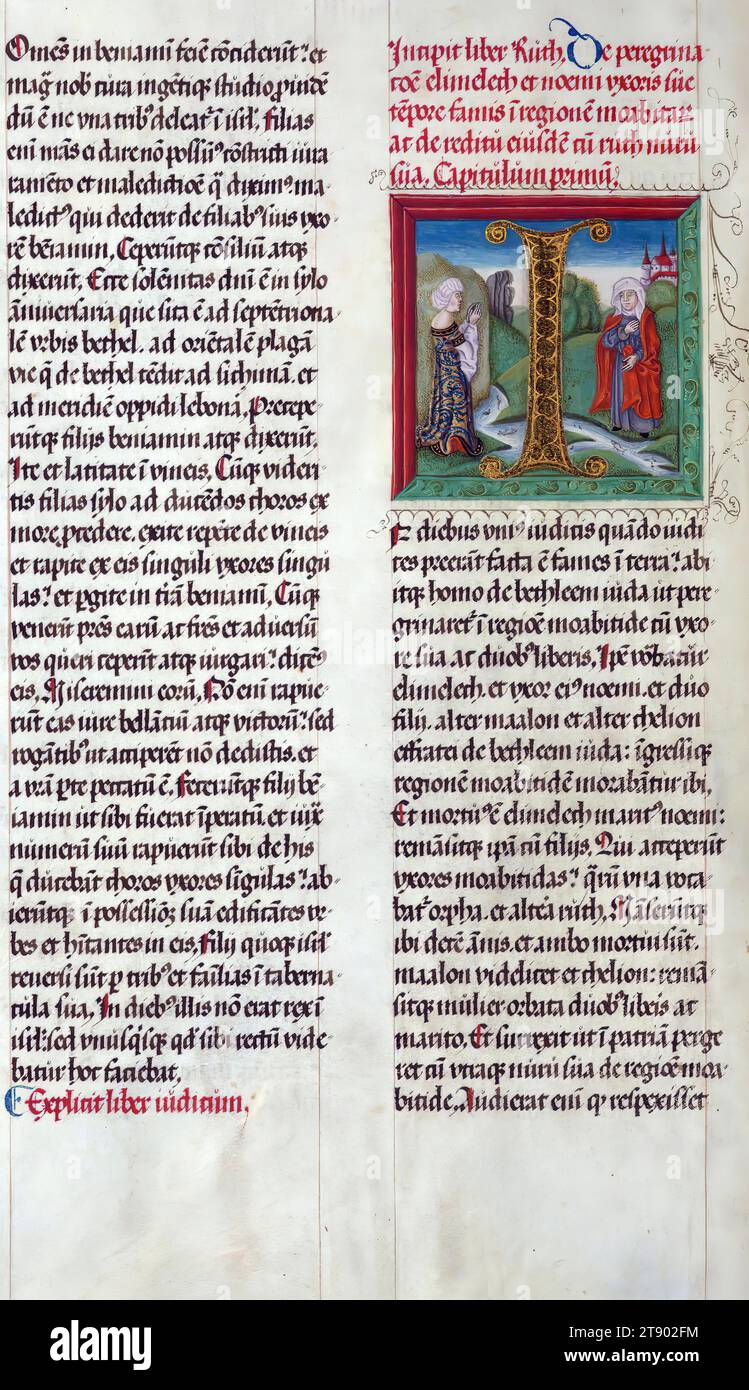 Illuminated Manuscript, Bible (part), Naomi and Ruth, This large-scale manuscript contains the first eight Old Testament books, Genesis through Ruth. The date of completion is given, February 2, 1507. The illumination of the Creation within a cosmographic scheme is based in part on the woodcut illustrations of Creation in the 1483 Koberger Bible, and the 1493 Nuremberg Chronicle by the same printer. Large historiated initials mark the beginning of each book Stock Photohttps://www.alamy.com/image-license-details/?v=1https://www.alamy.com/illuminated-manuscript-bible-part-naomi-and-ruth-this-large-scale-manuscript-contains-the-first-eight-old-testament-books-genesis-through-ruth-the-date-of-completion-is-given-february-2-1507-the-illumination-of-the-creation-within-a-cosmographic-scheme-is-based-in-part-on-the-woodcut-illustrations-of-creation-in-the-1483-koberger-bible-and-the-1493-nuremberg-chronicle-by-the-same-printer-large-historiated-initials-mark-the-beginning-of-each-book-image573476056.html
Illuminated Manuscript, Bible (part), Naomi and Ruth, This large-scale manuscript contains the first eight Old Testament books, Genesis through Ruth. The date of completion is given, February 2, 1507. The illumination of the Creation within a cosmographic scheme is based in part on the woodcut illustrations of Creation in the 1483 Koberger Bible, and the 1493 Nuremberg Chronicle by the same printer. Large historiated initials mark the beginning of each book Stock Photohttps://www.alamy.com/image-license-details/?v=1https://www.alamy.com/illuminated-manuscript-bible-part-naomi-and-ruth-this-large-scale-manuscript-contains-the-first-eight-old-testament-books-genesis-through-ruth-the-date-of-completion-is-given-february-2-1507-the-illumination-of-the-creation-within-a-cosmographic-scheme-is-based-in-part-on-the-woodcut-illustrations-of-creation-in-the-1483-koberger-bible-and-the-1493-nuremberg-chronicle-by-the-same-printer-large-historiated-initials-mark-the-beginning-of-each-book-image573476056.htmlRM2T902FM–Illuminated Manuscript, Bible (part), Naomi and Ruth, This large-scale manuscript contains the first eight Old Testament books, Genesis through Ruth. The date of completion is given, February 2, 1507. The illumination of the Creation within a cosmographic scheme is based in part on the woodcut illustrations of Creation in the 1483 Koberger Bible, and the 1493 Nuremberg Chronicle by the same printer. Large historiated initials mark the beginning of each book
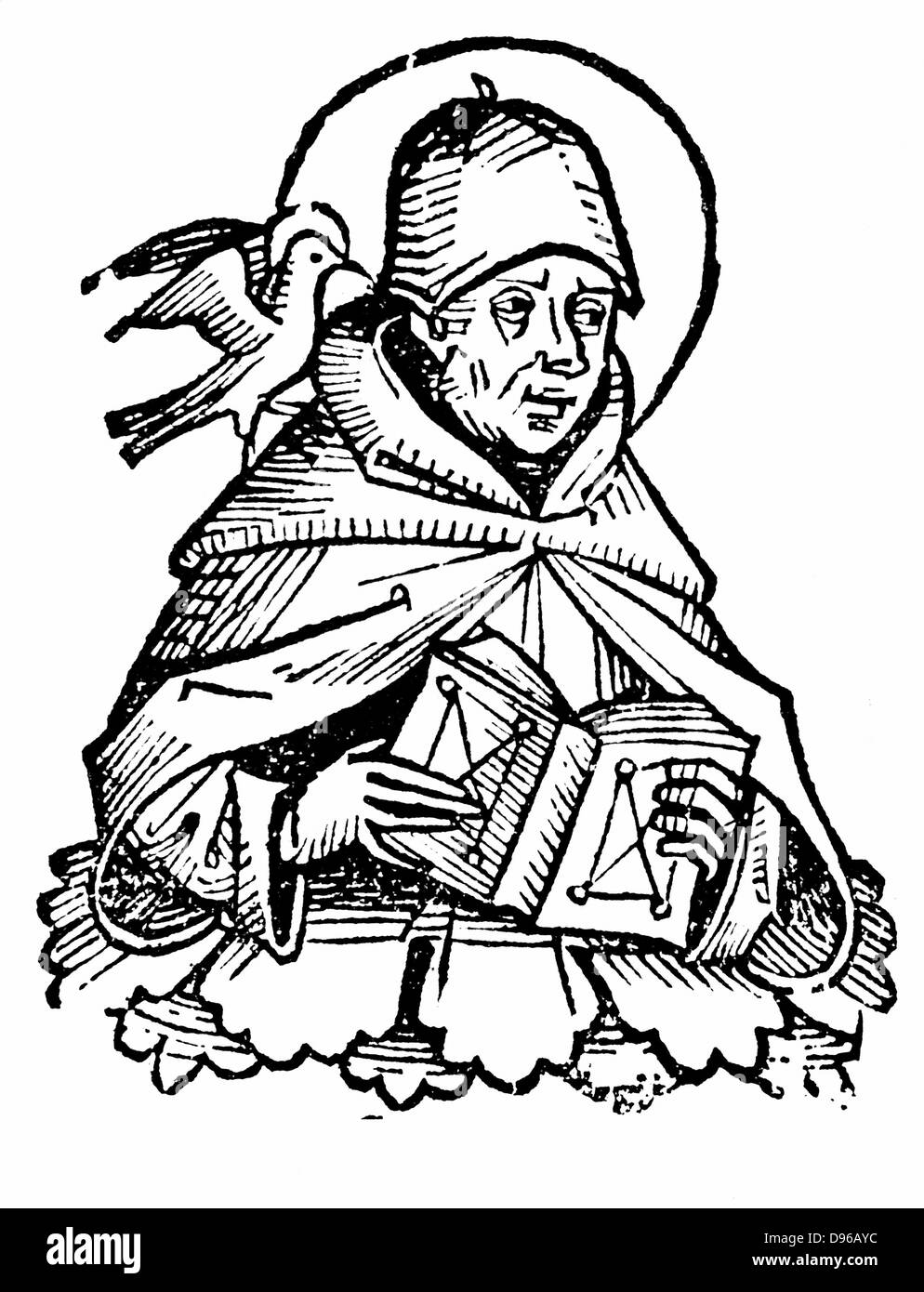 St Thomas Aquinas (c1225-1274) Italian philosopher and theologian. Joined Dominican order and studied under Albertus Magnus at Cologne. Wrote commentaries on Aristotle He holds open a book, while on his shoulder is the dove of the Holy Spirit. Woodcut from Hartmann Schedel 'Liber chronicarum mundi' (Nuremberg Chronicle) Nuremberg 1493 Stock Photohttps://www.alamy.com/image-license-details/?v=1https://www.alamy.com/stock-photo-st-thomas-aquinas-c1225-1274-italian-philosopher-and-theologian-joined-57303328.html
St Thomas Aquinas (c1225-1274) Italian philosopher and theologian. Joined Dominican order and studied under Albertus Magnus at Cologne. Wrote commentaries on Aristotle He holds open a book, while on his shoulder is the dove of the Holy Spirit. Woodcut from Hartmann Schedel 'Liber chronicarum mundi' (Nuremberg Chronicle) Nuremberg 1493 Stock Photohttps://www.alamy.com/image-license-details/?v=1https://www.alamy.com/stock-photo-st-thomas-aquinas-c1225-1274-italian-philosopher-and-theologian-joined-57303328.htmlRMD96AYC–St Thomas Aquinas (c1225-1274) Italian philosopher and theologian. Joined Dominican order and studied under Albertus Magnus at Cologne. Wrote commentaries on Aristotle He holds open a book, while on his shoulder is the dove of the Holy Spirit. Woodcut from Hartmann Schedel 'Liber chronicarum mundi' (Nuremberg Chronicle) Nuremberg 1493
 God stops Abraham from sacrificing Isaac - Illustration from The Nuremberg Chronicle, 1493. Illustrated by Wilhelm Pleydenwurff and Michael Wolgemut Stock Photohttps://www.alamy.com/image-license-details/?v=1https://www.alamy.com/god-stops-abraham-from-sacrificing-isaac-illustration-from-the-nuremberg-chronicle-1493-illustrated-by-wilhelm-pleydenwurff-and-michael-wolgemut-image572588554.html
God stops Abraham from sacrificing Isaac - Illustration from The Nuremberg Chronicle, 1493. Illustrated by Wilhelm Pleydenwurff and Michael Wolgemut Stock Photohttps://www.alamy.com/image-license-details/?v=1https://www.alamy.com/god-stops-abraham-from-sacrificing-isaac-illustration-from-the-nuremberg-chronicle-1493-illustrated-by-wilhelm-pleydenwurff-and-michael-wolgemut-image572588554.htmlRF2T7FJF6–God stops Abraham from sacrificing Isaac - Illustration from The Nuremberg Chronicle, 1493. Illustrated by Wilhelm Pleydenwurff and Michael Wolgemut
 Saint Valentine (from the Schedel's Chronicle of the World). Museum: Bayerische Staatsbibliothek, Munich. Stock Photohttps://www.alamy.com/image-license-details/?v=1https://www.alamy.com/saint-valentine-from-the-schedels-chronicle-of-the-world-museum-bayerische-staatsbibliothek-munich-image212287301.html
Saint Valentine (from the Schedel's Chronicle of the World). Museum: Bayerische Staatsbibliothek, Munich. Stock Photohttps://www.alamy.com/image-license-details/?v=1https://www.alamy.com/saint-valentine-from-the-schedels-chronicle-of-the-world-museum-bayerische-staatsbibliothek-munich-image212287301.htmlRMP9AEH9–Saint Valentine (from the Schedel's Chronicle of the World). Museum: Bayerische Staatsbibliothek, Munich.
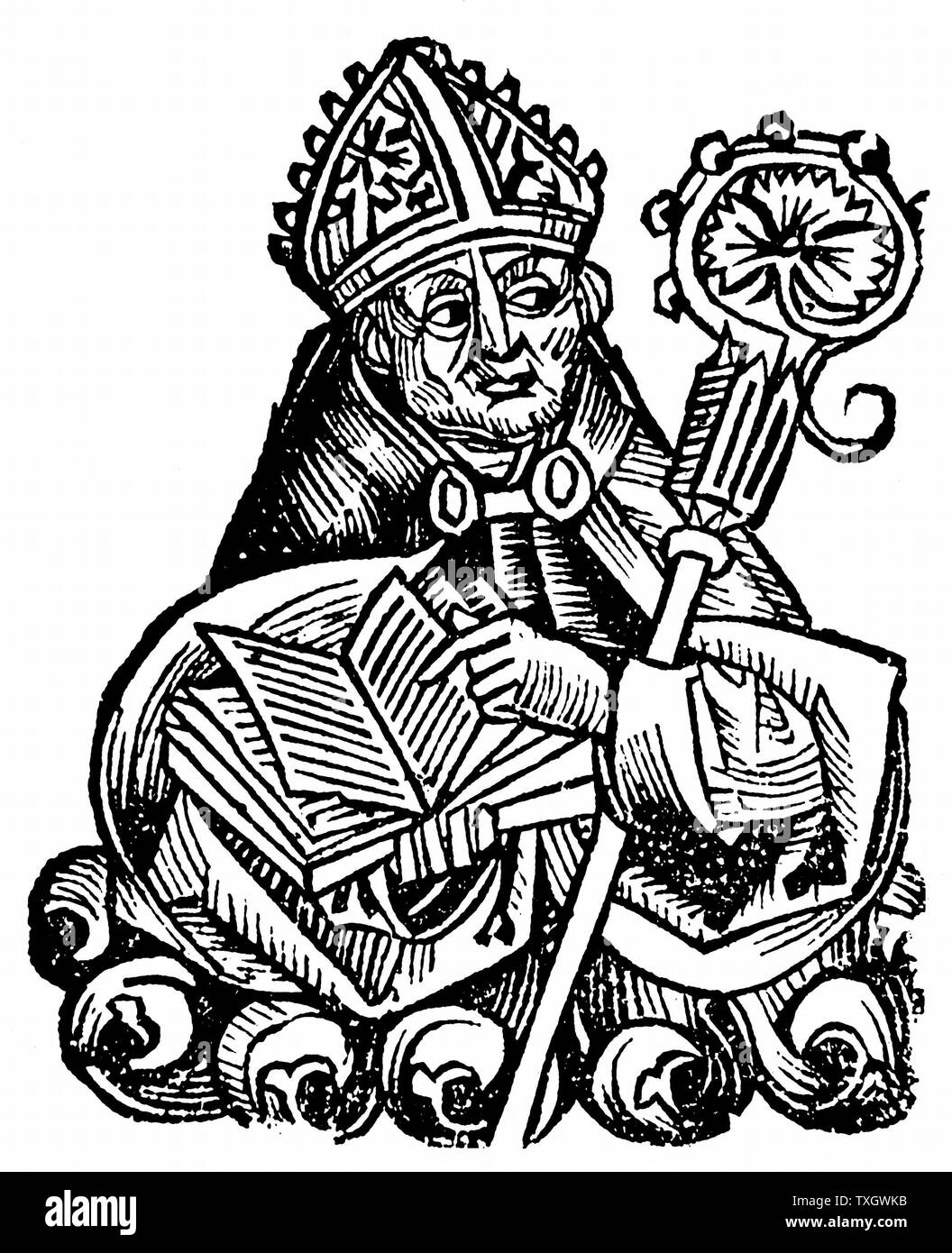 Albertus Magnus (c1200-1280) Italian Dominican friar called 'Doctor Universalis'. Bishop of Ratisbon, 1260, holding open book. Melded theology and Aristotelianism. 1493 Woodcut from Hartmann Schedel 'Liber chronicarum mundi' (Nuremberg Chronicle) Stock Photohttps://www.alamy.com/image-license-details/?v=1https://www.alamy.com/albertus-magnus-c1200-1280-italian-dominican-friar-called-doctor-universalis-bishop-of-ratisbon-1260-holding-open-book-melded-theology-and-aristotelianism-1493-woodcut-from-hartmann-schedel-liber-chronicarum-mundi-nuremberg-chronicle-image257297583.html
Albertus Magnus (c1200-1280) Italian Dominican friar called 'Doctor Universalis'. Bishop of Ratisbon, 1260, holding open book. Melded theology and Aristotelianism. 1493 Woodcut from Hartmann Schedel 'Liber chronicarum mundi' (Nuremberg Chronicle) Stock Photohttps://www.alamy.com/image-license-details/?v=1https://www.alamy.com/albertus-magnus-c1200-1280-italian-dominican-friar-called-doctor-universalis-bishop-of-ratisbon-1260-holding-open-book-melded-theology-and-aristotelianism-1493-woodcut-from-hartmann-schedel-liber-chronicarum-mundi-nuremberg-chronicle-image257297583.htmlRMTXGWKB–Albertus Magnus (c1200-1280) Italian Dominican friar called 'Doctor Universalis'. Bishop of Ratisbon, 1260, holding open book. Melded theology and Aristotelianism. 1493 Woodcut from Hartmann Schedel 'Liber chronicarum mundi' (Nuremberg Chronicle)
 A precious incunabulum is on display at the Duchess Anna Amalia Library of Weimar, Germany, 30 November 2007. From 02 December through 03 August 2008, the library exhibits 60 printings dating no later than 1500 under the title 'World of Incunabula' in the Renaissance hall of the research library. Among others, the Nuremberg Chronicle - known to Germans as Schedel's World Chronicle Stock Photohttps://www.alamy.com/image-license-details/?v=1https://www.alamy.com/stock-photo-a-precious-incunabulum-is-on-display-at-the-duchess-anna-amalia-library-58422899.html
A precious incunabulum is on display at the Duchess Anna Amalia Library of Weimar, Germany, 30 November 2007. From 02 December through 03 August 2008, the library exhibits 60 printings dating no later than 1500 under the title 'World of Incunabula' in the Renaissance hall of the research library. Among others, the Nuremberg Chronicle - known to Germans as Schedel's World Chronicle Stock Photohttps://www.alamy.com/image-license-details/?v=1https://www.alamy.com/stock-photo-a-precious-incunabulum-is-on-display-at-the-duchess-anna-amalia-library-58422899.htmlRMDB1B03–A precious incunabulum is on display at the Duchess Anna Amalia Library of Weimar, Germany, 30 November 2007. From 02 December through 03 August 2008, the library exhibits 60 printings dating no later than 1500 under the title 'World of Incunabula' in the Renaissance hall of the research library. Among others, the Nuremberg Chronicle - known to Germans as Schedel's World Chronicle
 Toronto, Canada-March 1, 2018: Thomas Fisher Rare Book Library building in the University of Toronto, the largest repository of publicly accessible ra Stock Photohttps://www.alamy.com/image-license-details/?v=1https://www.alamy.com/toronto-canada-march-1-2018-thomas-fisher-rare-book-library-building-in-the-university-of-toronto-the-largest-repository-of-publicly-accessible-ra-image239057867.html
Toronto, Canada-March 1, 2018: Thomas Fisher Rare Book Library building in the University of Toronto, the largest repository of publicly accessible ra Stock Photohttps://www.alamy.com/image-license-details/?v=1https://www.alamy.com/toronto-canada-march-1-2018-thomas-fisher-rare-book-library-building-in-the-university-of-toronto-the-largest-repository-of-publicly-accessible-ra-image239057867.htmlRFRTX0MY–Toronto, Canada-March 1, 2018: Thomas Fisher Rare Book Library building in the University of Toronto, the largest repository of publicly accessible ra
 Panaetius Nuremberg Chronicle Stock Photohttps://www.alamy.com/image-license-details/?v=1https://www.alamy.com/stock-photo-panaetius-nuremberg-chronicle-140289734.html
Panaetius Nuremberg Chronicle Stock Photohttps://www.alamy.com/image-license-details/?v=1https://www.alamy.com/stock-photo-panaetius-nuremberg-chronicle-140289734.htmlRMJ46MYJ–Panaetius Nuremberg Chronicle
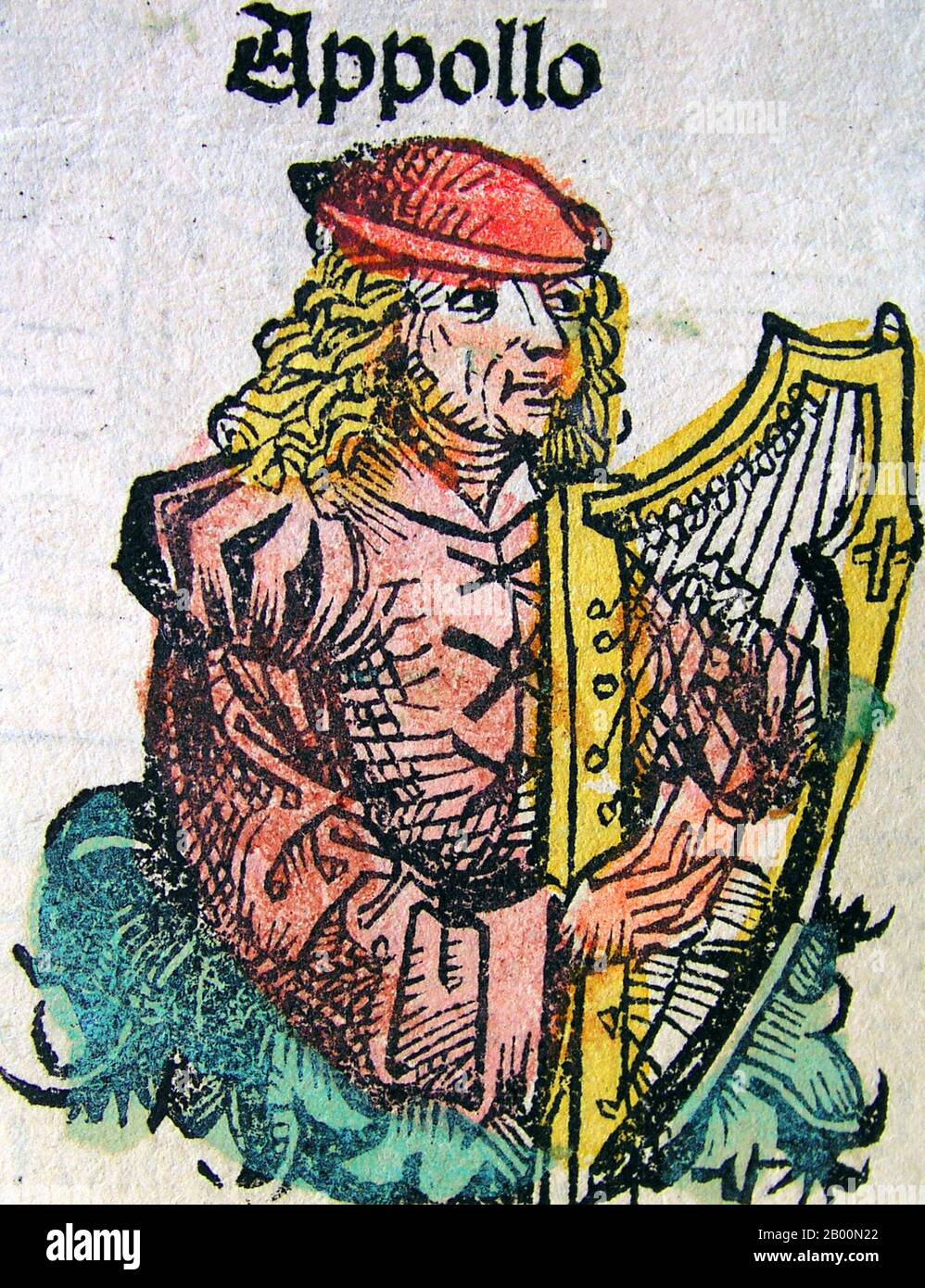 Germany: 'Apollo'. The Nuremberg Chronicle, by Hartmann Schedel (1440-1514), 1493. The Nuremberg Chronicle is an illustrated world history. Its structure follows the story of human history as related in the Bible; it includes the histories of a number of important Western cities. Written in Latin by Hartmann Schedel, with a version in German translation by Georg Alt, it appeared in 1493. It is one of the best-documented early printed books. It is classified as an incunabulum – that is, a book, pamphlet, or broadside that was printed (not handwritten) before the year 1501 in Europe. Stock Photohttps://www.alamy.com/image-license-details/?v=1https://www.alamy.com/germany-apollo-the-nuremberg-chronicle-by-hartmann-schedel-1440-1514-1493-the-nuremberg-chronicle-is-an-illustrated-world-history-its-structure-follows-the-story-of-human-history-as-related-in-the-bible-it-includes-the-histories-of-a-number-of-important-western-cities-written-in-latin-by-hartmann-schedel-with-a-version-in-german-translation-by-georg-alt-it-appeared-in-1493-it-is-one-of-the-best-documented-early-printed-books-it-is-classified-as-an-incunabulum-that-is-a-book-pamphlet-or-broadside-that-was-printed-not-handwritten-before-the-year-1501-in-europe-image344223882.html
Germany: 'Apollo'. The Nuremberg Chronicle, by Hartmann Schedel (1440-1514), 1493. The Nuremberg Chronicle is an illustrated world history. Its structure follows the story of human history as related in the Bible; it includes the histories of a number of important Western cities. Written in Latin by Hartmann Schedel, with a version in German translation by Georg Alt, it appeared in 1493. It is one of the best-documented early printed books. It is classified as an incunabulum – that is, a book, pamphlet, or broadside that was printed (not handwritten) before the year 1501 in Europe. Stock Photohttps://www.alamy.com/image-license-details/?v=1https://www.alamy.com/germany-apollo-the-nuremberg-chronicle-by-hartmann-schedel-1440-1514-1493-the-nuremberg-chronicle-is-an-illustrated-world-history-its-structure-follows-the-story-of-human-history-as-related-in-the-bible-it-includes-the-histories-of-a-number-of-important-western-cities-written-in-latin-by-hartmann-schedel-with-a-version-in-german-translation-by-georg-alt-it-appeared-in-1493-it-is-one-of-the-best-documented-early-printed-books-it-is-classified-as-an-incunabulum-that-is-a-book-pamphlet-or-broadside-that-was-printed-not-handwritten-before-the-year-1501-in-europe-image344223882.htmlRM2B00N22–Germany: 'Apollo'. The Nuremberg Chronicle, by Hartmann Schedel (1440-1514), 1493. The Nuremberg Chronicle is an illustrated world history. Its structure follows the story of human history as related in the Bible; it includes the histories of a number of important Western cities. Written in Latin by Hartmann Schedel, with a version in German translation by Georg Alt, it appeared in 1493. It is one of the best-documented early printed books. It is classified as an incunabulum – that is, a book, pamphlet, or broadside that was printed (not handwritten) before the year 1501 in Europe.
 Damascus. Engraving. The Nuremberg Chronicle. 15th century. Stock Photohttps://www.alamy.com/image-license-details/?v=1https://www.alamy.com/damascus-engraving-the-nuremberg-chronicle-15th-century-image485081433.html
Damascus. Engraving. The Nuremberg Chronicle. 15th century. Stock Photohttps://www.alamy.com/image-license-details/?v=1https://www.alamy.com/damascus-engraving-the-nuremberg-chronicle-15th-century-image485081433.htmlRM2K55A8W–Damascus. Engraving. The Nuremberg Chronicle. 15th century.
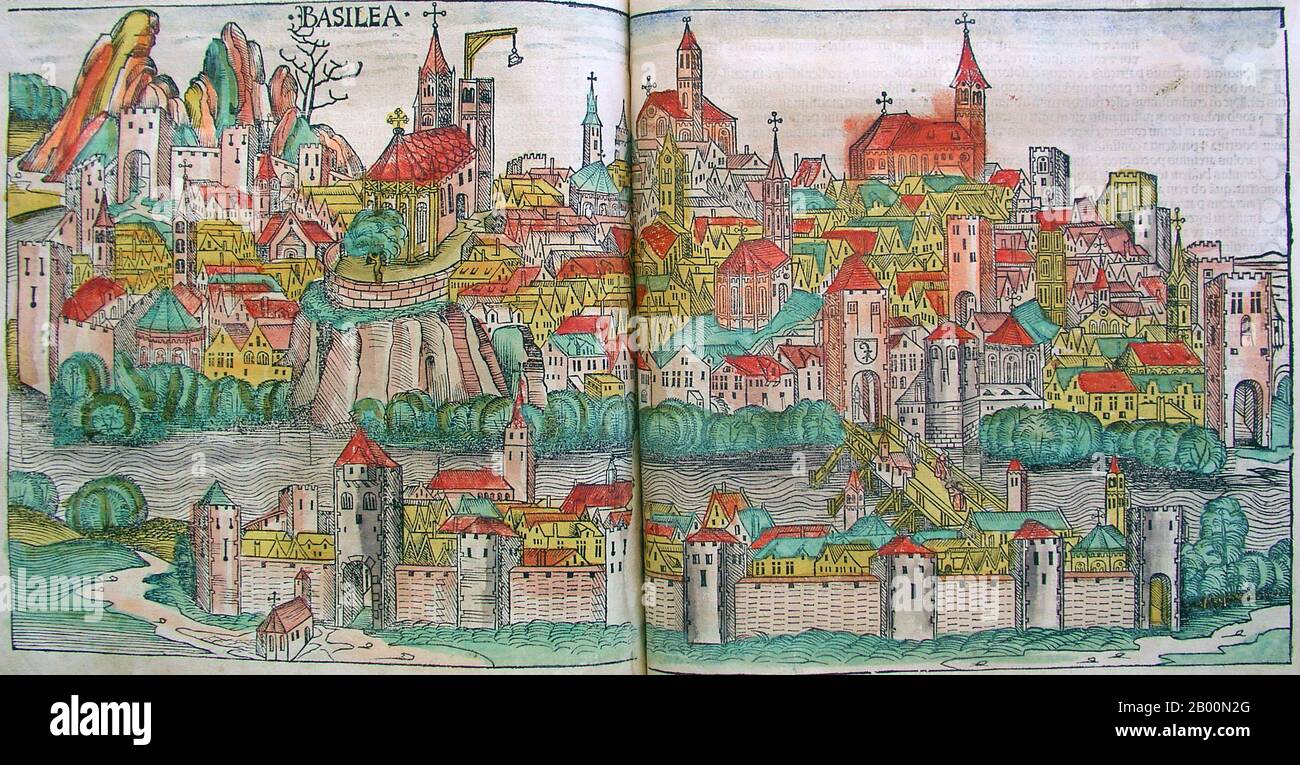 Germany: 'Basle (Basilea)'. The Nuremberg Chronicle, by Hartmann Schedel (1440-1514), 1493. The Nuremberg Chronicle is an illustrated world history. Its structure follows the story of human history as related in the Bible; it includes the histories of a number of important Western cities. Written in Latin by Hartmann Schedel, with a version in German translation by Georg Alt, it appeared in 1493. It is one of the best-documented early printed books. It is classified as an incunabulum – that is, a book, pamphlet, or broadside that was printed (not handwritten) before the year 1501 in Europe. Stock Photohttps://www.alamy.com/image-license-details/?v=1https://www.alamy.com/germany-basle-basilea-the-nuremberg-chronicle-by-hartmann-schedel-1440-1514-1493-the-nuremberg-chronicle-is-an-illustrated-world-history-its-structure-follows-the-story-of-human-history-as-related-in-the-bible-it-includes-the-histories-of-a-number-of-important-western-cities-written-in-latin-by-hartmann-schedel-with-a-version-in-german-translation-by-georg-alt-it-appeared-in-1493-it-is-one-of-the-best-documented-early-printed-books-it-is-classified-as-an-incunabulum-that-is-a-book-pamphlet-or-broadside-that-was-printed-not-handwritten-before-the-year-1501-in-europe-image344223896.html
Germany: 'Basle (Basilea)'. The Nuremberg Chronicle, by Hartmann Schedel (1440-1514), 1493. The Nuremberg Chronicle is an illustrated world history. Its structure follows the story of human history as related in the Bible; it includes the histories of a number of important Western cities. Written in Latin by Hartmann Schedel, with a version in German translation by Georg Alt, it appeared in 1493. It is one of the best-documented early printed books. It is classified as an incunabulum – that is, a book, pamphlet, or broadside that was printed (not handwritten) before the year 1501 in Europe. Stock Photohttps://www.alamy.com/image-license-details/?v=1https://www.alamy.com/germany-basle-basilea-the-nuremberg-chronicle-by-hartmann-schedel-1440-1514-1493-the-nuremberg-chronicle-is-an-illustrated-world-history-its-structure-follows-the-story-of-human-history-as-related-in-the-bible-it-includes-the-histories-of-a-number-of-important-western-cities-written-in-latin-by-hartmann-schedel-with-a-version-in-german-translation-by-georg-alt-it-appeared-in-1493-it-is-one-of-the-best-documented-early-printed-books-it-is-classified-as-an-incunabulum-that-is-a-book-pamphlet-or-broadside-that-was-printed-not-handwritten-before-the-year-1501-in-europe-image344223896.htmlRM2B00N2G–Germany: 'Basle (Basilea)'. The Nuremberg Chronicle, by Hartmann Schedel (1440-1514), 1493. The Nuremberg Chronicle is an illustrated world history. Its structure follows the story of human history as related in the Bible; it includes the histories of a number of important Western cities. Written in Latin by Hartmann Schedel, with a version in German translation by Georg Alt, it appeared in 1493. It is one of the best-documented early printed books. It is classified as an incunabulum – that is, a book, pamphlet, or broadside that was printed (not handwritten) before the year 1501 in Europe.
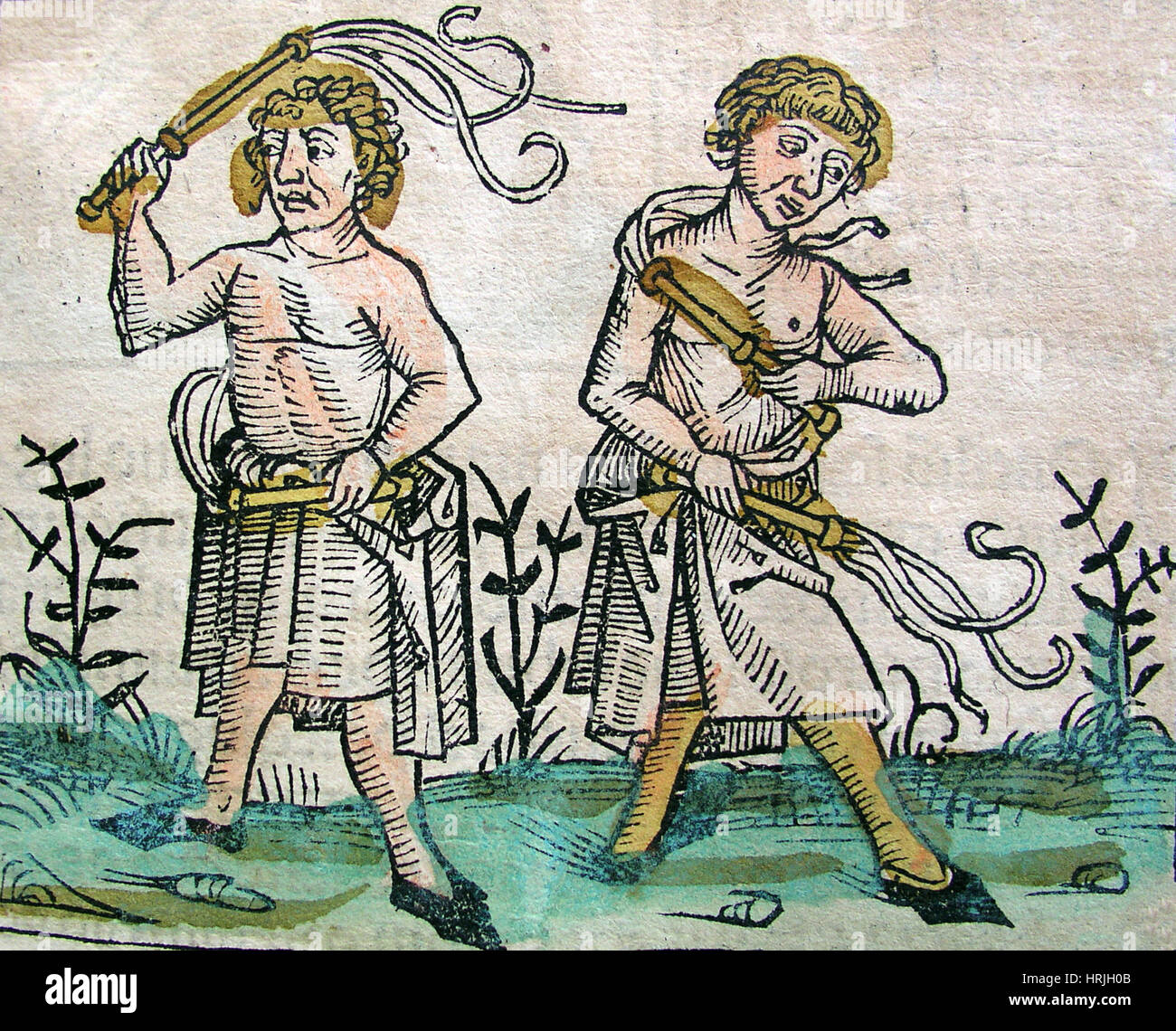 Flagellants, Nuremberg Chronicle, 1493 Stock Photohttps://www.alamy.com/image-license-details/?v=1https://www.alamy.com/stock-photo-flagellants-nuremberg-chronicle-1493-135018139.html
Flagellants, Nuremberg Chronicle, 1493 Stock Photohttps://www.alamy.com/image-license-details/?v=1https://www.alamy.com/stock-photo-flagellants-nuremberg-chronicle-1493-135018139.htmlRMHRJH0B–Flagellants, Nuremberg Chronicle, 1493
 Beautiful woodcut pages from the 1493 Nuremberg Chronicle, which is an enyclodpedia of world events, mythology and christian history. This extra-ordinary work was one of the earliest books ever printed and the first to successfully integrate text and images. These pages show latin text and an engraving of the town of Paris in France Stock Photohttps://www.alamy.com/image-license-details/?v=1https://www.alamy.com/beautiful-woodcut-pages-from-the-1493-nuremberg-chronicle-which-is-an-enyclodpedia-of-world-events-mythology-and-christian-history-this-extra-ordinary-work-was-one-of-the-earliest-books-ever-printed-and-the-first-to-successfully-integrate-text-and-images-these-pages-show-latin-text-and-an-engraving-of-the-town-of-paris-in-france-image598932358.html
Beautiful woodcut pages from the 1493 Nuremberg Chronicle, which is an enyclodpedia of world events, mythology and christian history. This extra-ordinary work was one of the earliest books ever printed and the first to successfully integrate text and images. These pages show latin text and an engraving of the town of Paris in France Stock Photohttps://www.alamy.com/image-license-details/?v=1https://www.alamy.com/beautiful-woodcut-pages-from-the-1493-nuremberg-chronicle-which-is-an-enyclodpedia-of-world-events-mythology-and-christian-history-this-extra-ordinary-work-was-one-of-the-earliest-books-ever-printed-and-the-first-to-successfully-integrate-text-and-images-these-pages-show-latin-text-and-an-engraving-of-the-town-of-paris-in-france-image598932358.htmlRM2WPBM9A–Beautiful woodcut pages from the 1493 Nuremberg Chronicle, which is an enyclodpedia of world events, mythology and christian history. This extra-ordinary work was one of the earliest books ever printed and the first to successfully integrate text and images. These pages show latin text and an engraving of the town of Paris in France
 Bruno I., 925 - 11.10.965, German clergyman, Archbishop of Cologne 953 - 965, portrait, woodcut by Michael Wolgemut or Wilhelm Pleydenwurff to the chronicle of Hartmann Schedel, Nuremberg, 1493, Artist's Copyright has not to be cleared Stock Photohttps://www.alamy.com/image-license-details/?v=1https://www.alamy.com/bruno-i-925-1110965-german-clergyman-archbishop-of-cologne-953-965-portrait-woodcut-by-michael-wolgemut-or-wilhelm-pleydenwurff-to-the-chronicle-of-hartmann-schedel-nuremberg-1493-artists-copyright-has-not-to-be-cleared-image238576563.html
Bruno I., 925 - 11.10.965, German clergyman, Archbishop of Cologne 953 - 965, portrait, woodcut by Michael Wolgemut or Wilhelm Pleydenwurff to the chronicle of Hartmann Schedel, Nuremberg, 1493, Artist's Copyright has not to be cleared Stock Photohttps://www.alamy.com/image-license-details/?v=1https://www.alamy.com/bruno-i-925-1110965-german-clergyman-archbishop-of-cologne-953-965-portrait-woodcut-by-michael-wolgemut-or-wilhelm-pleydenwurff-to-the-chronicle-of-hartmann-schedel-nuremberg-1493-artists-copyright-has-not-to-be-cleared-image238576563.htmlRMRT42RF–Bruno I., 925 - 11.10.965, German clergyman, Archbishop of Cologne 953 - 965, portrait, woodcut by Michael Wolgemut or Wilhelm Pleydenwurff to the chronicle of Hartmann Schedel, Nuremberg, 1493, Artist's Copyright has not to be cleared
![. Publius Ovidius Naso and Plato in the Nuremberg Chronicle, also known as the Liber Chronicarum The Morse Library of the Benoit College has a very strict license for the use of images from the book [1]. Despite this, it could well be argued that images from this book is in the public domain since it was published before 1922. . Hartmann Schedel 426 Plato and Ovid (together) Stock Photo . Publius Ovidius Naso and Plato in the Nuremberg Chronicle, also known as the Liber Chronicarum The Morse Library of the Benoit College has a very strict license for the use of images from the book [1]. Despite this, it could well be argued that images from this book is in the public domain since it was published before 1922. . Hartmann Schedel 426 Plato and Ovid (together) Stock Photo](https://c8.alamy.com/comp/MYPA85/publius-ovidius-naso-and-plato-in-the-nuremberg-chronicle-also-known-as-the-liber-chronicarum-the-morse-library-of-the-benoit-college-has-a-very-strict-license-for-the-use-of-images-from-the-book-1-despite-this-it-could-well-be-argued-that-images-from-this-book-is-in-the-public-domain-since-it-was-published-before-1922-hartmann-schedel-426-plato-and-ovid-together-MYPA85.jpg) . Publius Ovidius Naso and Plato in the Nuremberg Chronicle, also known as the Liber Chronicarum The Morse Library of the Benoit College has a very strict license for the use of images from the book [1]. Despite this, it could well be argued that images from this book is in the public domain since it was published before 1922. . Hartmann Schedel 426 Plato and Ovid (together) Stock Photohttps://www.alamy.com/image-license-details/?v=1https://www.alamy.com/publius-ovidius-naso-and-plato-in-the-nuremberg-chronicle-also-known-as-the-liber-chronicarum-the-morse-library-of-the-benoit-college-has-a-very-strict-license-for-the-use-of-images-from-the-book-1-despite-this-it-could-well-be-argued-that-images-from-this-book-is-in-the-public-domain-since-it-was-published-before-1922-hartmann-schedel-426-plato-and-ovid-together-image189190405.html
. Publius Ovidius Naso and Plato in the Nuremberg Chronicle, also known as the Liber Chronicarum The Morse Library of the Benoit College has a very strict license for the use of images from the book [1]. Despite this, it could well be argued that images from this book is in the public domain since it was published before 1922. . Hartmann Schedel 426 Plato and Ovid (together) Stock Photohttps://www.alamy.com/image-license-details/?v=1https://www.alamy.com/publius-ovidius-naso-and-plato-in-the-nuremberg-chronicle-also-known-as-the-liber-chronicarum-the-morse-library-of-the-benoit-college-has-a-very-strict-license-for-the-use-of-images-from-the-book-1-despite-this-it-could-well-be-argued-that-images-from-this-book-is-in-the-public-domain-since-it-was-published-before-1922-hartmann-schedel-426-plato-and-ovid-together-image189190405.htmlRMMYPA85–. Publius Ovidius Naso and Plato in the Nuremberg Chronicle, also known as the Liber Chronicarum The Morse Library of the Benoit College has a very strict license for the use of images from the book [1]. Despite this, it could well be argued that images from this book is in the public domain since it was published before 1922. . Hartmann Schedel 426 Plato and Ovid (together)
 Antique letterpress print of Dancing Skeletons. 'Imago mortis' (title in top margin) Five dancing and making music skeletons in a landscape. The woodcut is used as a book illustration in Hartmann Schedel's Liber Chronicarum (or Nuremberg Chronicle), published in Latin and German in 1493. Print maker: workshop of Michel Wolgemut and Wilhelm Pleydenwurff, Nuremburg, Germany. Stock Photohttps://www.alamy.com/image-license-details/?v=1https://www.alamy.com/antique-letterpress-print-of-dancing-skeletons-imago-mortis-title-in-top-margin-five-dancing-and-making-music-skeletons-in-a-landscape-the-woodcut-is-used-as-a-book-illustration-in-hartmann-schedels-liber-chronicarum-or-nuremberg-chronicle-published-in-latin-and-german-in-1493-print-maker-workshop-of-michel-wolgemut-and-wilhelm-pleydenwurff-nuremburg-germany-image601444797.html
Antique letterpress print of Dancing Skeletons. 'Imago mortis' (title in top margin) Five dancing and making music skeletons in a landscape. The woodcut is used as a book illustration in Hartmann Schedel's Liber Chronicarum (or Nuremberg Chronicle), published in Latin and German in 1493. Print maker: workshop of Michel Wolgemut and Wilhelm Pleydenwurff, Nuremburg, Germany. Stock Photohttps://www.alamy.com/image-license-details/?v=1https://www.alamy.com/antique-letterpress-print-of-dancing-skeletons-imago-mortis-title-in-top-margin-five-dancing-and-making-music-skeletons-in-a-landscape-the-woodcut-is-used-as-a-book-illustration-in-hartmann-schedels-liber-chronicarum-or-nuremberg-chronicle-published-in-latin-and-german-in-1493-print-maker-workshop-of-michel-wolgemut-and-wilhelm-pleydenwurff-nuremburg-germany-image601444797.htmlRM2WXE4Y9–Antique letterpress print of Dancing Skeletons. 'Imago mortis' (title in top margin) Five dancing and making music skeletons in a landscape. The woodcut is used as a book illustration in Hartmann Schedel's Liber Chronicarum (or Nuremberg Chronicle), published in Latin and German in 1493. Print maker: workshop of Michel Wolgemut and Wilhelm Pleydenwurff, Nuremburg, Germany.
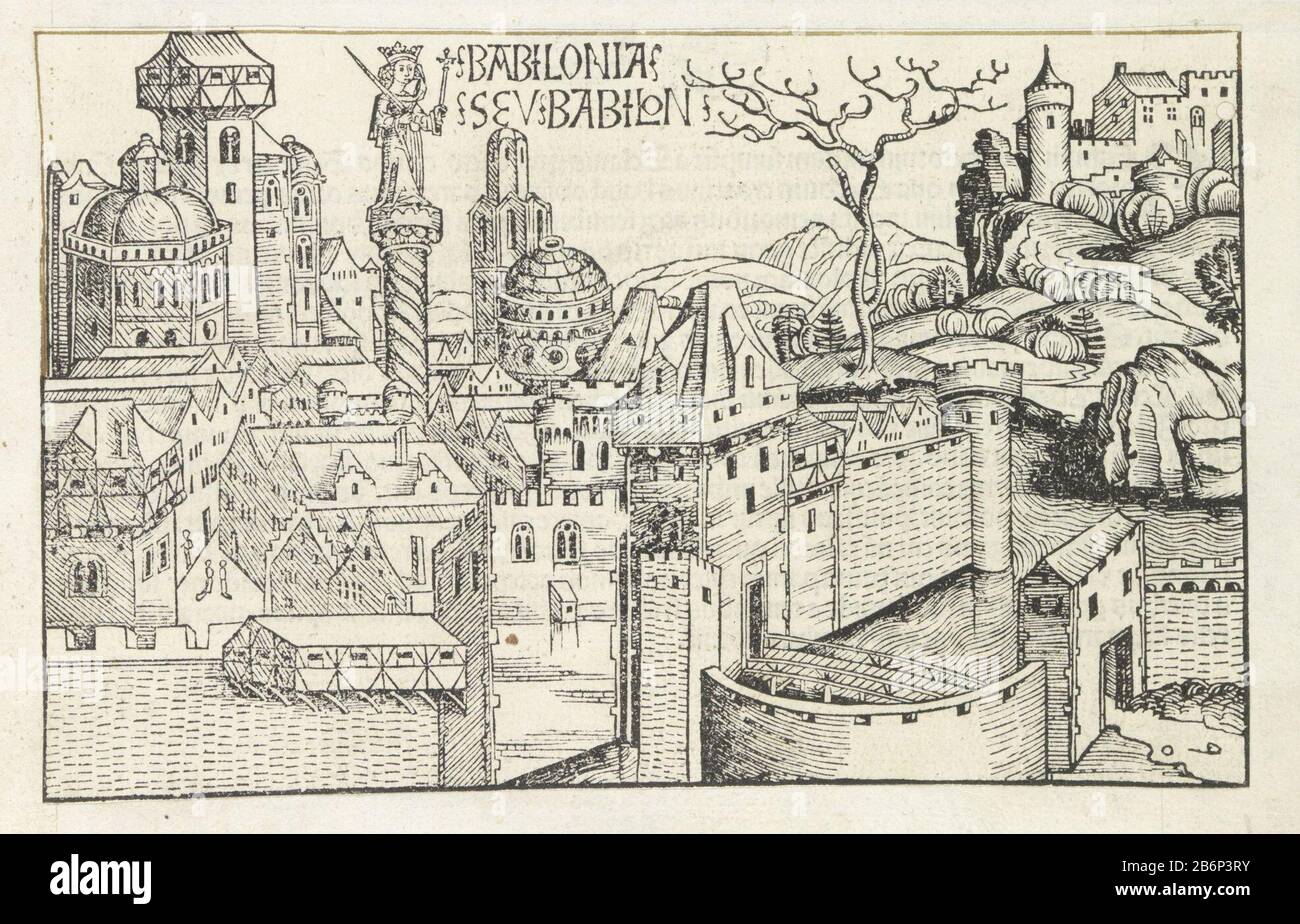 Gezicht op Babylon Babilonia Seu Babilon (titel op object) Liber Chronicarum (serietitel) A view of the city of Babylon with a column queen Semiramis. The print is part of a album. Manufacturer : printmaker Michel Wolgemut (studio) printmaker: Wilhelm Pleydenwurff (workshop) Place manufacture: Nuremberg Date: 1493 Physical features: woodcut pasted on album leaf; verso with text printing material: paper Technique: letterpress / woodcut / paste dimensions: print: H 140 mm × W 222 mmToelichtingDe woodcut used in book illustration in the Liber Chronicarum (or Nuremberg Chronicle) by Hartmann Sched Stock Photohttps://www.alamy.com/image-license-details/?v=1https://www.alamy.com/gezicht-op-babylon-babilonia-seu-babilon-titel-op-object-liber-chronicarum-serietitel-a-view-of-the-city-of-babylon-with-a-column-queen-semiramis-the-print-is-part-of-a-album-manufacturer-printmaker-michel-wolgemut-studio-printmaker-wilhelm-pleydenwurff-workshop-place-manufacture-nuremberg-date-1493-physical-features-woodcut-pasted-on-album-leaf-verso-with-text-printing-material-paper-technique-letterpress-woodcut-paste-dimensions-print-h-140-mm-w-222-mmtoelichtingde-woodcut-used-in-book-illustration-in-the-liber-chronicarum-or-nuremberg-chronicle-by-hartmann-sched-image348381263.html
Gezicht op Babylon Babilonia Seu Babilon (titel op object) Liber Chronicarum (serietitel) A view of the city of Babylon with a column queen Semiramis. The print is part of a album. Manufacturer : printmaker Michel Wolgemut (studio) printmaker: Wilhelm Pleydenwurff (workshop) Place manufacture: Nuremberg Date: 1493 Physical features: woodcut pasted on album leaf; verso with text printing material: paper Technique: letterpress / woodcut / paste dimensions: print: H 140 mm × W 222 mmToelichtingDe woodcut used in book illustration in the Liber Chronicarum (or Nuremberg Chronicle) by Hartmann Sched Stock Photohttps://www.alamy.com/image-license-details/?v=1https://www.alamy.com/gezicht-op-babylon-babilonia-seu-babilon-titel-op-object-liber-chronicarum-serietitel-a-view-of-the-city-of-babylon-with-a-column-queen-semiramis-the-print-is-part-of-a-album-manufacturer-printmaker-michel-wolgemut-studio-printmaker-wilhelm-pleydenwurff-workshop-place-manufacture-nuremberg-date-1493-physical-features-woodcut-pasted-on-album-leaf-verso-with-text-printing-material-paper-technique-letterpress-woodcut-paste-dimensions-print-h-140-mm-w-222-mmtoelichtingde-woodcut-used-in-book-illustration-in-the-liber-chronicarum-or-nuremberg-chronicle-by-hartmann-sched-image348381263.htmlRM2B6P3RY–Gezicht op Babylon Babilonia Seu Babilon (titel op object) Liber Chronicarum (serietitel) A view of the city of Babylon with a column queen Semiramis. The print is part of a album. Manufacturer : printmaker Michel Wolgemut (studio) printmaker: Wilhelm Pleydenwurff (workshop) Place manufacture: Nuremberg Date: 1493 Physical features: woodcut pasted on album leaf; verso with text printing material: paper Technique: letterpress / woodcut / paste dimensions: print: H 140 mm × W 222 mmToelichtingDe woodcut used in book illustration in the Liber Chronicarum (or Nuremberg Chronicle) by Hartmann Sched
![Sexta etas mundi. Page from Liber Chronicarum [The Nuremberg Chronicle] fol. CCLVI. Stock Photo Sexta etas mundi. Page from Liber Chronicarum [The Nuremberg Chronicle] fol. CCLVI. Stock Photo](https://c8.alamy.com/comp/2XAMTMA/sexta-etas-mundi-page-from-liber-chronicarum-the-nuremberg-chronicle-fol-cclvi-2XAMTMA.jpg) Sexta etas mundi. Page from Liber Chronicarum [The Nuremberg Chronicle] fol. CCLVI. Stock Photohttps://www.alamy.com/image-license-details/?v=1https://www.alamy.com/sexta-etas-mundi-page-from-liber-chronicarum-the-nuremberg-chronicle-fol-cclvi-image608967866.html
Sexta etas mundi. Page from Liber Chronicarum [The Nuremberg Chronicle] fol. CCLVI. Stock Photohttps://www.alamy.com/image-license-details/?v=1https://www.alamy.com/sexta-etas-mundi-page-from-liber-chronicarum-the-nuremberg-chronicle-fol-cclvi-image608967866.htmlRM2XAMTMA–Sexta etas mundi. Page from Liber Chronicarum [The Nuremberg Chronicle] fol. CCLVI.
 Page from the Nuremberg Chronicle of Schedel, 1493 print Book illustration with performances of Koningen on top and left. From left to right: Aptheros, Eructoni, Fenix, Cadmus. From top to bottom: Alcades, Amynthas, Bellotbus. At the bottom of a performance of Corinth. A walled city with a city gate in the middle through a statue of a king. On the right a church. paper. (story of) Cadmus. prospect of city, town panorama, silhouette of city - II - ideal city. city-walls Stock Photohttps://www.alamy.com/image-license-details/?v=1https://www.alamy.com/page-from-the-nuremberg-chronicle-of-schedel-1493-print-book-illustration-with-performances-of-koningen-on-top-and-left-from-left-to-right-aptheros-eructoni-fenix-cadmus-from-top-to-bottom-alcades-amynthas-bellotbus-at-the-bottom-of-a-performance-of-corinth-a-walled-city-with-a-city-gate-in-the-middle-through-a-statue-of-a-king-on-the-right-a-church-paper-story-of-cadmus-prospect-of-city-town-panorama-silhouette-of-city-ii-ideal-city-city-walls-image594212911.html
Page from the Nuremberg Chronicle of Schedel, 1493 print Book illustration with performances of Koningen on top and left. From left to right: Aptheros, Eructoni, Fenix, Cadmus. From top to bottom: Alcades, Amynthas, Bellotbus. At the bottom of a performance of Corinth. A walled city with a city gate in the middle through a statue of a king. On the right a church. paper. (story of) Cadmus. prospect of city, town panorama, silhouette of city - II - ideal city. city-walls Stock Photohttps://www.alamy.com/image-license-details/?v=1https://www.alamy.com/page-from-the-nuremberg-chronicle-of-schedel-1493-print-book-illustration-with-performances-of-koningen-on-top-and-left-from-left-to-right-aptheros-eructoni-fenix-cadmus-from-top-to-bottom-alcades-amynthas-bellotbus-at-the-bottom-of-a-performance-of-corinth-a-walled-city-with-a-city-gate-in-the-middle-through-a-statue-of-a-king-on-the-right-a-church-paper-story-of-cadmus-prospect-of-city-town-panorama-silhouette-of-city-ii-ideal-city-city-walls-image594212911.htmlRM2WEMMHK–Page from the Nuremberg Chronicle of Schedel, 1493 print Book illustration with performances of Koningen on top and left. From left to right: Aptheros, Eructoni, Fenix, Cadmus. From top to bottom: Alcades, Amynthas, Bellotbus. At the bottom of a performance of Corinth. A walled city with a city gate in the middle through a statue of a king. On the right a church. paper. (story of) Cadmus. prospect of city, town panorama, silhouette of city - II - ideal city. city-walls
 Illuminated Manuscript, Bible (part), Samson kills the lion, This large-scale manuscript contains the first eight Old Testament books, Genesis through Ruth. The date of completion is given, February 2, 1507. The illumination of the Creation within a cosmographic scheme is based in part on the woodcut illustrations of Creation in the 1483 Koberger Bible, and the 1493 Nuremberg Chronicle by the same printer. Large historiated initials mark the beginning of each book Stock Photohttps://www.alamy.com/image-license-details/?v=1https://www.alamy.com/illuminated-manuscript-bible-part-samson-kills-the-lion-this-large-scale-manuscript-contains-the-first-eight-old-testament-books-genesis-through-ruth-the-date-of-completion-is-given-february-2-1507-the-illumination-of-the-creation-within-a-cosmographic-scheme-is-based-in-part-on-the-woodcut-illustrations-of-creation-in-the-1483-koberger-bible-and-the-1493-nuremberg-chronicle-by-the-same-printer-large-historiated-initials-mark-the-beginning-of-each-book-image573476038.html
Illuminated Manuscript, Bible (part), Samson kills the lion, This large-scale manuscript contains the first eight Old Testament books, Genesis through Ruth. The date of completion is given, February 2, 1507. The illumination of the Creation within a cosmographic scheme is based in part on the woodcut illustrations of Creation in the 1483 Koberger Bible, and the 1493 Nuremberg Chronicle by the same printer. Large historiated initials mark the beginning of each book Stock Photohttps://www.alamy.com/image-license-details/?v=1https://www.alamy.com/illuminated-manuscript-bible-part-samson-kills-the-lion-this-large-scale-manuscript-contains-the-first-eight-old-testament-books-genesis-through-ruth-the-date-of-completion-is-given-february-2-1507-the-illumination-of-the-creation-within-a-cosmographic-scheme-is-based-in-part-on-the-woodcut-illustrations-of-creation-in-the-1483-koberger-bible-and-the-1493-nuremberg-chronicle-by-the-same-printer-large-historiated-initials-mark-the-beginning-of-each-book-image573476038.htmlRM2T902F2–Illuminated Manuscript, Bible (part), Samson kills the lion, This large-scale manuscript contains the first eight Old Testament books, Genesis through Ruth. The date of completion is given, February 2, 1507. The illumination of the Creation within a cosmographic scheme is based in part on the woodcut illustrations of Creation in the 1483 Koberger Bible, and the 1493 Nuremberg Chronicle by the same printer. Large historiated initials mark the beginning of each book
 'Venice in 1493', (1925). Creator: Unknown. Stock Photohttps://www.alamy.com/image-license-details/?v=1https://www.alamy.com/venice-in-1493-1925-creator-unknown-image221516027.html
'Venice in 1493', (1925). Creator: Unknown. Stock Photohttps://www.alamy.com/image-license-details/?v=1https://www.alamy.com/venice-in-1493-1925-creator-unknown-image221516027.htmlRMPTAWXK–'Venice in 1493', (1925). Creator: Unknown.
 Depiction of Memphis, Byzantine Empire - Illustration from The Nuremberg Chronicle, 1493. Illustrated by Wilhelm Pleydenwurff and Michael Wolgemut Stock Photohttps://www.alamy.com/image-license-details/?v=1https://www.alamy.com/depiction-of-memphis-byzantine-empire-illustration-from-the-nuremberg-chronicle-1493-illustrated-by-wilhelm-pleydenwurff-and-michael-wolgemut-image572588543.html
Depiction of Memphis, Byzantine Empire - Illustration from The Nuremberg Chronicle, 1493. Illustrated by Wilhelm Pleydenwurff and Michael Wolgemut Stock Photohttps://www.alamy.com/image-license-details/?v=1https://www.alamy.com/depiction-of-memphis-byzantine-empire-illustration-from-the-nuremberg-chronicle-1493-illustrated-by-wilhelm-pleydenwurff-and-michael-wolgemut-image572588543.htmlRF2T7FJER–Depiction of Memphis, Byzantine Empire - Illustration from The Nuremberg Chronicle, 1493. Illustrated by Wilhelm Pleydenwurff and Michael Wolgemut
 Emperor Sigismund and Empress Barbara (Illustration from the Richental's illustrated chronicle). Museum: Austrian National Library, Vienna. Stock Photohttps://www.alamy.com/image-license-details/?v=1https://www.alamy.com/emperor-sigismund-and-empress-barbara-illustration-from-the-richentals-illustrated-chronicle-museum-austrian-national-library-vienna-image211772514.html
Emperor Sigismund and Empress Barbara (Illustration from the Richental's illustrated chronicle). Museum: Austrian National Library, Vienna. Stock Photohttps://www.alamy.com/image-license-details/?v=1https://www.alamy.com/emperor-sigismund-and-empress-barbara-illustration-from-the-richentals-illustrated-chronicle-museum-austrian-national-library-vienna-image211772514.htmlRMP8F202–Emperor Sigismund and Empress Barbara (Illustration from the Richental's illustrated chronicle). Museum: Austrian National Library, Vienna.
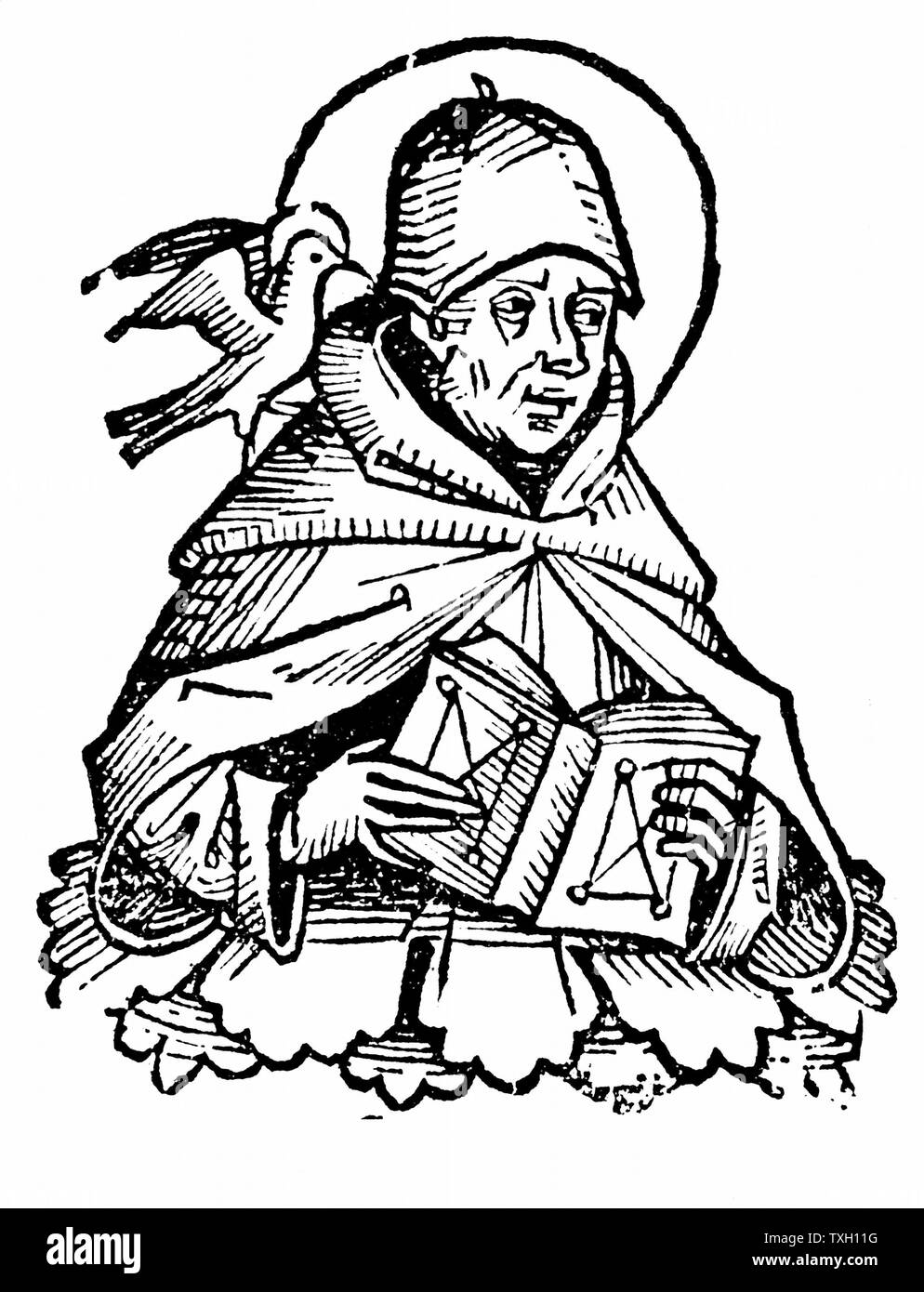 St Thomas Aquinas (c1225-1274) Italian philosopher and theologian. Joined Dominican order and studied under Albertus Magnus at Cologne. Wrote commentaries on Aristotle He holds open a book, while on his shoulder is the dove of the Holy Spirit. Woodcut from Hartmann Schedel 'Liber chronicarum mundi' (Nuremberg Chronicle) Nuremberg 1493 Stock Photohttps://www.alamy.com/image-license-details/?v=1https://www.alamy.com/st-thomas-aquinas-c1225-1274-italian-philosopher-and-theologian-joined-dominican-order-and-studied-under-albertus-magnus-at-cologne-wrote-commentaries-on-aristotle-he-holds-open-a-book-while-on-his-shoulder-is-the-dove-of-the-holy-spirit-woodcut-from-hartmann-schedel-liber-chronicarum-mundi-nuremberg-chronicle-nuremberg-1493-image257300220.html
St Thomas Aquinas (c1225-1274) Italian philosopher and theologian. Joined Dominican order and studied under Albertus Magnus at Cologne. Wrote commentaries on Aristotle He holds open a book, while on his shoulder is the dove of the Holy Spirit. Woodcut from Hartmann Schedel 'Liber chronicarum mundi' (Nuremberg Chronicle) Nuremberg 1493 Stock Photohttps://www.alamy.com/image-license-details/?v=1https://www.alamy.com/st-thomas-aquinas-c1225-1274-italian-philosopher-and-theologian-joined-dominican-order-and-studied-under-albertus-magnus-at-cologne-wrote-commentaries-on-aristotle-he-holds-open-a-book-while-on-his-shoulder-is-the-dove-of-the-holy-spirit-woodcut-from-hartmann-schedel-liber-chronicarum-mundi-nuremberg-chronicle-nuremberg-1493-image257300220.htmlRMTXH11G–St Thomas Aquinas (c1225-1274) Italian philosopher and theologian. Joined Dominican order and studied under Albertus Magnus at Cologne. Wrote commentaries on Aristotle He holds open a book, while on his shoulder is the dove of the Holy Spirit. Woodcut from Hartmann Schedel 'Liber chronicarum mundi' (Nuremberg Chronicle) Nuremberg 1493
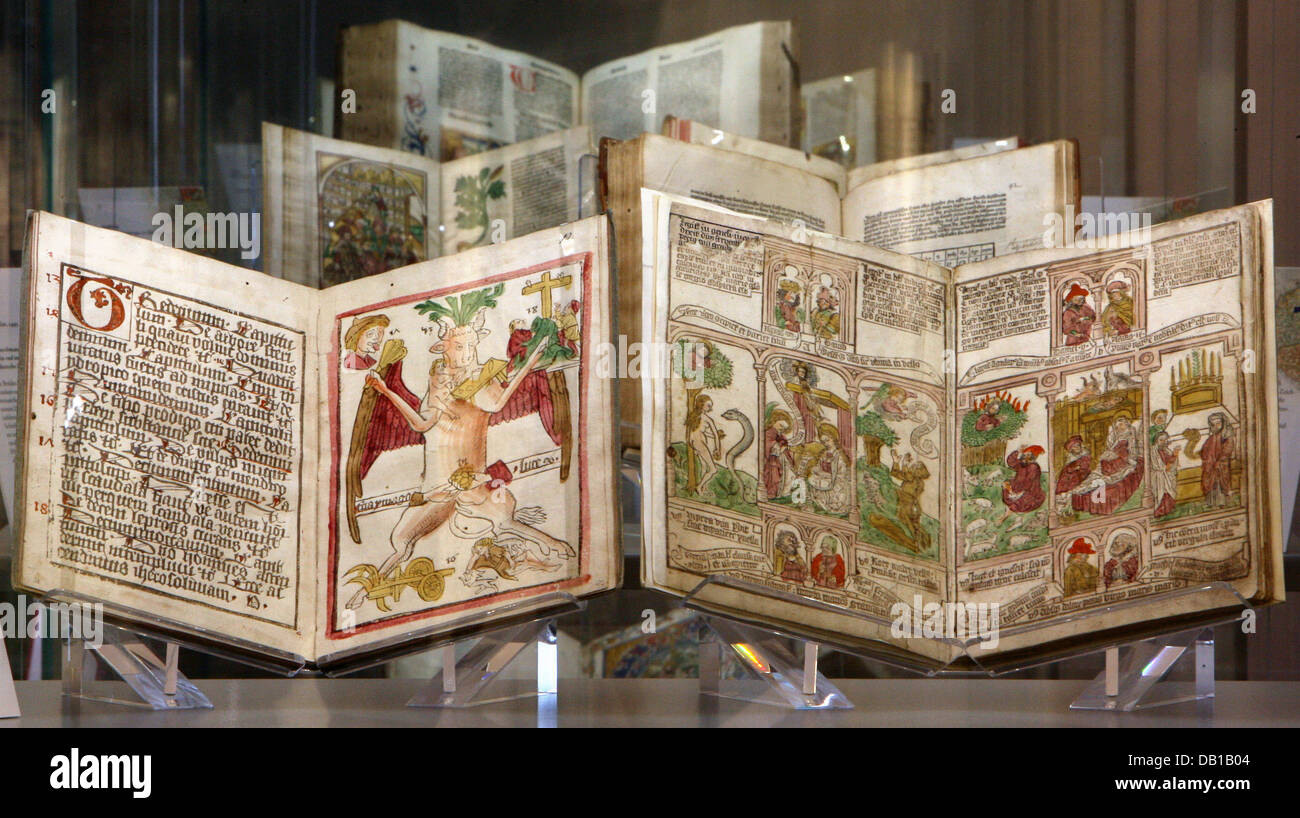 Precious incunabula are on display at the Duchess Anna Amalia Library of Weimar, Germany, 30 November 2007. From 02 December through 03 August 2008, the library exhibits 60 printings dating no later than 1500 under the title 'World of Incunabula' in the Renaissance hall of the research library. Among others, the Nuremberg Chronicle - known to Germans as Schedel's World Chronicle -, Stock Photohttps://www.alamy.com/image-license-details/?v=1https://www.alamy.com/stock-photo-precious-incunabula-are-on-display-at-the-duchess-anna-amalia-library-58422900.html
Precious incunabula are on display at the Duchess Anna Amalia Library of Weimar, Germany, 30 November 2007. From 02 December through 03 August 2008, the library exhibits 60 printings dating no later than 1500 under the title 'World of Incunabula' in the Renaissance hall of the research library. Among others, the Nuremberg Chronicle - known to Germans as Schedel's World Chronicle -, Stock Photohttps://www.alamy.com/image-license-details/?v=1https://www.alamy.com/stock-photo-precious-incunabula-are-on-display-at-the-duchess-anna-amalia-library-58422900.htmlRMDB1B04–Precious incunabula are on display at the Duchess Anna Amalia Library of Weimar, Germany, 30 November 2007. From 02 December through 03 August 2008, the library exhibits 60 printings dating no later than 1500 under the title 'World of Incunabula' in the Renaissance hall of the research library. Among others, the Nuremberg Chronicle - known to Germans as Schedel's World Chronicle -,
 Toronto, Canada-March 1, 2018: Thomas Fisher Rare Book Library building in the University of Toronto, the largest repository of publicly accessible ra Stock Photohttps://www.alamy.com/image-license-details/?v=1https://www.alamy.com/toronto-canada-march-1-2018-thomas-fisher-rare-book-library-building-in-the-university-of-toronto-the-largest-repository-of-publicly-accessible-ra-image239057868.html
Toronto, Canada-March 1, 2018: Thomas Fisher Rare Book Library building in the University of Toronto, the largest repository of publicly accessible ra Stock Photohttps://www.alamy.com/image-license-details/?v=1https://www.alamy.com/toronto-canada-march-1-2018-thomas-fisher-rare-book-library-building-in-the-university-of-toronto-the-largest-repository-of-publicly-accessible-ra-image239057868.htmlRFRTX0N0–Toronto, Canada-March 1, 2018: Thomas Fisher Rare Book Library building in the University of Toronto, the largest repository of publicly accessible ra
 Strato Nuremberg Chronicle Stock Photohttps://www.alamy.com/image-license-details/?v=1https://www.alamy.com/stock-photo-strato-nuremberg-chronicle-140496371.html
Strato Nuremberg Chronicle Stock Photohttps://www.alamy.com/image-license-details/?v=1https://www.alamy.com/stock-photo-strato-nuremberg-chronicle-140496371.htmlRMJ4G4FF–Strato Nuremberg Chronicle
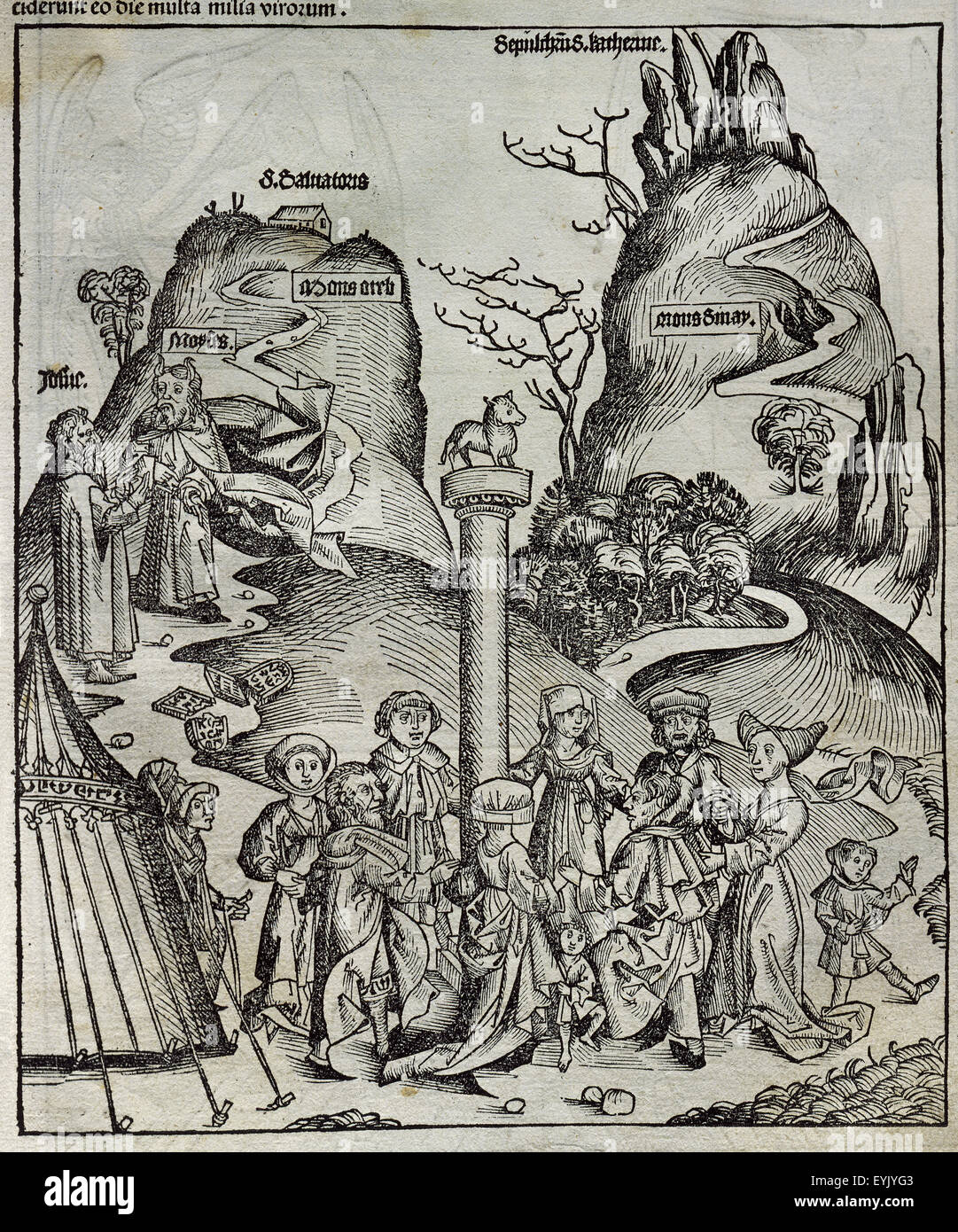 Old Testament. Moses broken the tables of the law. The Israelites during Mose´s absence adoring the idol of Golden calf. Engraving. Liber Chronicarum by Hartman Shedel. 15th century. Stock Photohttps://www.alamy.com/image-license-details/?v=1https://www.alamy.com/stock-photo-old-testament-moses-broken-the-tables-of-the-law-the-israelites-during-85853939.html
Old Testament. Moses broken the tables of the law. The Israelites during Mose´s absence adoring the idol of Golden calf. Engraving. Liber Chronicarum by Hartman Shedel. 15th century. Stock Photohttps://www.alamy.com/image-license-details/?v=1https://www.alamy.com/stock-photo-old-testament-moses-broken-the-tables-of-the-law-the-israelites-during-85853939.htmlRMEYJYG3–Old Testament. Moses broken the tables of the law. The Israelites during Mose´s absence adoring the idol of Golden calf. Engraving. Liber Chronicarum by Hartman Shedel. 15th century.
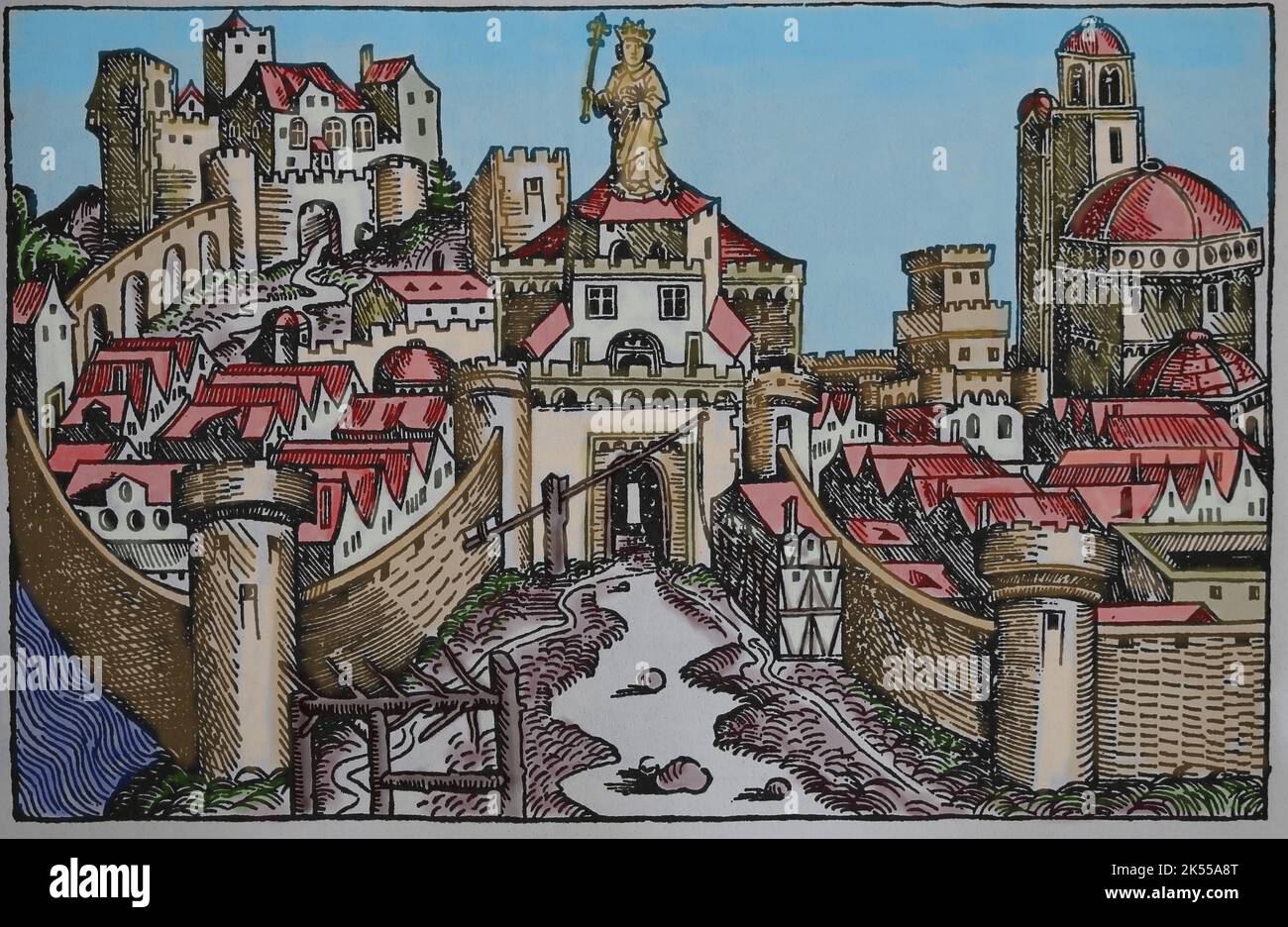 Greece. Old Corinth. Engraving. The Nuremberg Chronicle. 15th century. Stock Photohttps://www.alamy.com/image-license-details/?v=1https://www.alamy.com/greece-old-corinth-engraving-the-nuremberg-chronicle-15th-century-image485081432.html
Greece. Old Corinth. Engraving. The Nuremberg Chronicle. 15th century. Stock Photohttps://www.alamy.com/image-license-details/?v=1https://www.alamy.com/greece-old-corinth-engraving-the-nuremberg-chronicle-15th-century-image485081432.htmlRM2K55A8T–Greece. Old Corinth. Engraving. The Nuremberg Chronicle. 15th century.
 Germany: 'Edmund, Archbishop of Centerbury'. The Nuremberg Chronicle, by Hartmann Schedel (1440-1514), 1493. The Nuremberg Chronicle is an illustrated world history. Its structure follows the story of human history as related in the Bible, including the histories of a number of important Western cities. Written in Latin by Hartmann Schedel, with a version in German translation by Georg Alt, it appeared in 1493. It is one of the best-documented early printed books. It is classified as an incunabulum, a book, pamphlet, or broadside that was printed (not handwritten) before the year 1501. Stock Photohttps://www.alamy.com/image-license-details/?v=1https://www.alamy.com/germany-edmund-archbishop-of-centerbury-the-nuremberg-chronicle-by-hartmann-schedel-1440-1514-1493-the-nuremberg-chronicle-is-an-illustrated-world-history-its-structure-follows-the-story-of-human-history-as-related-in-the-bible-including-the-histories-of-a-number-of-important-western-cities-written-in-latin-by-hartmann-schedel-with-a-version-in-german-translation-by-georg-alt-it-appeared-in-1493-it-is-one-of-the-best-documented-early-printed-books-it-is-classified-as-an-incunabulum-a-book-pamphlet-or-broadside-that-was-printed-not-handwritten-before-the-year-1501-image344224286.html
Germany: 'Edmund, Archbishop of Centerbury'. The Nuremberg Chronicle, by Hartmann Schedel (1440-1514), 1493. The Nuremberg Chronicle is an illustrated world history. Its structure follows the story of human history as related in the Bible, including the histories of a number of important Western cities. Written in Latin by Hartmann Schedel, with a version in German translation by Georg Alt, it appeared in 1493. It is one of the best-documented early printed books. It is classified as an incunabulum, a book, pamphlet, or broadside that was printed (not handwritten) before the year 1501. Stock Photohttps://www.alamy.com/image-license-details/?v=1https://www.alamy.com/germany-edmund-archbishop-of-centerbury-the-nuremberg-chronicle-by-hartmann-schedel-1440-1514-1493-the-nuremberg-chronicle-is-an-illustrated-world-history-its-structure-follows-the-story-of-human-history-as-related-in-the-bible-including-the-histories-of-a-number-of-important-western-cities-written-in-latin-by-hartmann-schedel-with-a-version-in-german-translation-by-georg-alt-it-appeared-in-1493-it-is-one-of-the-best-documented-early-printed-books-it-is-classified-as-an-incunabulum-a-book-pamphlet-or-broadside-that-was-printed-not-handwritten-before-the-year-1501-image344224286.htmlRM2B00NGE–Germany: 'Edmund, Archbishop of Centerbury'. The Nuremberg Chronicle, by Hartmann Schedel (1440-1514), 1493. The Nuremberg Chronicle is an illustrated world history. Its structure follows the story of human history as related in the Bible, including the histories of a number of important Western cities. Written in Latin by Hartmann Schedel, with a version in German translation by Georg Alt, it appeared in 1493. It is one of the best-documented early printed books. It is classified as an incunabulum, a book, pamphlet, or broadside that was printed (not handwritten) before the year 1501.
 Sun Dogs, Nuremberg Chronicle, 1493 Stock Photohttps://www.alamy.com/image-license-details/?v=1https://www.alamy.com/stock-photo-sun-dogs-nuremberg-chronicle-1493-135093765.html
Sun Dogs, Nuremberg Chronicle, 1493 Stock Photohttps://www.alamy.com/image-license-details/?v=1https://www.alamy.com/stock-photo-sun-dogs-nuremberg-chronicle-1493-135093765.htmlRMHRP1D9–Sun Dogs, Nuremberg Chronicle, 1493
 Beautiful woodcut pages from the 1493 Nuremberg Chronicle, which is an enyclodpedia of world events, mythology and christian history. This extra-ordinary work was one of the earliest books ever printed and the first to successfully integrate text and images. These pages show latin text and an engraving of the town of Rhodes in Greece. Stock Photohttps://www.alamy.com/image-license-details/?v=1https://www.alamy.com/beautiful-woodcut-pages-from-the-1493-nuremberg-chronicle-which-is-an-enyclodpedia-of-world-events-mythology-and-christian-history-this-extra-ordinary-work-was-one-of-the-earliest-books-ever-printed-and-the-first-to-successfully-integrate-text-and-images-these-pages-show-latin-text-and-an-engraving-of-the-town-of-rhodes-in-greece-image598932373.html
Beautiful woodcut pages from the 1493 Nuremberg Chronicle, which is an enyclodpedia of world events, mythology and christian history. This extra-ordinary work was one of the earliest books ever printed and the first to successfully integrate text and images. These pages show latin text and an engraving of the town of Rhodes in Greece. Stock Photohttps://www.alamy.com/image-license-details/?v=1https://www.alamy.com/beautiful-woodcut-pages-from-the-1493-nuremberg-chronicle-which-is-an-enyclodpedia-of-world-events-mythology-and-christian-history-this-extra-ordinary-work-was-one-of-the-earliest-books-ever-printed-and-the-first-to-successfully-integrate-text-and-images-these-pages-show-latin-text-and-an-engraving-of-the-town-of-rhodes-in-greece-image598932373.htmlRM2WPBM9W–Beautiful woodcut pages from the 1493 Nuremberg Chronicle, which is an enyclodpedia of world events, mythology and christian history. This extra-ordinary work was one of the earliest books ever printed and the first to successfully integrate text and images. These pages show latin text and an engraving of the town of Rhodes in Greece.
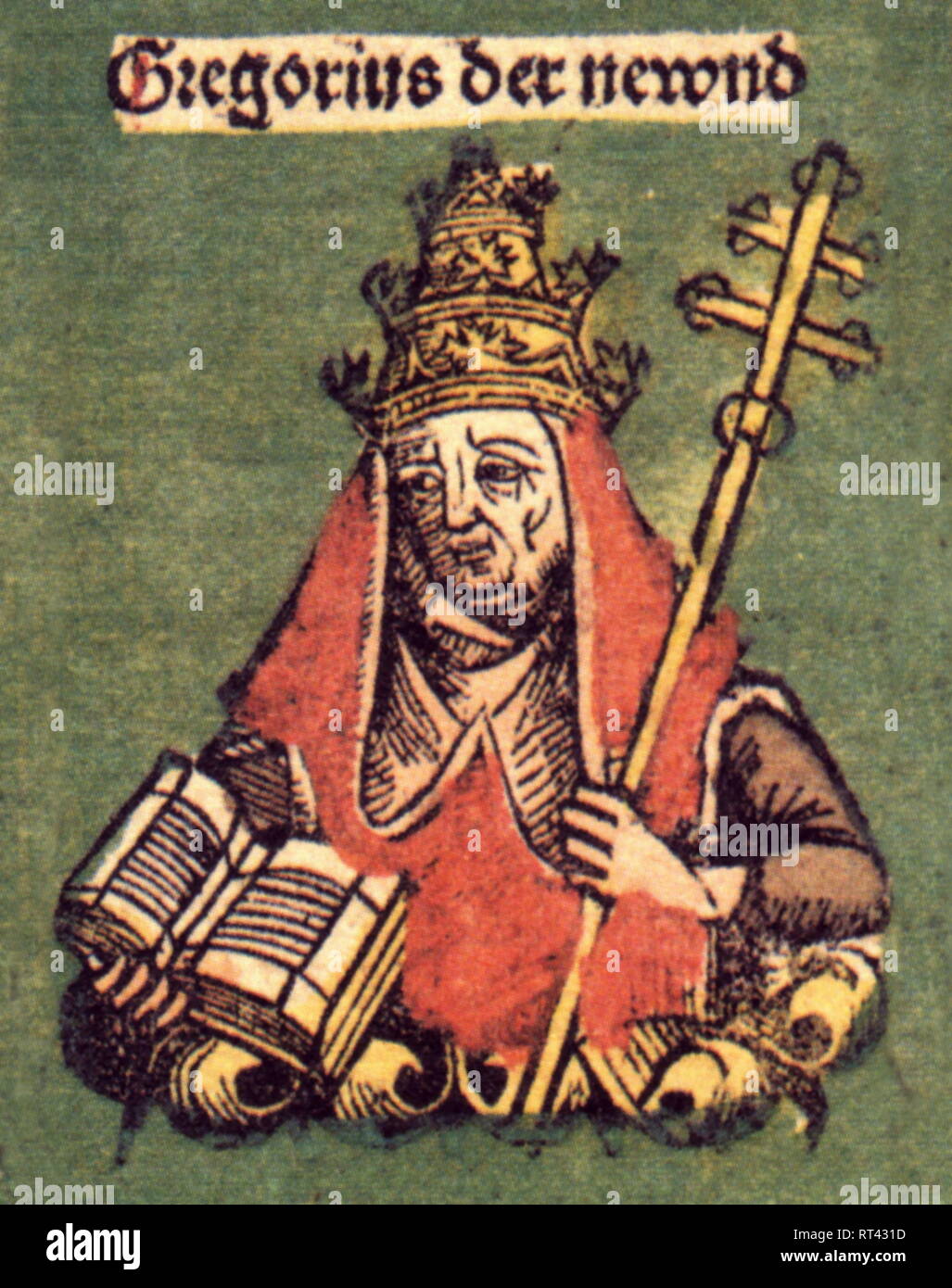 Gregory IX (Ugolino dei Conti di Segni), circa 1167 - 21.8.1241, Pope 19.3.1227 - 21.8.1241, half-length, woodcut by Michael Wolgemut or Wilhelm Pleydenwurff to the chronicle of Hartmann Schedel, Nuremberg, 1493, Artist's Copyright has not to be cleared Stock Photohttps://www.alamy.com/image-license-details/?v=1https://www.alamy.com/gregory-ix-ugolino-dei-conti-di-segni-circa-1167-2181241-pope-1931227-2181241-half-length-woodcut-by-michael-wolgemut-or-wilhelm-pleydenwurff-to-the-chronicle-of-hartmann-schedel-nuremberg-1493-artists-copyright-has-not-to-be-cleared-image238576729.html
Gregory IX (Ugolino dei Conti di Segni), circa 1167 - 21.8.1241, Pope 19.3.1227 - 21.8.1241, half-length, woodcut by Michael Wolgemut or Wilhelm Pleydenwurff to the chronicle of Hartmann Schedel, Nuremberg, 1493, Artist's Copyright has not to be cleared Stock Photohttps://www.alamy.com/image-license-details/?v=1https://www.alamy.com/gregory-ix-ugolino-dei-conti-di-segni-circa-1167-2181241-pope-1931227-2181241-half-length-woodcut-by-michael-wolgemut-or-wilhelm-pleydenwurff-to-the-chronicle-of-hartmann-schedel-nuremberg-1493-artists-copyright-has-not-to-be-cleared-image238576729.htmlRMRT431D–Gregory IX (Ugolino dei Conti di Segni), circa 1167 - 21.8.1241, Pope 19.3.1227 - 21.8.1241, half-length, woodcut by Michael Wolgemut or Wilhelm Pleydenwurff to the chronicle of Hartmann Schedel, Nuremberg, 1493, Artist's Copyright has not to be cleared
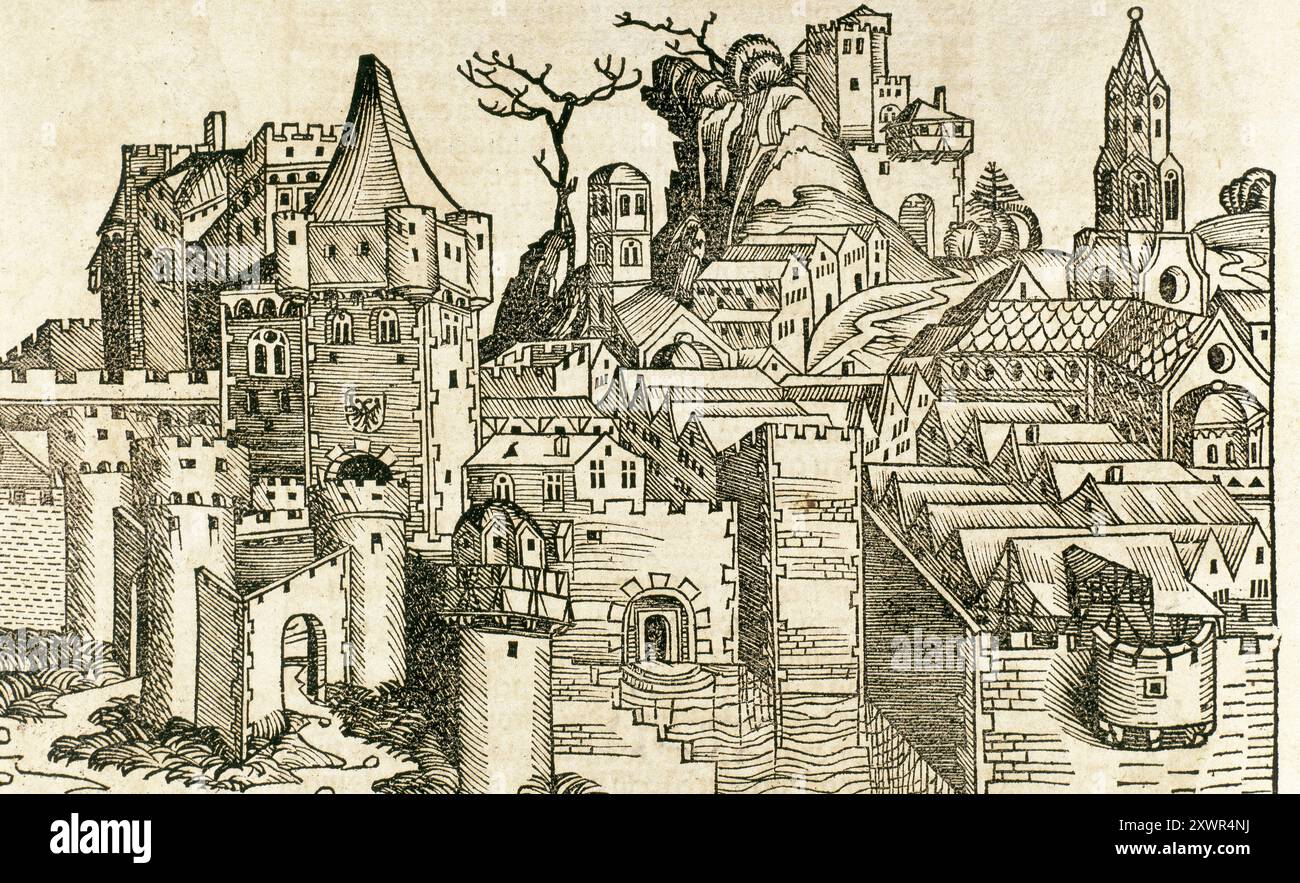 Israel. Tiberias. Hebrew city ordered to be built around the year 20 by king Herod Antipas, as the capital of the Herodian Tetrarchy of Galilee, in honour of the Roman Emperor Tiberius. Liber Chronicarum, by Hartmann Schedel (1440-1514), 1493. Illustrations by Michael Wolgemut (1434-1519) and Wilhelm Pleydenwurff (1460-1494). Engraving. Stock Photohttps://www.alamy.com/image-license-details/?v=1https://www.alamy.com/israel-tiberias-hebrew-city-ordered-to-be-built-around-the-year-20-by-king-herod-antipas-as-the-capital-of-the-herodian-tetrarchy-of-galilee-in-honour-of-the-roman-emperor-tiberius-liber-chronicarum-by-hartmann-schedel-1440-1514-1493-illustrations-by-michael-wolgemut-1434-1519-and-wilhelm-pleydenwurff-1460-1494-engraving-image618237918.html
Israel. Tiberias. Hebrew city ordered to be built around the year 20 by king Herod Antipas, as the capital of the Herodian Tetrarchy of Galilee, in honour of the Roman Emperor Tiberius. Liber Chronicarum, by Hartmann Schedel (1440-1514), 1493. Illustrations by Michael Wolgemut (1434-1519) and Wilhelm Pleydenwurff (1460-1494). Engraving. Stock Photohttps://www.alamy.com/image-license-details/?v=1https://www.alamy.com/israel-tiberias-hebrew-city-ordered-to-be-built-around-the-year-20-by-king-herod-antipas-as-the-capital-of-the-herodian-tetrarchy-of-galilee-in-honour-of-the-roman-emperor-tiberius-liber-chronicarum-by-hartmann-schedel-1440-1514-1493-illustrations-by-michael-wolgemut-1434-1519-and-wilhelm-pleydenwurff-1460-1494-engraving-image618237918.htmlRM2XWR4NJ–Israel. Tiberias. Hebrew city ordered to be built around the year 20 by king Herod Antipas, as the capital of the Herodian Tetrarchy of Galilee, in honour of the Roman Emperor Tiberius. Liber Chronicarum, by Hartmann Schedel (1440-1514), 1493. Illustrations by Michael Wolgemut (1434-1519) and Wilhelm Pleydenwurff (1460-1494). Engraving.
 A treatise on wood engravings : historical and practical . st is that representing ^ an encounter of two armed men on horseback with the mark .jJJ., which . also occurs in some of the cuts in Gesners History of Animals, printed 414 FURTHER PROGRESS AND DECLINE OF at Zurich, 1551—1558. This cut, as well as several others, is repeatedin another part of the book, in the manner of the Nuremberg Chronicle,where the same portrait or the same view is used to represent severaldifferent persons or places. The cuts are not precisely the same in everyedition of Munsters work, which was several times repr Stock Photohttps://www.alamy.com/image-license-details/?v=1https://www.alamy.com/a-treatise-on-wood-engravings-historical-and-practical-st-is-that-representing-an-encounter-of-two-armed-men-on-horseback-with-the-mark-jjj-which-also-occurs-in-some-of-the-cuts-in-gesners-history-of-animals-printed-414-further-progress-and-decline-of-at-zurich-15511558-this-cut-as-well-as-several-others-is-repeatedin-another-part-of-the-book-in-the-manner-of-the-nuremberg-chroniclewhere-the-same-portrait-or-the-same-view-is-used-to-represent-severaldifferent-persons-or-places-the-cuts-are-not-precisely-the-same-in-everyedition-of-munsters-work-which-was-several-times-repr-image343292964.html
A treatise on wood engravings : historical and practical . st is that representing ^ an encounter of two armed men on horseback with the mark .jJJ., which . also occurs in some of the cuts in Gesners History of Animals, printed 414 FURTHER PROGRESS AND DECLINE OF at Zurich, 1551—1558. This cut, as well as several others, is repeatedin another part of the book, in the manner of the Nuremberg Chronicle,where the same portrait or the same view is used to represent severaldifferent persons or places. The cuts are not precisely the same in everyedition of Munsters work, which was several times repr Stock Photohttps://www.alamy.com/image-license-details/?v=1https://www.alamy.com/a-treatise-on-wood-engravings-historical-and-practical-st-is-that-representing-an-encounter-of-two-armed-men-on-horseback-with-the-mark-jjj-which-also-occurs-in-some-of-the-cuts-in-gesners-history-of-animals-printed-414-further-progress-and-decline-of-at-zurich-15511558-this-cut-as-well-as-several-others-is-repeatedin-another-part-of-the-book-in-the-manner-of-the-nuremberg-chroniclewhere-the-same-portrait-or-the-same-view-is-used-to-represent-severaldifferent-persons-or-places-the-cuts-are-not-precisely-the-same-in-everyedition-of-munsters-work-which-was-several-times-repr-image343292964.htmlRM2AXE9K0–A treatise on wood engravings : historical and practical . st is that representing ^ an encounter of two armed men on horseback with the mark .jJJ., which . also occurs in some of the cuts in Gesners History of Animals, printed 414 FURTHER PROGRESS AND DECLINE OF at Zurich, 1551—1558. This cut, as well as several others, is repeatedin another part of the book, in the manner of the Nuremberg Chronicle,where the same portrait or the same view is used to represent severaldifferent persons or places. The cuts are not precisely the same in everyedition of Munsters work, which was several times repr
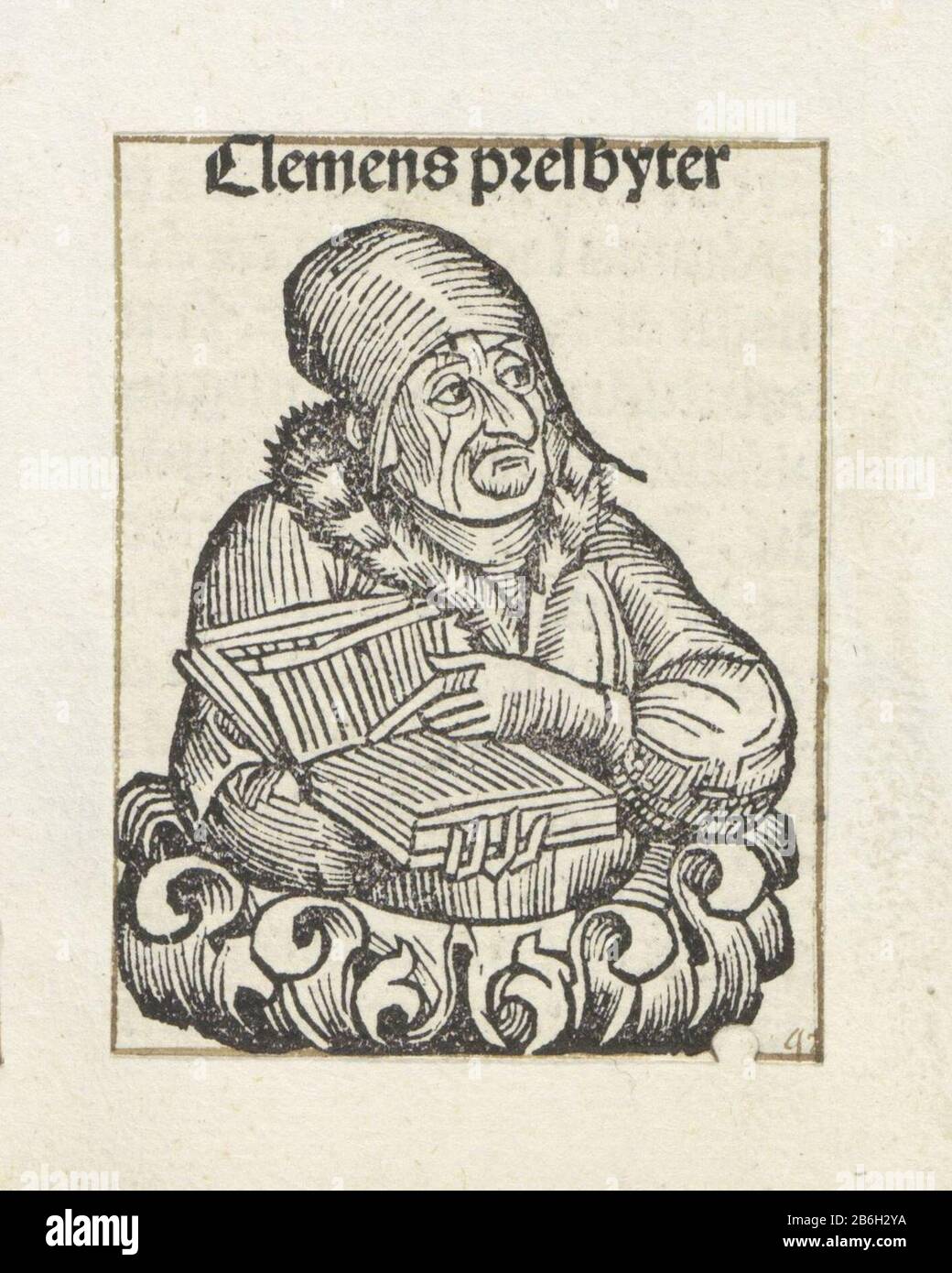 a chalice with a man pointing to a passage in a book. The text identifies him as a Church Father Clement of Alexandria. The print is part of a album. Manufacturer : printmaker Michel Wolgemut (studio) printmaker: Wilhelm Pleydenwurff (workshop) Place manufacture: Nuremberg Date: 1493 Physical features: woodcut pasted on album leaf; text printing; verso with text printing material: paper Technique: letterpress / woodcut / paste dimensions: print: h 74 mm × W 57 mmToelichtingDe woodcut is used frequently as a book illustration in the Liber Chronicarum (or Nuremberg Chronicle) by Hartmann Schedel Stock Photohttps://www.alamy.com/image-license-details/?v=1https://www.alamy.com/a-chalice-with-a-man-pointing-to-a-passage-in-a-book-the-text-identifies-him-as-a-church-father-clement-of-alexandria-the-print-is-part-of-a-album-manufacturer-printmaker-michel-wolgemut-studio-printmaker-wilhelm-pleydenwurff-workshop-place-manufacture-nuremberg-date-1493-physical-features-woodcut-pasted-on-album-leaf-text-printing-verso-with-text-printing-material-paper-technique-letterpress-woodcut-paste-dimensions-print-h-74-mm-w-57-mmtoelichtingde-woodcut-is-used-frequently-as-a-book-illustration-in-the-liber-chronicarum-or-nuremberg-chronicle-by-hartmann-schedel-image348270814.html
a chalice with a man pointing to a passage in a book. The text identifies him as a Church Father Clement of Alexandria. The print is part of a album. Manufacturer : printmaker Michel Wolgemut (studio) printmaker: Wilhelm Pleydenwurff (workshop) Place manufacture: Nuremberg Date: 1493 Physical features: woodcut pasted on album leaf; text printing; verso with text printing material: paper Technique: letterpress / woodcut / paste dimensions: print: h 74 mm × W 57 mmToelichtingDe woodcut is used frequently as a book illustration in the Liber Chronicarum (or Nuremberg Chronicle) by Hartmann Schedel Stock Photohttps://www.alamy.com/image-license-details/?v=1https://www.alamy.com/a-chalice-with-a-man-pointing-to-a-passage-in-a-book-the-text-identifies-him-as-a-church-father-clement-of-alexandria-the-print-is-part-of-a-album-manufacturer-printmaker-michel-wolgemut-studio-printmaker-wilhelm-pleydenwurff-workshop-place-manufacture-nuremberg-date-1493-physical-features-woodcut-pasted-on-album-leaf-text-printing-verso-with-text-printing-material-paper-technique-letterpress-woodcut-paste-dimensions-print-h-74-mm-w-57-mmtoelichtingde-woodcut-is-used-frequently-as-a-book-illustration-in-the-liber-chronicarum-or-nuremberg-chronicle-by-hartmann-schedel-image348270814.htmlRM2B6H2YA–a chalice with a man pointing to a passage in a book. The text identifies him as a Church Father Clement of Alexandria. The print is part of a album. Manufacturer : printmaker Michel Wolgemut (studio) printmaker: Wilhelm Pleydenwurff (workshop) Place manufacture: Nuremberg Date: 1493 Physical features: woodcut pasted on album leaf; text printing; verso with text printing material: paper Technique: letterpress / woodcut / paste dimensions: print: h 74 mm × W 57 mmToelichtingDe woodcut is used frequently as a book illustration in the Liber Chronicarum (or Nuremberg Chronicle) by Hartmann Schedel
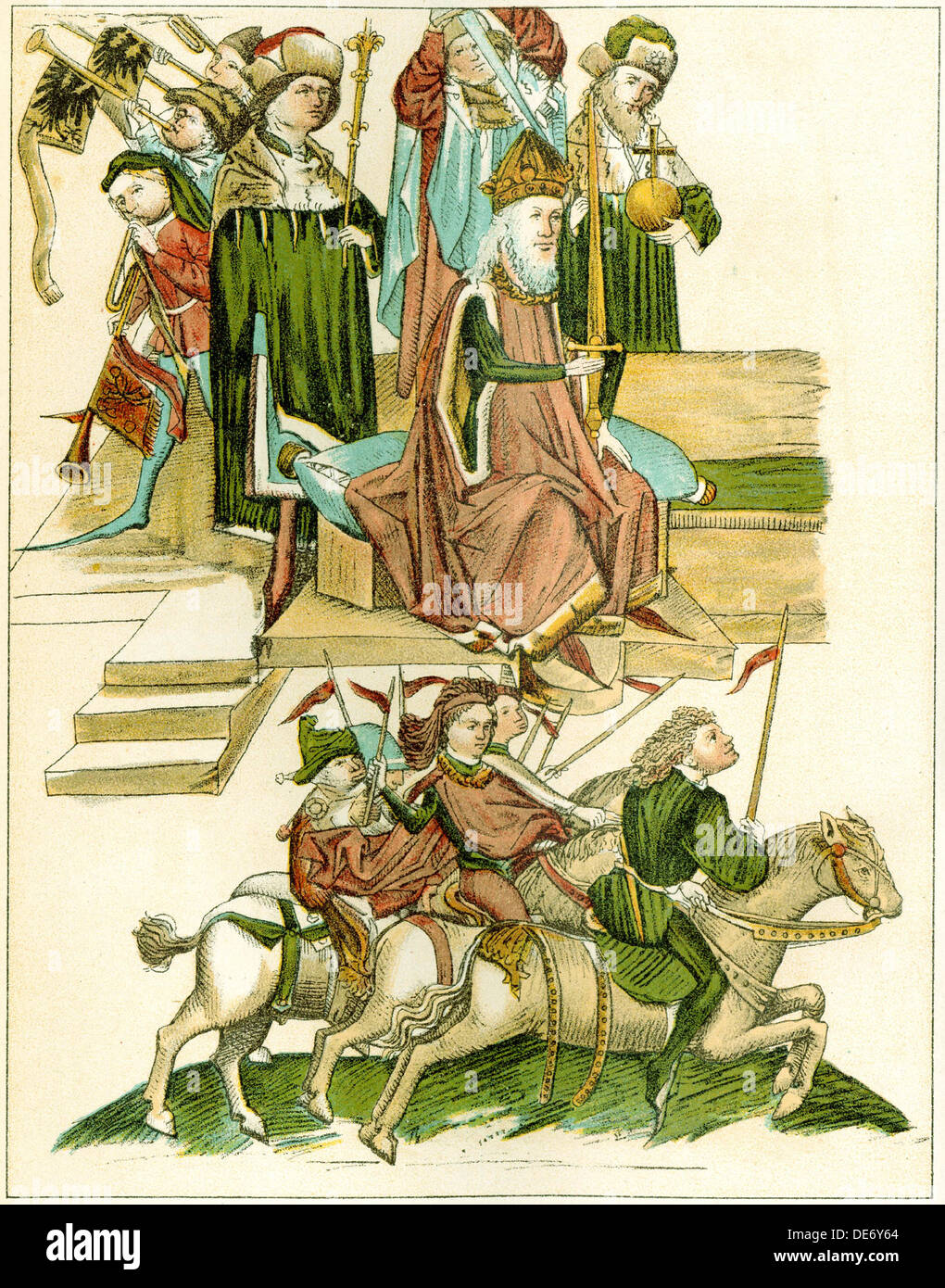 Frederick I receives Brandenburg (Copy of an Illustration from the Richental's illustrated chronicle), c. 1440. Artist: Anonymous Stock Photohttps://www.alamy.com/image-license-details/?v=1https://www.alamy.com/frederick-i-receives-brandenburg-copy-of-an-illustration-from-the-image60389340.html
Frederick I receives Brandenburg (Copy of an Illustration from the Richental's illustrated chronicle), c. 1440. Artist: Anonymous Stock Photohttps://www.alamy.com/image-license-details/?v=1https://www.alamy.com/frederick-i-receives-brandenburg-copy-of-an-illustration-from-the-image60389340.htmlRMDE6Y64–Frederick I receives Brandenburg (Copy of an Illustration from the Richental's illustrated chronicle), c. 1440. Artist: Anonymous
 Page from the Nuremberg Chronicle of Schedel, Folio 135R, Michel Wolgemut (workshop of), 1493 print Page from the Nuremberg Chronicle of Hartmann Schedel with the Sacred Hieronymus in his study, Pelagius, Johannes Chrysostomus, Saint Paula van Rome, Alexius of Edessa and Johannes Cassianus. Numbered at the top right: CXXXV. paper letterpress printing the monk and hermit Jerome (Hieronymus); possible attributes: book, cardinal's hat, crucifix, hour-glass, lion, skull, stone. saints. male persons from classical history Stock Photohttps://www.alamy.com/image-license-details/?v=1https://www.alamy.com/page-from-the-nuremberg-chronicle-of-schedel-folio-135r-michel-wolgemut-workshop-of-1493-print-page-from-the-nuremberg-chronicle-of-hartmann-schedel-with-the-sacred-hieronymus-in-his-study-pelagius-johannes-chrysostomus-saint-paula-van-rome-alexius-of-edessa-and-johannes-cassianus-numbered-at-the-top-right-cxxxv-paper-letterpress-printing-the-monk-and-hermit-jerome-hieronymus-possible-attributes-book-cardinals-hat-crucifix-hour-glass-lion-skull-stone-saints-male-persons-from-classical-history-image594261765.html
Page from the Nuremberg Chronicle of Schedel, Folio 135R, Michel Wolgemut (workshop of), 1493 print Page from the Nuremberg Chronicle of Hartmann Schedel with the Sacred Hieronymus in his study, Pelagius, Johannes Chrysostomus, Saint Paula van Rome, Alexius of Edessa and Johannes Cassianus. Numbered at the top right: CXXXV. paper letterpress printing the monk and hermit Jerome (Hieronymus); possible attributes: book, cardinal's hat, crucifix, hour-glass, lion, skull, stone. saints. male persons from classical history Stock Photohttps://www.alamy.com/image-license-details/?v=1https://www.alamy.com/page-from-the-nuremberg-chronicle-of-schedel-folio-135r-michel-wolgemut-workshop-of-1493-print-page-from-the-nuremberg-chronicle-of-hartmann-schedel-with-the-sacred-hieronymus-in-his-study-pelagius-johannes-chrysostomus-saint-paula-van-rome-alexius-of-edessa-and-johannes-cassianus-numbered-at-the-top-right-cxxxv-paper-letterpress-printing-the-monk-and-hermit-jerome-hieronymus-possible-attributes-book-cardinals-hat-crucifix-hour-glass-lion-skull-stone-saints-male-persons-from-classical-history-image594261765.htmlRM2WEPXXD–Page from the Nuremberg Chronicle of Schedel, Folio 135R, Michel Wolgemut (workshop of), 1493 print Page from the Nuremberg Chronicle of Hartmann Schedel with the Sacred Hieronymus in his study, Pelagius, Johannes Chrysostomus, Saint Paula van Rome, Alexius of Edessa and Johannes Cassianus. Numbered at the top right: CXXXV. paper letterpress printing the monk and hermit Jerome (Hieronymus); possible attributes: book, cardinal's hat, crucifix, hour-glass, lion, skull, stone. saints. male persons from classical history
 Illuminated Manuscript, Bible (part), Moses explaining the Law to two Israelites, This large-scale manuscript contains the first eight Old Testament books, Genesis through Ruth. The date of completion is given, February 2, 1507. The illumination of the Creation within a cosmographic scheme is based in part on the woodcut illustrations of Creation in the 1483 Koberger Bible, and the 1493 Nuremberg Chronicle by the same printer. Large historiated initials mark the beginning of each book Stock Photohttps://www.alamy.com/image-license-details/?v=1https://www.alamy.com/illuminated-manuscript-bible-part-moses-explaining-the-law-to-two-israelites-this-large-scale-manuscript-contains-the-first-eight-old-testament-books-genesis-through-ruth-the-date-of-completion-is-given-february-2-1507-the-illumination-of-the-creation-within-a-cosmographic-scheme-is-based-in-part-on-the-woodcut-illustrations-of-creation-in-the-1483-koberger-bible-and-the-1493-nuremberg-chronicle-by-the-same-printer-large-historiated-initials-mark-the-beginning-of-each-book-image573476051.html
Illuminated Manuscript, Bible (part), Moses explaining the Law to two Israelites, This large-scale manuscript contains the first eight Old Testament books, Genesis through Ruth. The date of completion is given, February 2, 1507. The illumination of the Creation within a cosmographic scheme is based in part on the woodcut illustrations of Creation in the 1483 Koberger Bible, and the 1493 Nuremberg Chronicle by the same printer. Large historiated initials mark the beginning of each book Stock Photohttps://www.alamy.com/image-license-details/?v=1https://www.alamy.com/illuminated-manuscript-bible-part-moses-explaining-the-law-to-two-israelites-this-large-scale-manuscript-contains-the-first-eight-old-testament-books-genesis-through-ruth-the-date-of-completion-is-given-february-2-1507-the-illumination-of-the-creation-within-a-cosmographic-scheme-is-based-in-part-on-the-woodcut-illustrations-of-creation-in-the-1483-koberger-bible-and-the-1493-nuremberg-chronicle-by-the-same-printer-large-historiated-initials-mark-the-beginning-of-each-book-image573476051.htmlRM2T902FF–Illuminated Manuscript, Bible (part), Moses explaining the Law to two Israelites, This large-scale manuscript contains the first eight Old Testament books, Genesis through Ruth. The date of completion is given, February 2, 1507. The illumination of the Creation within a cosmographic scheme is based in part on the woodcut illustrations of Creation in the 1483 Koberger Bible, and the 1493 Nuremberg Chronicle by the same printer. Large historiated initials mark the beginning of each book
 Liber chronicarum by Hartmann Schedel. Engraving depicting the city of Alexandria. 15th century. Stock Photohttps://www.alamy.com/image-license-details/?v=1https://www.alamy.com/stock-photo-liber-chronicarum-by-hartmann-schedel-engraving-depicting-the-city-52853884.html
Liber chronicarum by Hartmann Schedel. Engraving depicting the city of Alexandria. 15th century. Stock Photohttps://www.alamy.com/image-license-details/?v=1https://www.alamy.com/stock-photo-liber-chronicarum-by-hartmann-schedel-engraving-depicting-the-city-52853884.htmlRMD1YKJM–Liber chronicarum by Hartmann Schedel. Engraving depicting the city of Alexandria. 15th century.
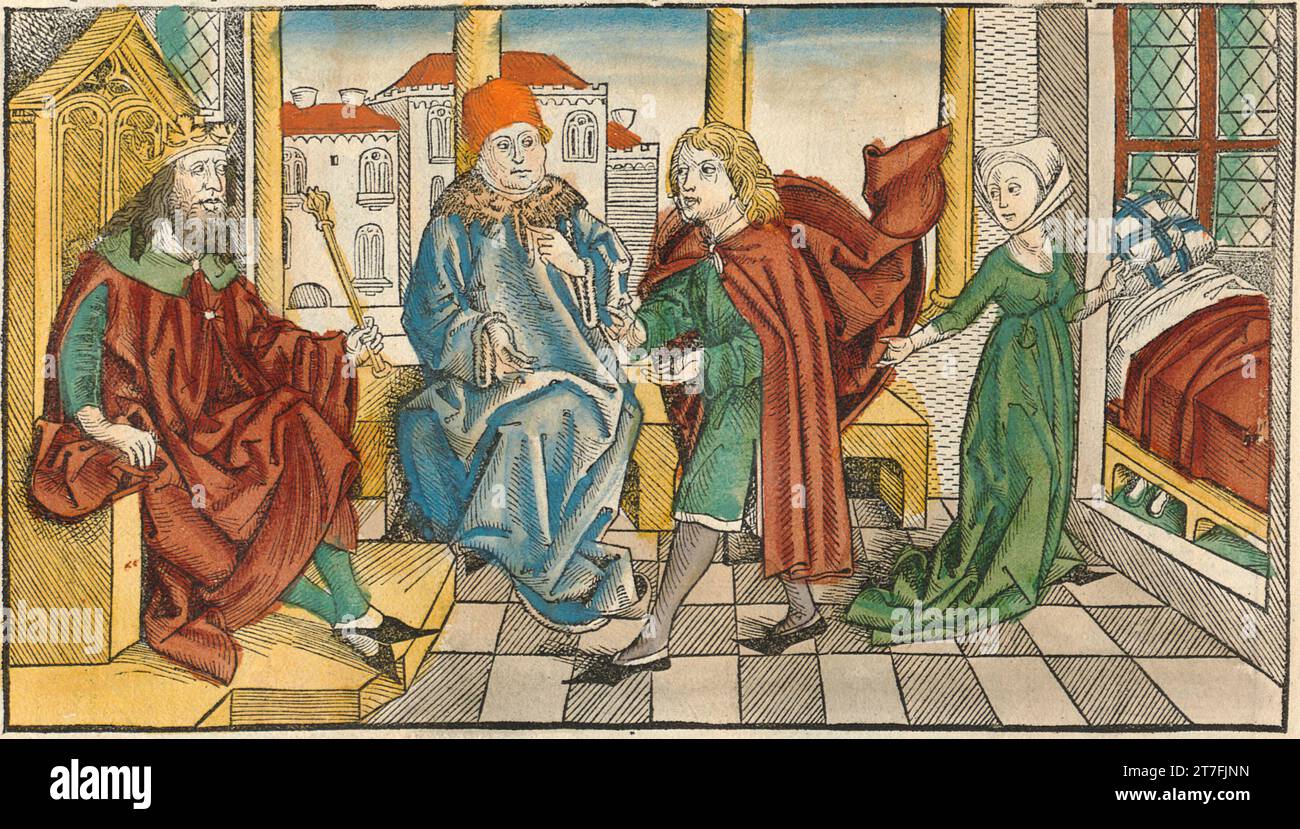 Depiction of Medieval Court - Illustration from The Nuremberg Chronicle, 1493. Illustrated by Wilhelm Pleydenwurff and Michael Wolgemut Stock Photohttps://www.alamy.com/image-license-details/?v=1https://www.alamy.com/depiction-of-medieval-court-illustration-from-the-nuremberg-chronicle-1493-illustrated-by-wilhelm-pleydenwurff-and-michael-wolgemut-image572588737.html
Depiction of Medieval Court - Illustration from The Nuremberg Chronicle, 1493. Illustrated by Wilhelm Pleydenwurff and Michael Wolgemut Stock Photohttps://www.alamy.com/image-license-details/?v=1https://www.alamy.com/depiction-of-medieval-court-illustration-from-the-nuremberg-chronicle-1493-illustrated-by-wilhelm-pleydenwurff-and-michael-wolgemut-image572588737.htmlRF2T7FJNN–Depiction of Medieval Court - Illustration from The Nuremberg Chronicle, 1493. Illustrated by Wilhelm Pleydenwurff and Michael Wolgemut
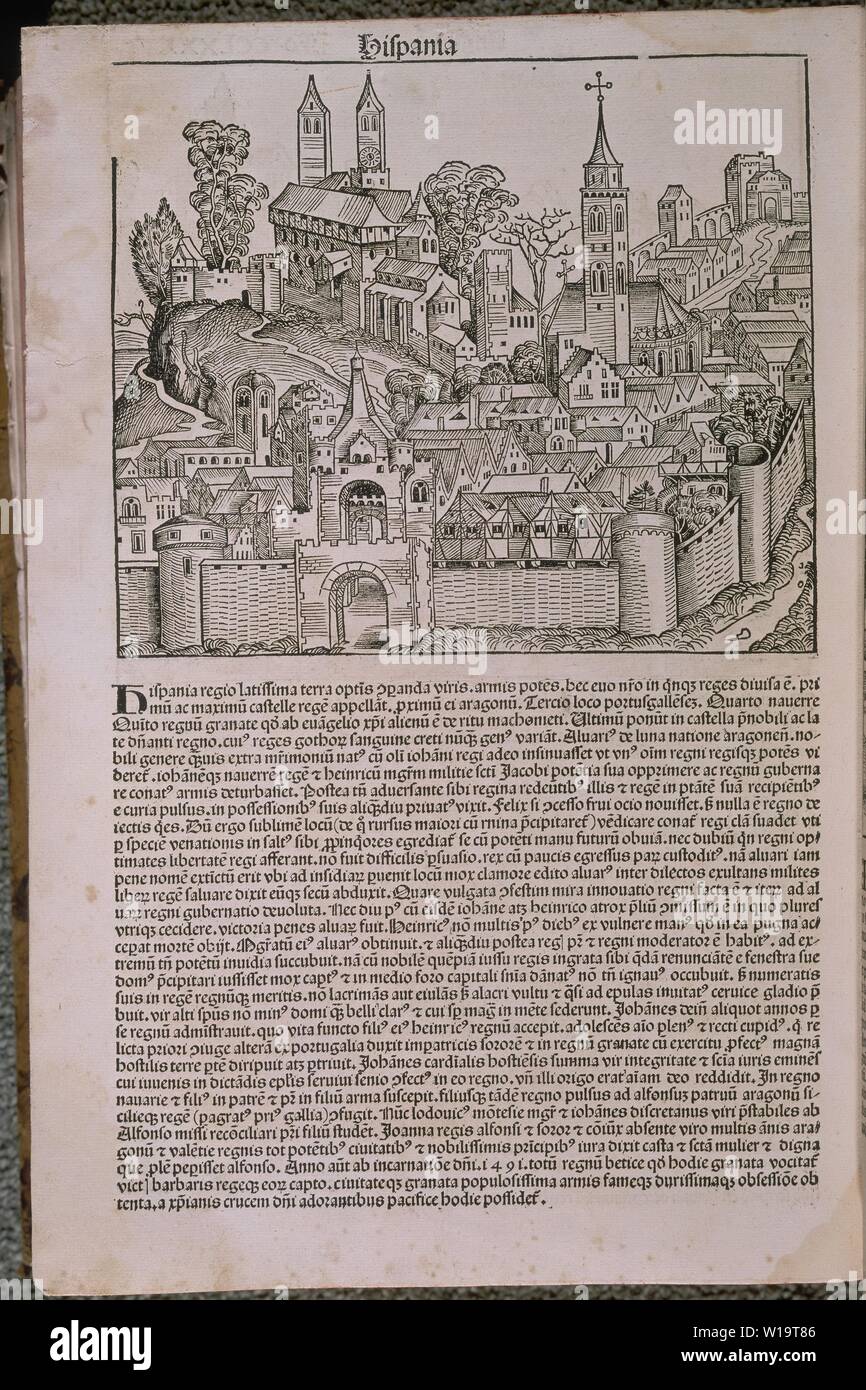 HISPANIA - PAGINA DEL LIBER CHRONICARUM O CRONICA DE NUREMBERG - IMPRESO EN 1493 - INCUNABLE. Author: HARTMANN SCHEDEL. Location: SENADO-BIBLIOTECA-COLECCION. MADRID. Stock Photohttps://www.alamy.com/image-license-details/?v=1https://www.alamy.com/hispania-pagina-del-liber-chronicarum-o-cronica-de-nuremberg-impreso-en-1493-incunable-author-hartmann-schedel-location-senado-biblioteca-coleccion-madrid-image258986790.html
HISPANIA - PAGINA DEL LIBER CHRONICARUM O CRONICA DE NUREMBERG - IMPRESO EN 1493 - INCUNABLE. Author: HARTMANN SCHEDEL. Location: SENADO-BIBLIOTECA-COLECCION. MADRID. Stock Photohttps://www.alamy.com/image-license-details/?v=1https://www.alamy.com/hispania-pagina-del-liber-chronicarum-o-cronica-de-nuremberg-impreso-en-1493-incunable-author-hartmann-schedel-location-senado-biblioteca-coleccion-madrid-image258986790.htmlRMW19T86–HISPANIA - PAGINA DEL LIBER CHRONICARUM O CRONICA DE NUREMBERG - IMPRESO EN 1493 - INCUNABLE. Author: HARTMANN SCHEDEL. Location: SENADO-BIBLIOTECA-COLECCION. MADRID.
 St Thomas Aquinas (c1225-74) Italian philosopher and theologian. Joined Dominican order (Black friars), studied under Albertus Magnus. Wrote commentaries on Aristotle. Concept of Just War. Here with halo, holding an open book, and Dove of the Holy Spirit on his shoulder 1493 Hand-coloured woodcut from Hartmann Schedel 'Liber chronicarum mundi' (Nuremberg Chronicle) Nuremberg Stock Photohttps://www.alamy.com/image-license-details/?v=1https://www.alamy.com/st-thomas-aquinas-c1225-74-italian-philosopher-and-theologian-joined-dominican-order-black-friars-studied-under-albertus-magnus-wrote-commentaries-on-aristotle-concept-of-just-war-here-with-halo-holding-an-open-book-and-dove-of-the-holy-spirit-on-his-shoulder-1493-hand-coloured-woodcut-from-hartmann-schedel-liber-chronicarum-mundi-nuremberg-chronicle-nuremberg-image257297703.html
St Thomas Aquinas (c1225-74) Italian philosopher and theologian. Joined Dominican order (Black friars), studied under Albertus Magnus. Wrote commentaries on Aristotle. Concept of Just War. Here with halo, holding an open book, and Dove of the Holy Spirit on his shoulder 1493 Hand-coloured woodcut from Hartmann Schedel 'Liber chronicarum mundi' (Nuremberg Chronicle) Nuremberg Stock Photohttps://www.alamy.com/image-license-details/?v=1https://www.alamy.com/st-thomas-aquinas-c1225-74-italian-philosopher-and-theologian-joined-dominican-order-black-friars-studied-under-albertus-magnus-wrote-commentaries-on-aristotle-concept-of-just-war-here-with-halo-holding-an-open-book-and-dove-of-the-holy-spirit-on-his-shoulder-1493-hand-coloured-woodcut-from-hartmann-schedel-liber-chronicarum-mundi-nuremberg-chronicle-nuremberg-image257297703.htmlRMTXGWRK–St Thomas Aquinas (c1225-74) Italian philosopher and theologian. Joined Dominican order (Black friars), studied under Albertus Magnus. Wrote commentaries on Aristotle. Concept of Just War. Here with halo, holding an open book, and Dove of the Holy Spirit on his shoulder 1493 Hand-coloured woodcut from Hartmann Schedel 'Liber chronicarum mundi' (Nuremberg Chronicle) Nuremberg
 Toronto, Canada-March 1, 2018: Thomas Fisher Rare Book Library building in the University of Toronto, the largest repository of publicly accessible ra Stock Photohttps://www.alamy.com/image-license-details/?v=1https://www.alamy.com/toronto-canada-march-1-2018-thomas-fisher-rare-book-library-building-in-the-university-of-toronto-the-largest-repository-of-publicly-accessible-ra-image239057866.html
Toronto, Canada-March 1, 2018: Thomas Fisher Rare Book Library building in the University of Toronto, the largest repository of publicly accessible ra Stock Photohttps://www.alamy.com/image-license-details/?v=1https://www.alamy.com/toronto-canada-march-1-2018-thomas-fisher-rare-book-library-building-in-the-university-of-toronto-the-largest-repository-of-publicly-accessible-ra-image239057866.htmlRFRTX0MX–Toronto, Canada-March 1, 2018: Thomas Fisher Rare Book Library building in the University of Toronto, the largest repository of publicly accessible ra
 Posidonius Nuremberg Chronicle Stock Photohttps://www.alamy.com/image-license-details/?v=1https://www.alamy.com/stock-photo-posidonius-nuremberg-chronicle-140364346.html
Posidonius Nuremberg Chronicle Stock Photohttps://www.alamy.com/image-license-details/?v=1https://www.alamy.com/stock-photo-posidonius-nuremberg-chronicle-140364346.htmlRMJ4A44A–Posidonius Nuremberg Chronicle
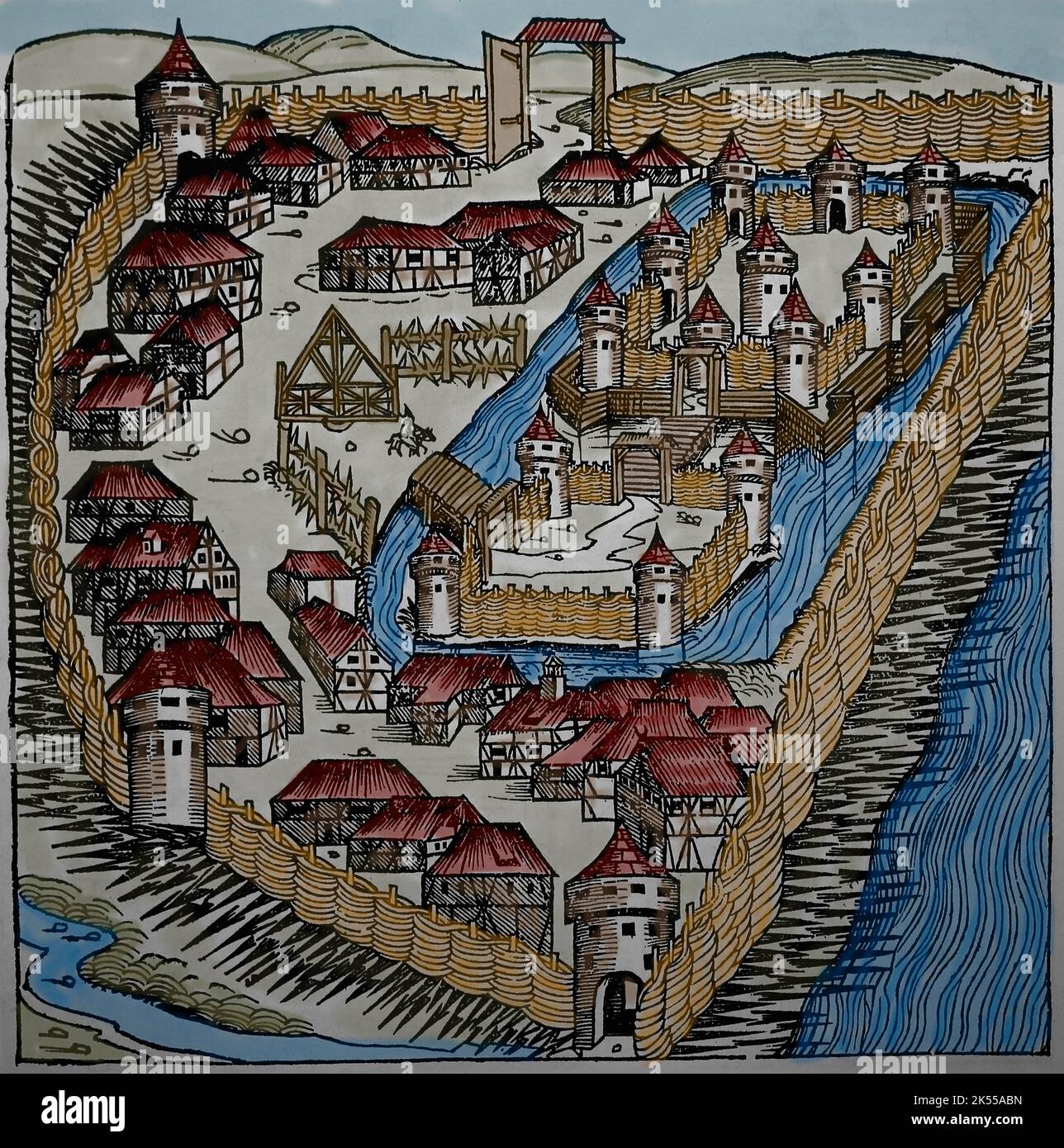 Sabatz (old Zaslon). The Turkish fortress. Engraving by The Nuremberg Chronicle, 15th century. Stock Photohttps://www.alamy.com/image-license-details/?v=1https://www.alamy.com/sabatz-old-zaslon-the-turkish-fortress-engraving-by-the-nuremberg-chronicle-15th-century-image485081513.html
Sabatz (old Zaslon). The Turkish fortress. Engraving by The Nuremberg Chronicle, 15th century. Stock Photohttps://www.alamy.com/image-license-details/?v=1https://www.alamy.com/sabatz-old-zaslon-the-turkish-fortress-engraving-by-the-nuremberg-chronicle-15th-century-image485081513.htmlRM2K55ABN–Sabatz (old Zaslon). The Turkish fortress. Engraving by The Nuremberg Chronicle, 15th century.
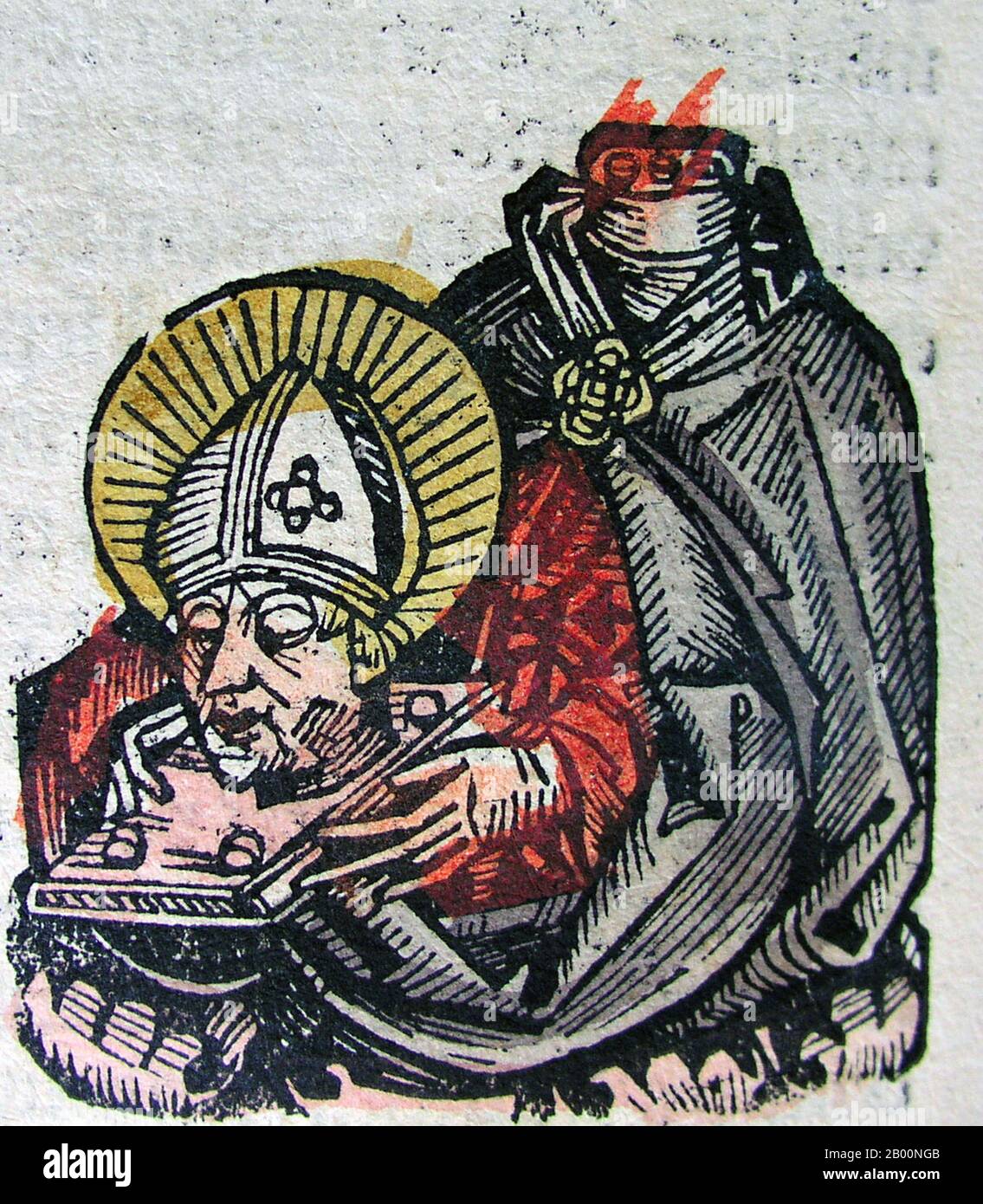 Germany: 'Pseudo-Dionysius the Areopagite'. The Nuremberg Chronicle, by Hartmann Schedel (1440-1514), 1493. The Nuremberg Chronicle is an illustrated world history. Its structure follows the story of human history as related in the Bible, including the histories of a number of important Western cities. Written in Latin by Hartmann Schedel, with a version in German translation by Georg Alt, it appeared in 1493. It is one of the best-documented early printed books, classified as an incunabulum, a book, pamphlet, or broadside that was printed (not handwritten) before the year 1501 in Europe. Stock Photohttps://www.alamy.com/image-license-details/?v=1https://www.alamy.com/germany-pseudo-dionysius-the-areopagite-the-nuremberg-chronicle-by-hartmann-schedel-1440-1514-1493-the-nuremberg-chronicle-is-an-illustrated-world-history-its-structure-follows-the-story-of-human-history-as-related-in-the-bible-including-the-histories-of-a-number-of-important-western-cities-written-in-latin-by-hartmann-schedel-with-a-version-in-german-translation-by-georg-alt-it-appeared-in-1493-it-is-one-of-the-best-documented-early-printed-books-classified-as-an-incunabulum-a-book-pamphlet-or-broadside-that-was-printed-not-handwritten-before-the-year-1501-in-europe-image344224283.html
Germany: 'Pseudo-Dionysius the Areopagite'. The Nuremberg Chronicle, by Hartmann Schedel (1440-1514), 1493. The Nuremberg Chronicle is an illustrated world history. Its structure follows the story of human history as related in the Bible, including the histories of a number of important Western cities. Written in Latin by Hartmann Schedel, with a version in German translation by Georg Alt, it appeared in 1493. It is one of the best-documented early printed books, classified as an incunabulum, a book, pamphlet, or broadside that was printed (not handwritten) before the year 1501 in Europe. Stock Photohttps://www.alamy.com/image-license-details/?v=1https://www.alamy.com/germany-pseudo-dionysius-the-areopagite-the-nuremberg-chronicle-by-hartmann-schedel-1440-1514-1493-the-nuremberg-chronicle-is-an-illustrated-world-history-its-structure-follows-the-story-of-human-history-as-related-in-the-bible-including-the-histories-of-a-number-of-important-western-cities-written-in-latin-by-hartmann-schedel-with-a-version-in-german-translation-by-georg-alt-it-appeared-in-1493-it-is-one-of-the-best-documented-early-printed-books-classified-as-an-incunabulum-a-book-pamphlet-or-broadside-that-was-printed-not-handwritten-before-the-year-1501-in-europe-image344224283.htmlRM2B00NGB–Germany: 'Pseudo-Dionysius the Areopagite'. The Nuremberg Chronicle, by Hartmann Schedel (1440-1514), 1493. The Nuremberg Chronicle is an illustrated world history. Its structure follows the story of human history as related in the Bible, including the histories of a number of important Western cities. Written in Latin by Hartmann Schedel, with a version in German translation by Georg Alt, it appeared in 1493. It is one of the best-documented early printed books, classified as an incunabulum, a book, pamphlet, or broadside that was printed (not handwritten) before the year 1501 in Europe.
 Conjoined Twins, Nuremberg Chronicle, 1493 Stock Photohttps://www.alamy.com/image-license-details/?v=1https://www.alamy.com/stock-photo-conjoined-twins-nuremberg-chronicle-1493-135018133.html
Conjoined Twins, Nuremberg Chronicle, 1493 Stock Photohttps://www.alamy.com/image-license-details/?v=1https://www.alamy.com/stock-photo-conjoined-twins-nuremberg-chronicle-1493-135018133.htmlRMHRJH05–Conjoined Twins, Nuremberg Chronicle, 1493
 Beautiful woodcut pages from the 1493 Nuremberg Chronicle, which is an enyclodpedia of world events, mythology and christian history. This extra-ordinary work was one of the earliest books ever printed and the first to successfully integrate text and images. These pages show latin text and an engraving of the town of Troyes in France Stock Photohttps://www.alamy.com/image-license-details/?v=1https://www.alamy.com/beautiful-woodcut-pages-from-the-1493-nuremberg-chronicle-which-is-an-enyclodpedia-of-world-events-mythology-and-christian-history-this-extra-ordinary-work-was-one-of-the-earliest-books-ever-printed-and-the-first-to-successfully-integrate-text-and-images-these-pages-show-latin-text-and-an-engraving-of-the-town-of-troyes-in-france-image598932445.html
Beautiful woodcut pages from the 1493 Nuremberg Chronicle, which is an enyclodpedia of world events, mythology and christian history. This extra-ordinary work was one of the earliest books ever printed and the first to successfully integrate text and images. These pages show latin text and an engraving of the town of Troyes in France Stock Photohttps://www.alamy.com/image-license-details/?v=1https://www.alamy.com/beautiful-woodcut-pages-from-the-1493-nuremberg-chronicle-which-is-an-enyclodpedia-of-world-events-mythology-and-christian-history-this-extra-ordinary-work-was-one-of-the-earliest-books-ever-printed-and-the-first-to-successfully-integrate-text-and-images-these-pages-show-latin-text-and-an-engraving-of-the-town-of-troyes-in-france-image598932445.htmlRM2WPBMCD–Beautiful woodcut pages from the 1493 Nuremberg Chronicle, which is an enyclodpedia of world events, mythology and christian history. This extra-ordinary work was one of the earliest books ever printed and the first to successfully integrate text and images. These pages show latin text and an engraving of the town of Troyes in France